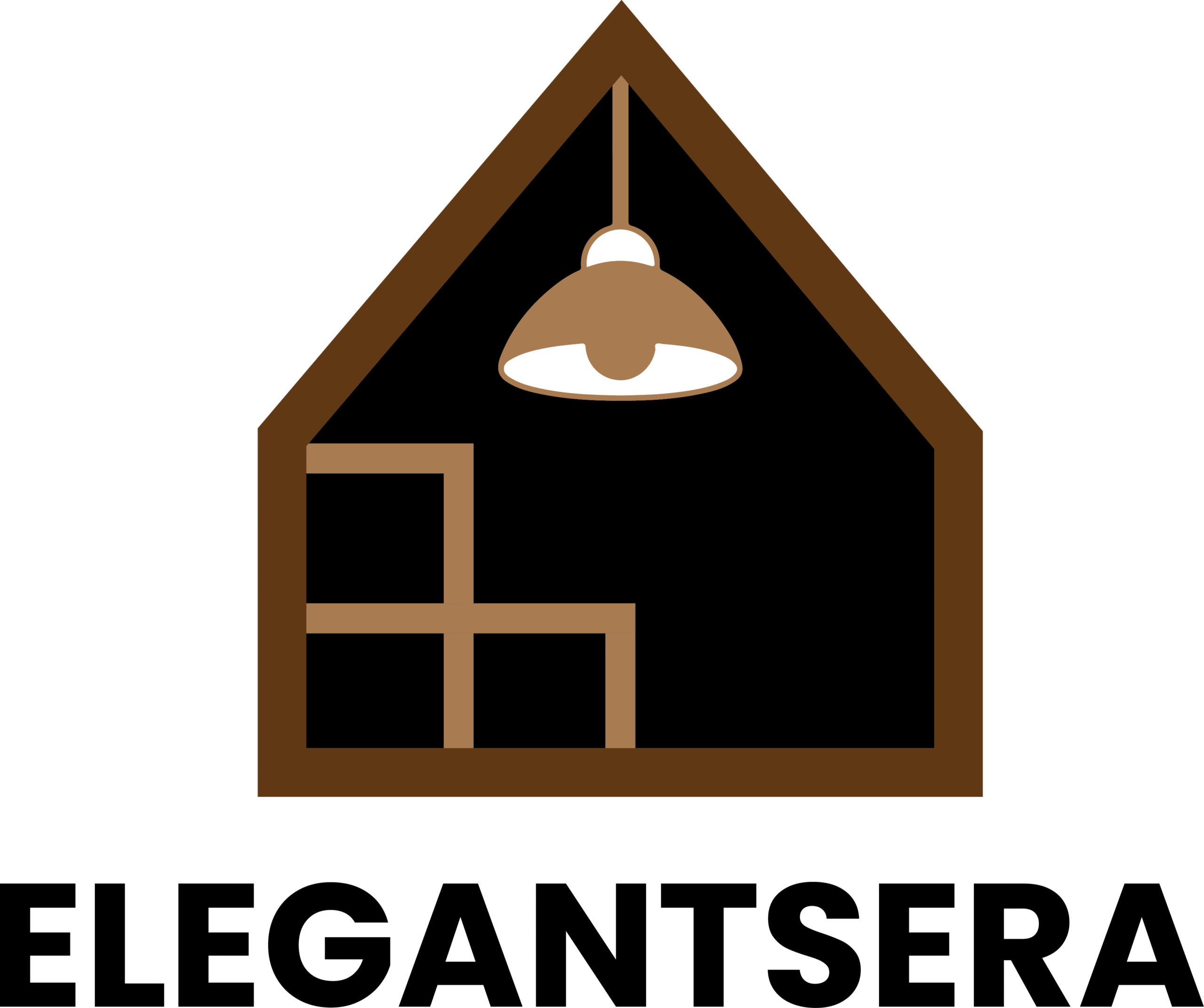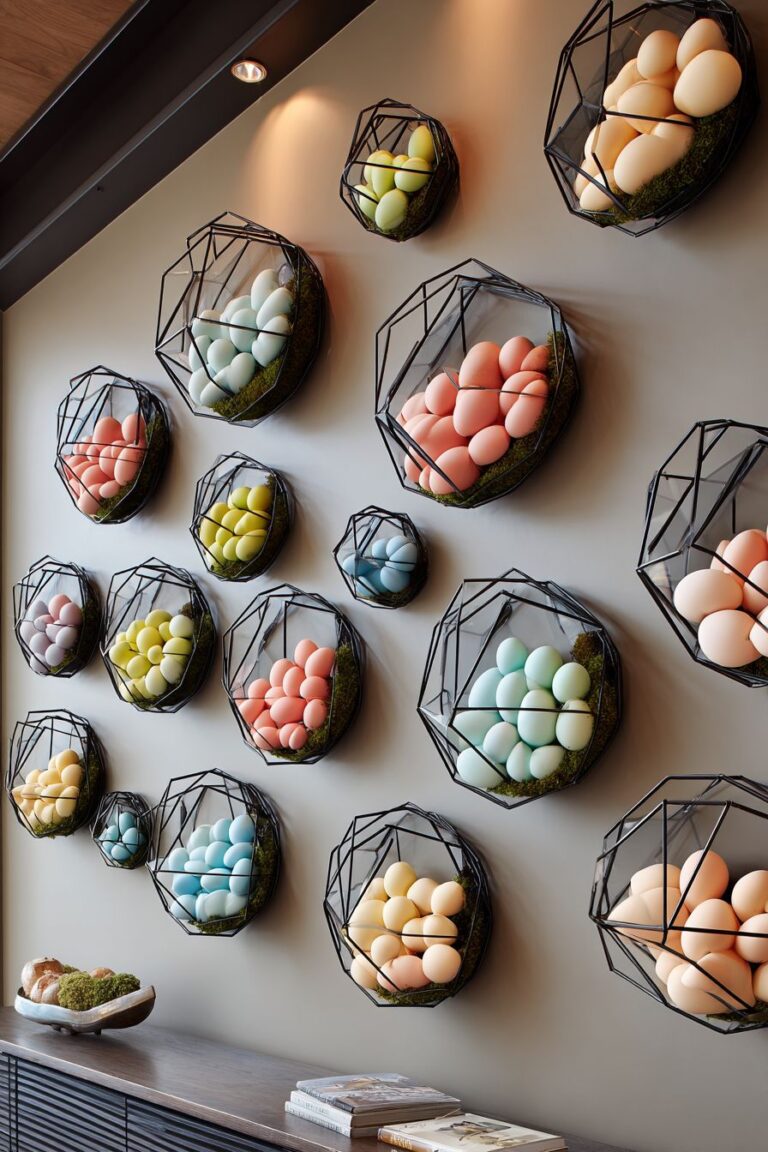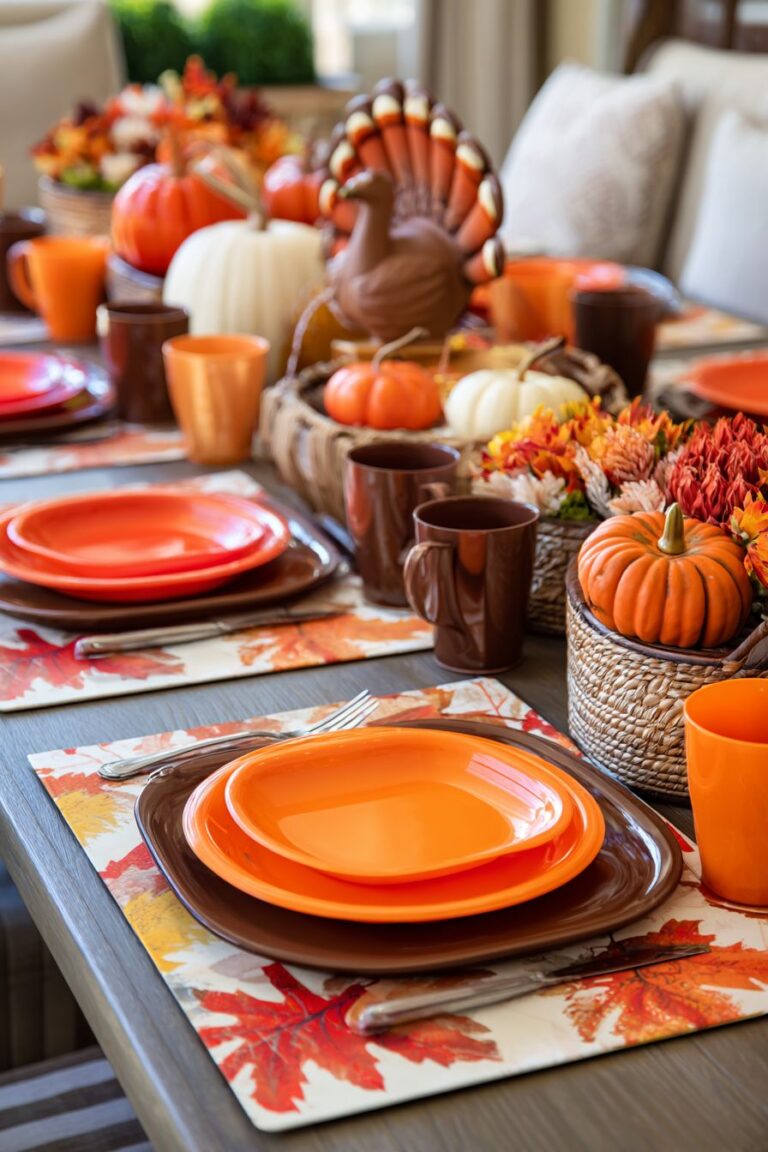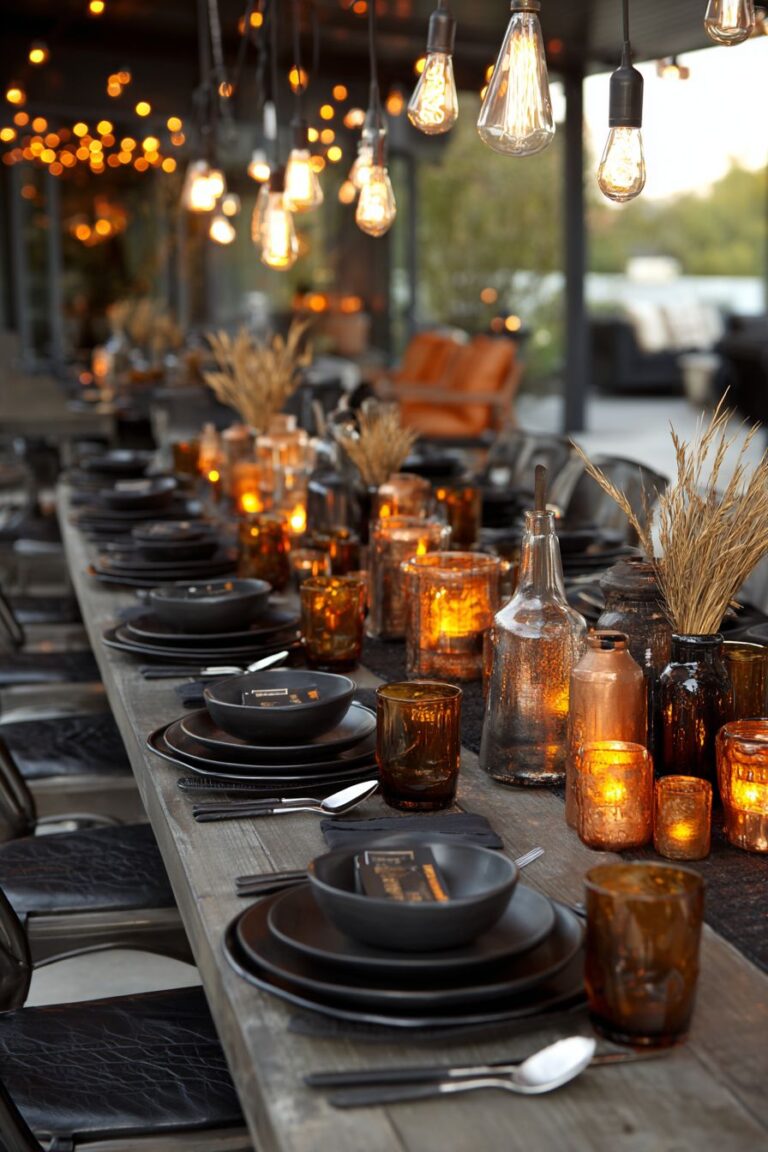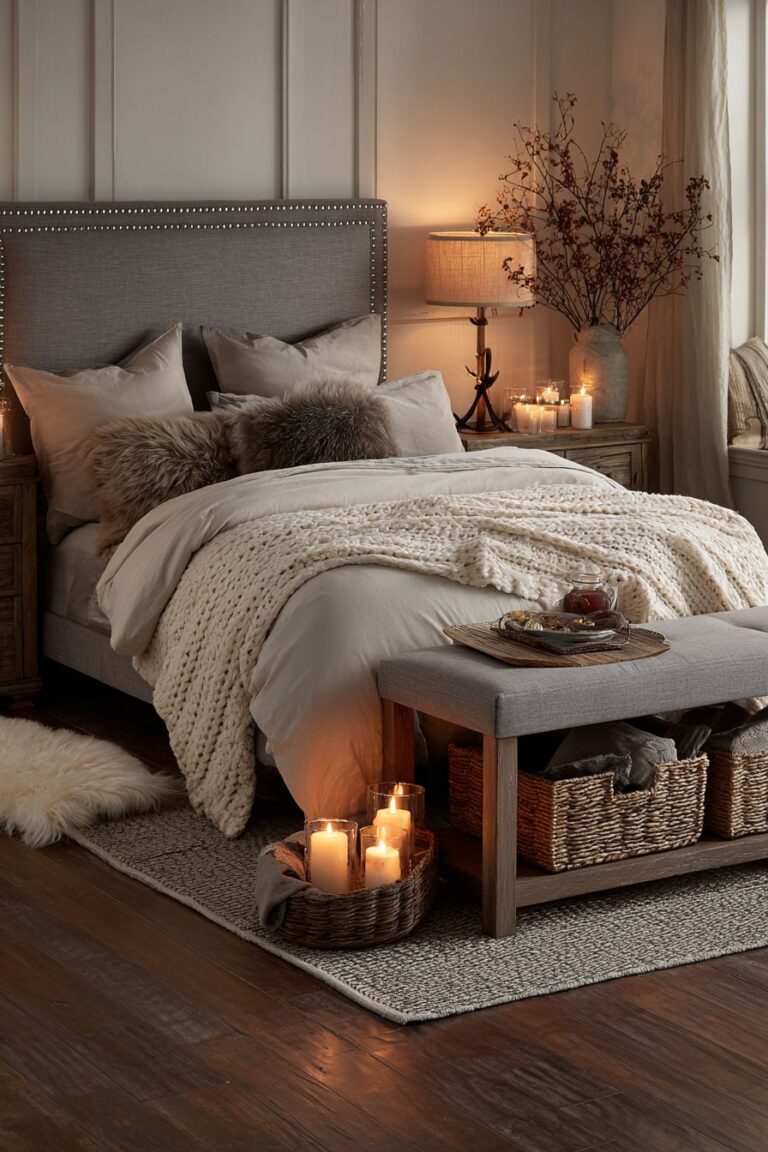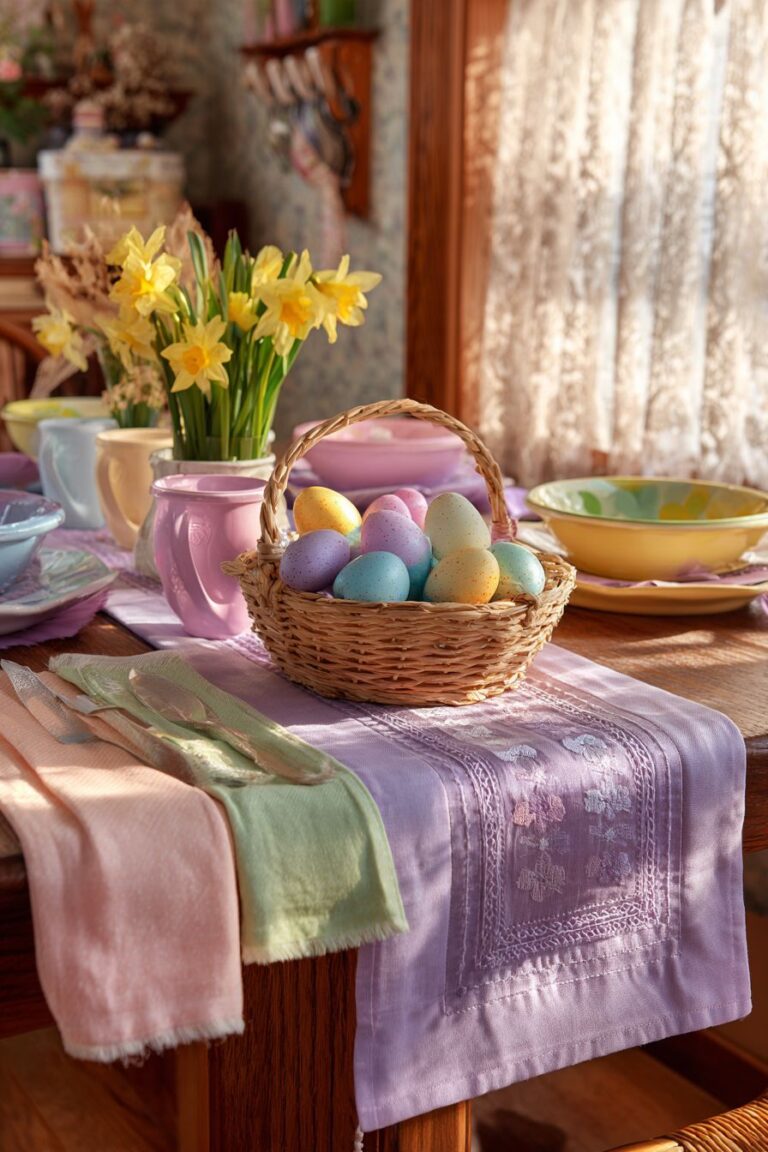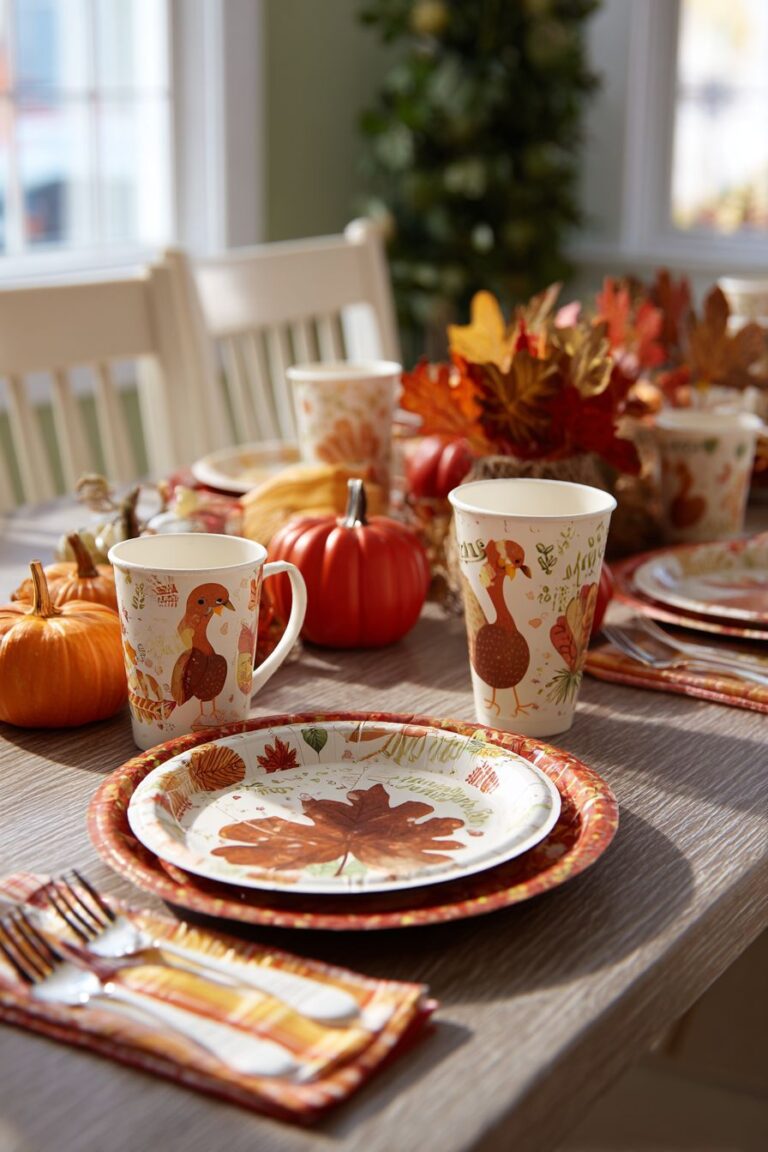17+ Stunning Easter Door Decorations Ideas: Welcome Spring to Your Home
As the gentle warmth of spring begins to unfold and nature awakens from its winter slumber, our homes become canvases for celebrating renewal and joy. The front door, often considered the gateway to our personal sanctuary, offers the perfect opportunity to showcase our creativity and welcome the Easter season with style and grace. Easter door decorations have evolved far beyond simple wreaths, transforming into sophisticated design statements that reflect our personal aesthetic while celebrating the season’s vibrant energy. Whether you’re drawn to rustic farmhouse charm, contemporary minimalism, or traditional elegance, the right door decoration sets the tone for your entire home’s spring transformation.
The beauty of Easter door decorations lies in their versatility and the endless possibilities they offer for self-expression. From handcrafted grapevine wreaths adorned with pastel blooms to sleek geometric designs featuring monochromatic elements, each approach tells a unique story. These decorative pieces serve not only as festive accents but also as reflections of our design sensibilities and the welcoming spirit we wish to convey to guests and passersby. In this comprehensive guide, we’ll explore twenty distinctive Easter door decoration concepts that span various design styles, from cottage-inspired arrangements overflowing with spring flowers to modern interpretations featuring clean lines and sophisticated materials.
Each design we’ll explore offers something special—whether it’s the organic textures of natural materials, the playful charm of whimsical elements, or the refined elegance of carefully curated color palettes. These ideas cater to diverse tastes and home styles, ensuring that every homeowner can find inspiration that resonates with their unique vision. As we journey through these creative concepts, you’ll discover how thoughtful material selection, color coordination, and attention to detail can transform a simple door into a captivating focal point that celebrates the essence of Easter and the beauty of spring.
1. Handcrafted Grapevine Wreath with Pastel Silk Florals
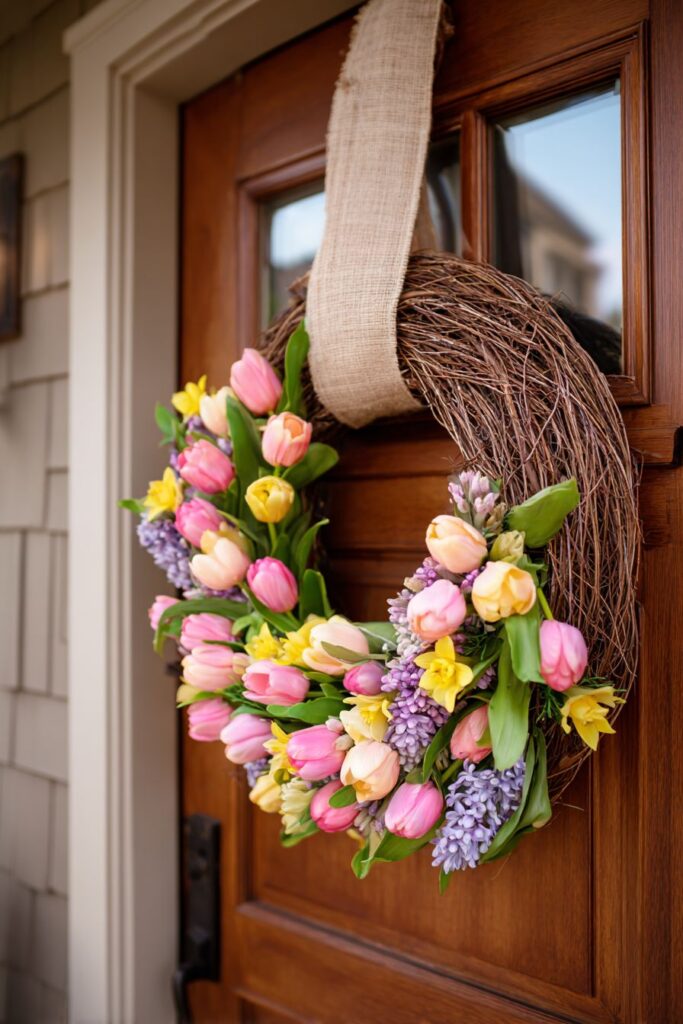
The timeless appeal of a handcrafted grapevine wreath creates an instant connection to traditional Easter celebrations while offering endless possibilities for personalization. This classic foundation, woven from natural grapevines, provides both structural integrity and organic texture that serves as the perfect backdrop for delicate floral elements. When adorned with pastel silk tulips, daffodils, and hyacinths in soft pink, yellow, and lavender tones, the wreath becomes a symphony of spring colors that captures the season’s gentle beauty. The dimensional quality of these carefully selected blooms adds depth and visual interest, while their realistic appearance ensures your decoration maintains its fresh look throughout the entire Easter season.
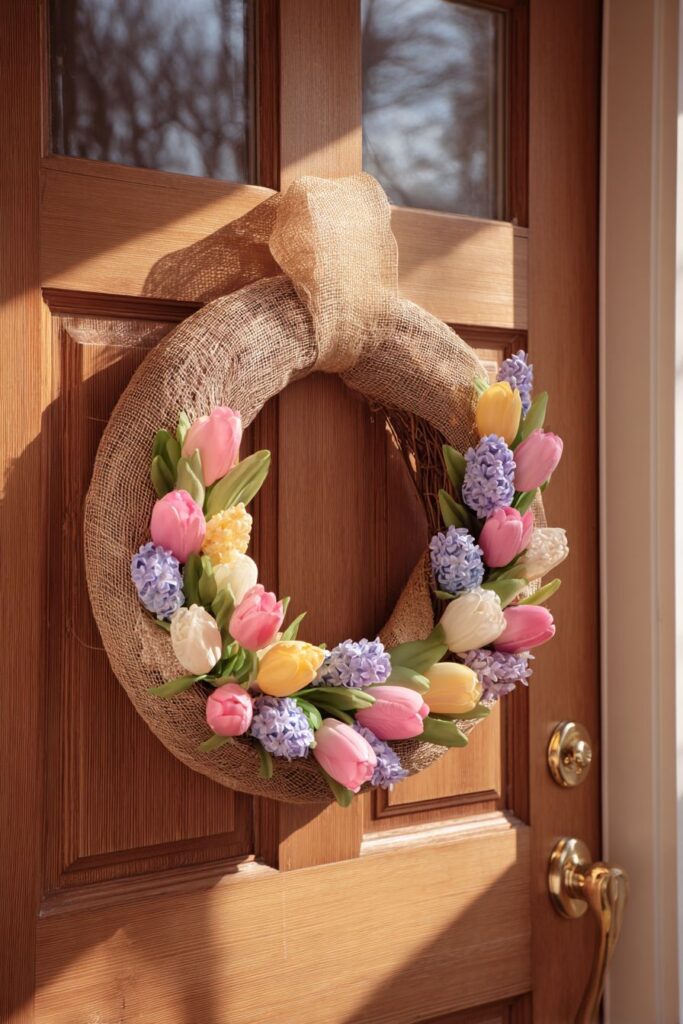
The incorporation of natural burlap ribbon with subtle texture brings an additional layer of rustic sophistication to this design. The ribbon, cascading gracefully from the top of the wreath, creates elegant movement and draws the eye downward, enhancing the overall composition. When displayed against the warm wood tones of a suburban craftsman home’s front door, this decoration creates a harmonious blend of natural elements that feels both welcoming and refined. The interplay between the rough texture of grapevine, the smooth silk petals, and the woven burlap creates a tactile richness that invites closer inspection.
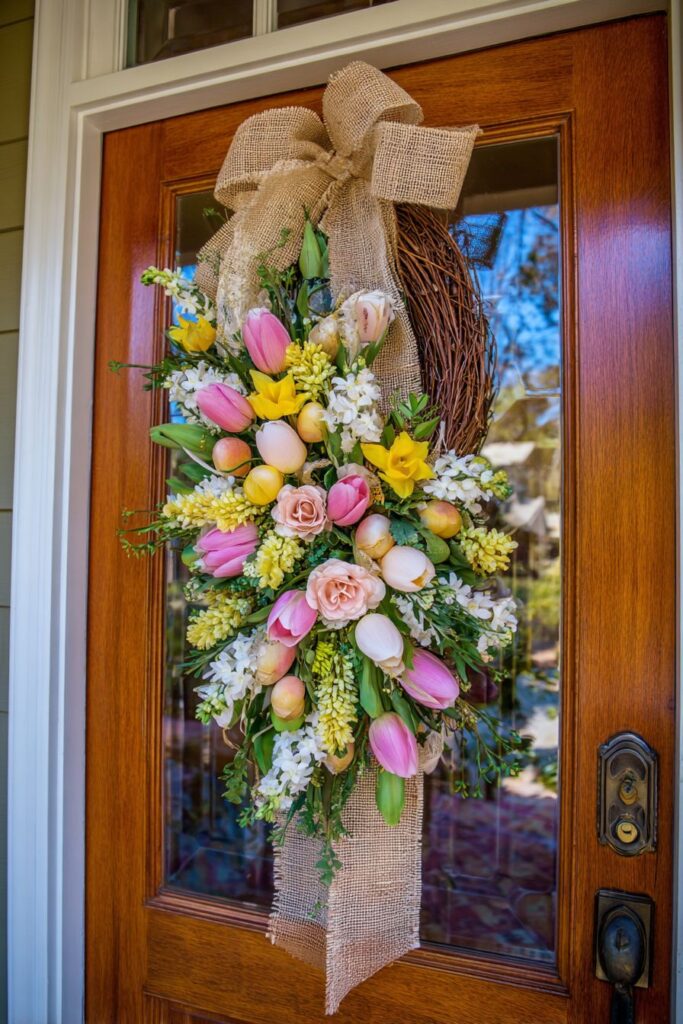
Professional interior designers understand that lighting plays a crucial role in showcasing decorative elements effectively. Soft morning natural light creates gentle shadows that highlight the dimensional floral elements and emphasize the woven texture of the wreath base, bringing the entire composition to life. This careful consideration of how natural light interacts with your decoration ensures it looks stunning throughout the day, from sunrise to sunset.
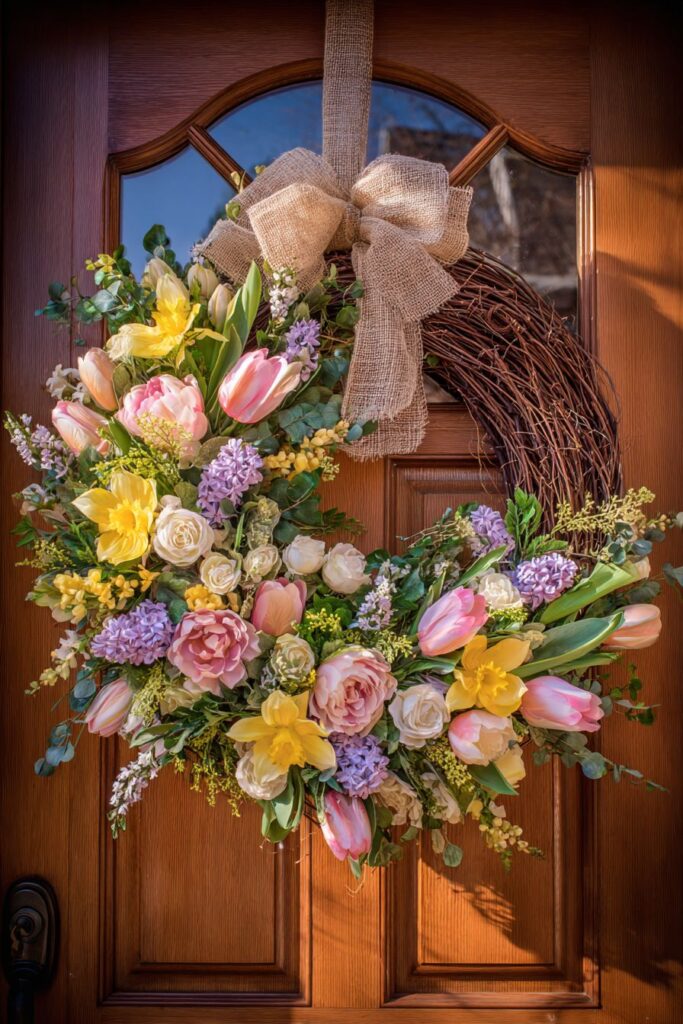
Key Design Tips:
- Select a grapevine wreath with varied twig thickness for added visual texture and authentic handcrafted appeal
- Arrange silk flowers in clusters of odd numbers (3, 5, or 7) to create natural-looking groupings
- Choose burlap ribbon that’s at least 2.5 inches wide for proper visual impact and elegant draping
- Position larger blooms strategically around the wreath to create focal points and guide the eye
- Secure all elements with floral wire hidden behind petals to maintain the illusion of natural growth
2. Modern Farmhouse White-Washed Wooden Egg Garland
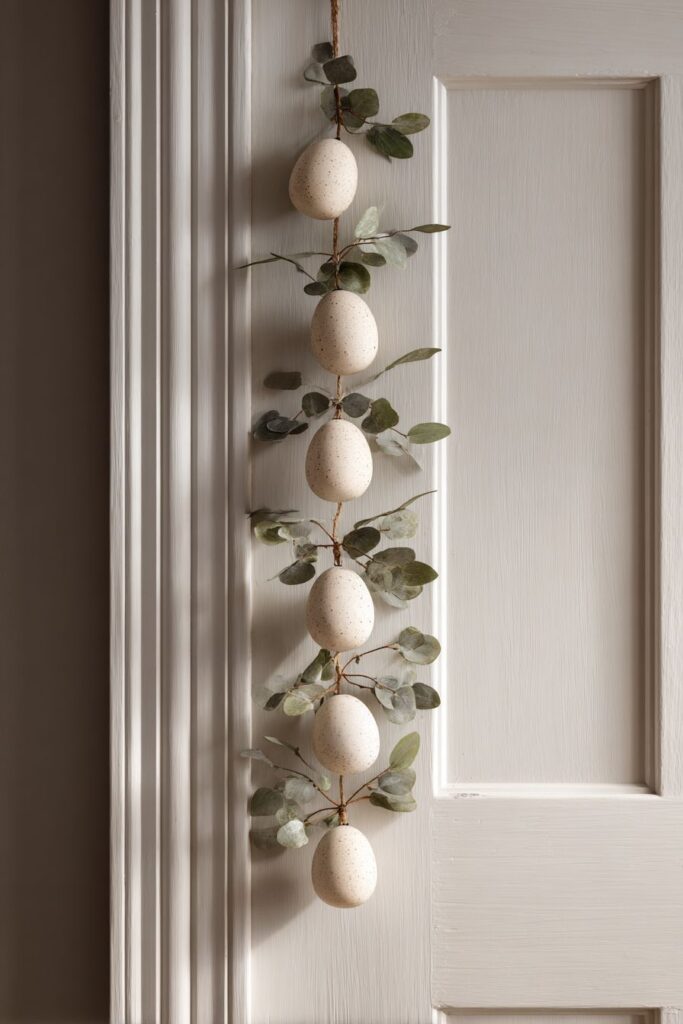
The modern farmhouse aesthetic celebrates the beauty of simplicity, and this minimalist white-washed wooden egg garland perfectly embodies that philosophy. Hanging vertically down the door center, this linear arrangement creates a striking visual element that breaks away from traditional wreath formats while maintaining seasonal relevance. Each wooden egg is carefully painted with white-wash technique, allowing the natural wood grain to subtly show through and adding organic warmth to the clean, contemporary design. The graduated sizing of the eggs, when arranged thoughtfully, creates rhythm and movement that draws the eye from top to bottom, making your entryway feel taller and more elegant.
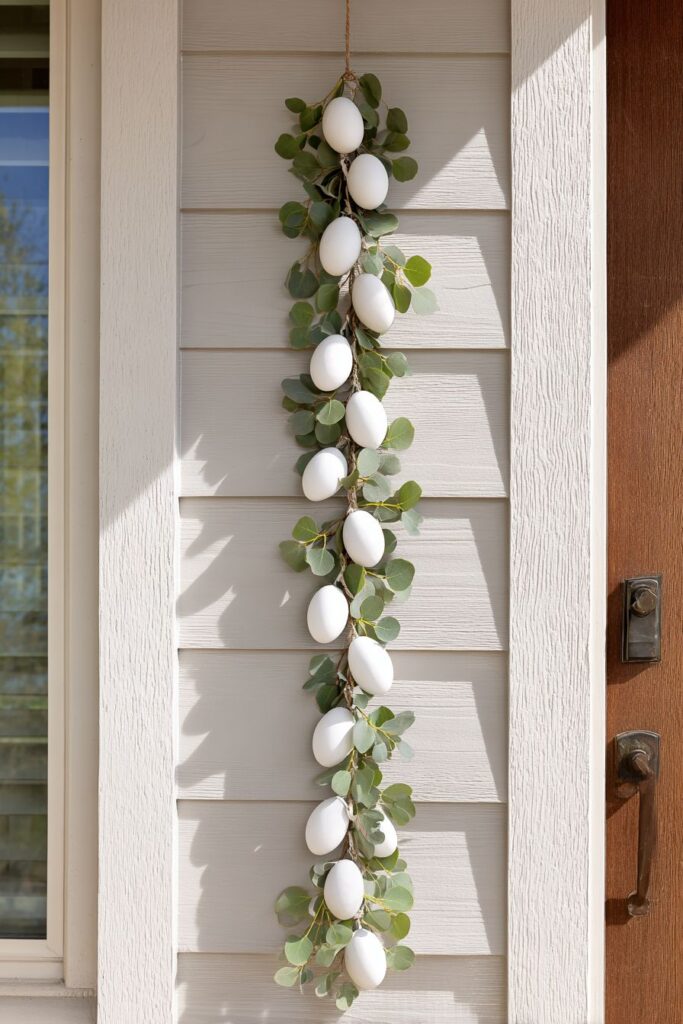
The strategic interspersion of simple eucalyptus sprigs between the painted eggs introduces just enough organic greenery to soften the design without overwhelming its minimalist intent. Eucalyptus, with its silvery-green leaves and pleasant aroma, brings life to the arrangement while maintaining the color palette’s restraint. This careful balance between geometric wooden elements and organic botanical touches exemplifies the modern farmhouse style’s ability to merge contemporary sensibilities with natural warmth. When displayed against a white paneled front door and neutral siding, the decoration achieves a cohesive, sophisticated look that feels intentional yet effortless.
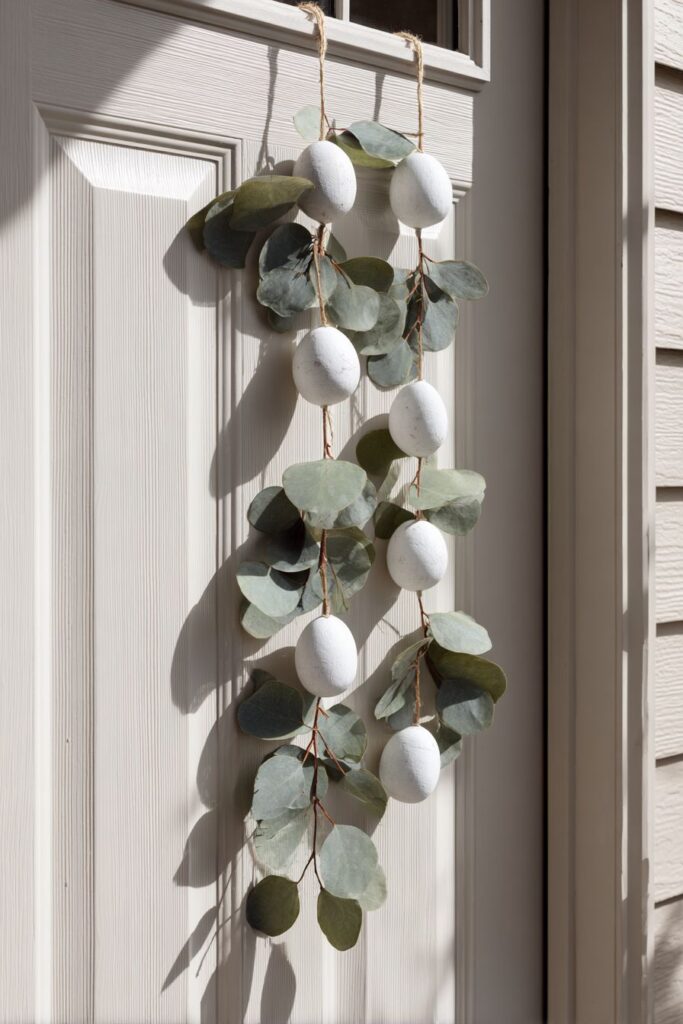
Interior design photography principles teach us that balanced exposure and natural daylight are essential for showcasing clean lines and subtle textures. The wood grain texture of the decorative eggs becomes a focal point when properly illuminated, revealing the craftsmanship and attention to detail that makes this simple design so effective. The contemporary simplicity of this spring display proves that sometimes less truly is more, offering a refreshing alternative to more elaborate Easter decorations.
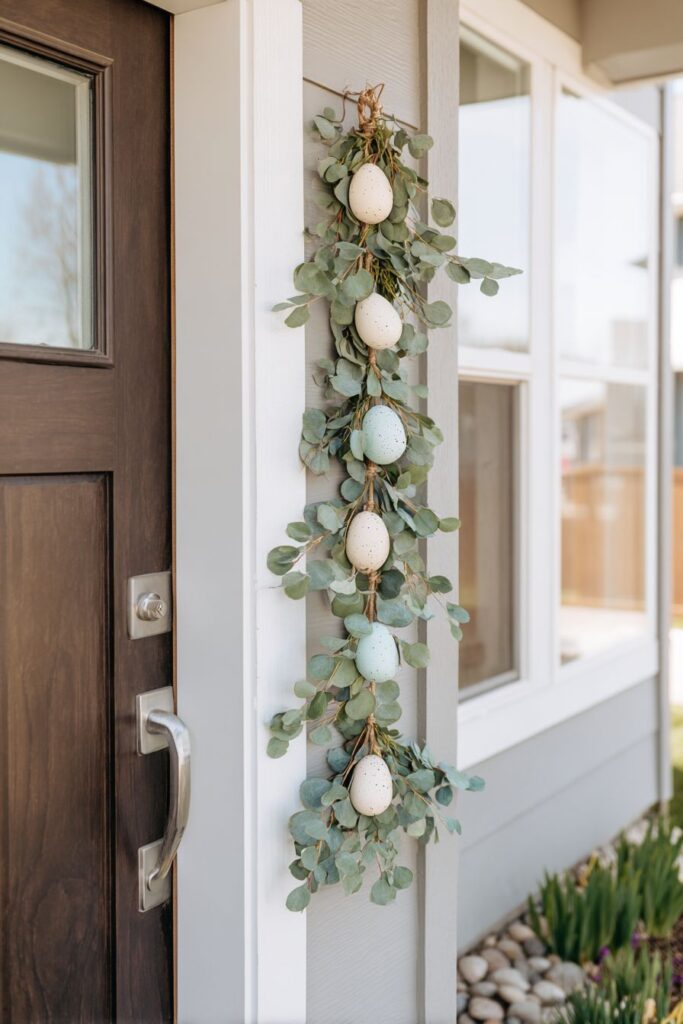
Key Design Tips:
- Use fishing line or thin clear wire to create the illusion that eggs are floating vertically
- Sand wooden eggs lightly before applying white-wash for better paint absorption and texture
- Vary the spacing between eggs gradually, with tighter spacing at the top and looser at the bottom
- Select fresh eucalyptus sprigs of similar size to maintain the design’s clean, uniform appearance
- Seal wooden eggs with matte finish to protect them from weather while preserving their natural look
3. Traditional Pastel Flower Wreath with Ceramic Bunny
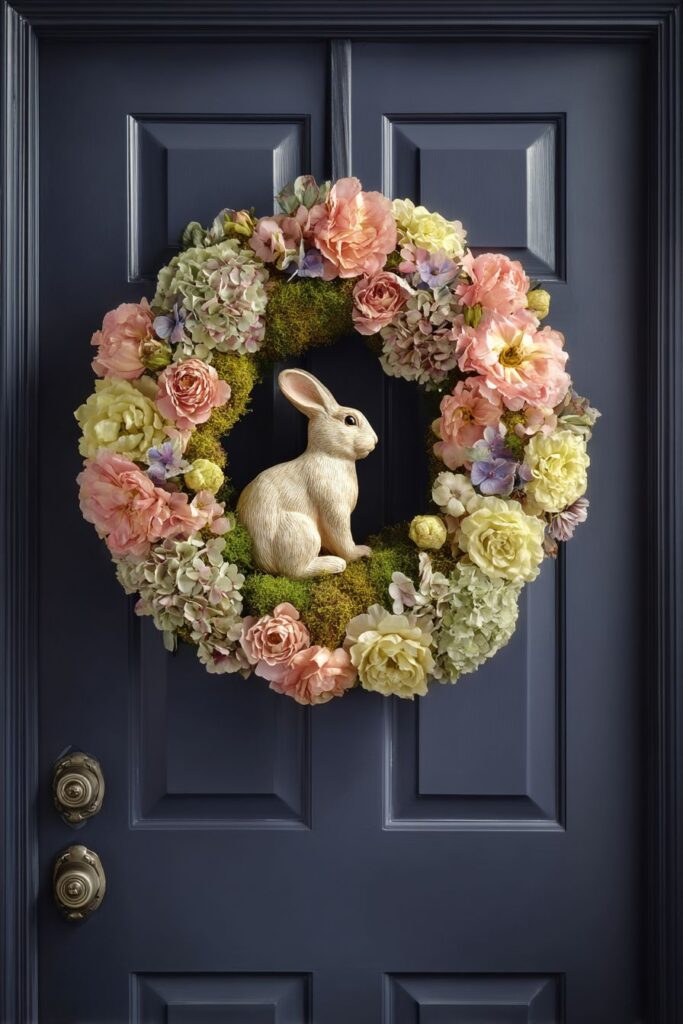
Traditional Easter door decorations hold a special place in many hearts, evoking memories of family gatherings and timeless celebrations. This full pastel flower wreath, coordinated in harmonious shades of peach, mint green, and butter yellow, represents the classic approach to Easter decorating with sophisticated execution. The careful selection of these specific pastel tones creates a cohesive color story that feels both festive and refined, avoiding the overly saccharine quality that can sometimes plague Easter decorations. The density of the floral arrangement provides luxurious fullness while allowing each bloom type to maintain its individual character within the composition.
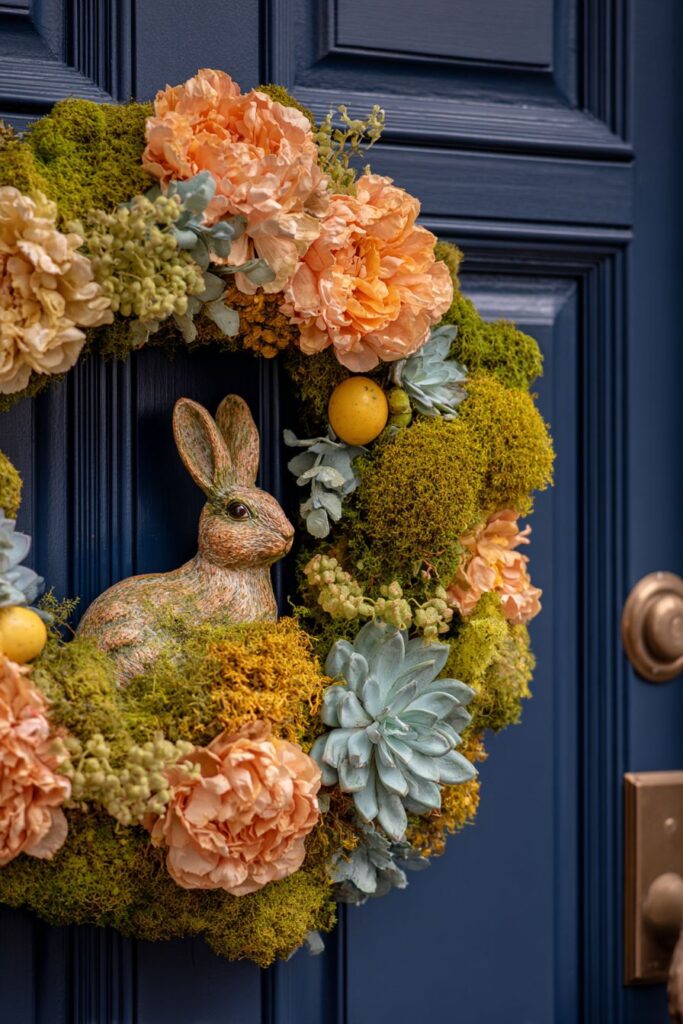
The incorporated ceramic bunny figure serves as a charming focal point, nestled among preserved moss and realistic faux blooms that create a lush, garden-like environment. This three-dimensional element adds personality and whimsy to the design while maintaining the overall elegance of the piece. The preserved moss introduces varied textures and rich green tones that ground the pastel palette, providing visual anchor points that prevent the design from appearing too ethereal. When displayed against a classic six-panel colonial door in deep navy blue, the color contrast becomes dramatic and eye-catching, allowing the soft pastels to truly pop and command attention.
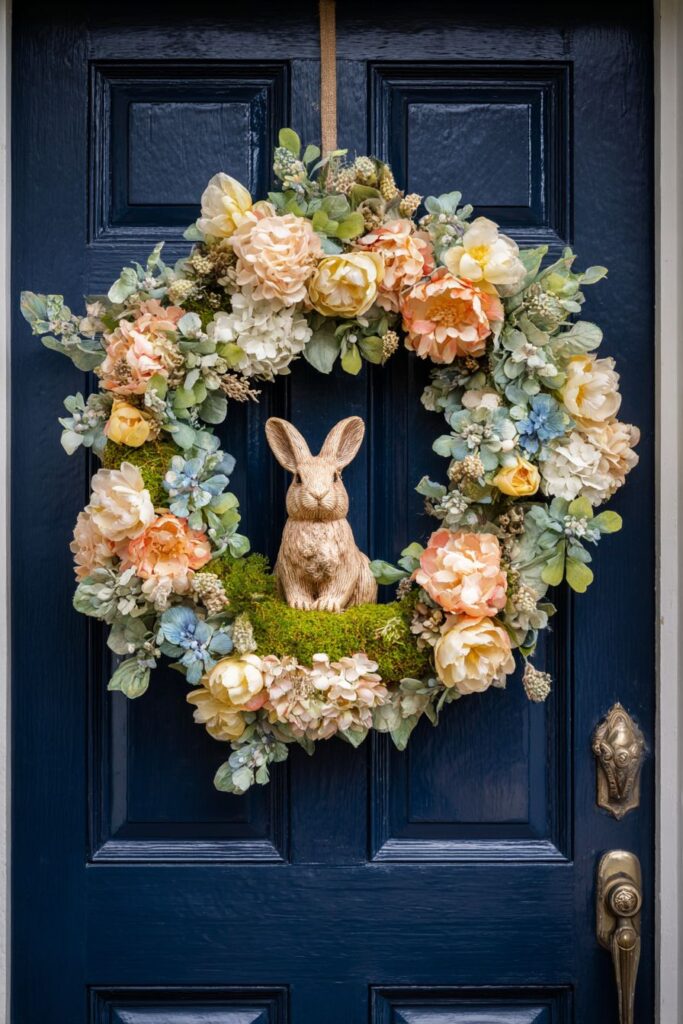
Professional interior photography techniques reveal how rich color contrast can elevate a decoration from pleasant to spectacular. Soft diffused afternoon light highlights the varied textures of flowers, moss, and ceramic elements, while natural shadows add depth and dimension to the wreath. This interplay of light and shadow transforms a flat decoration into a dynamic, living piece that changes subtly throughout the day.
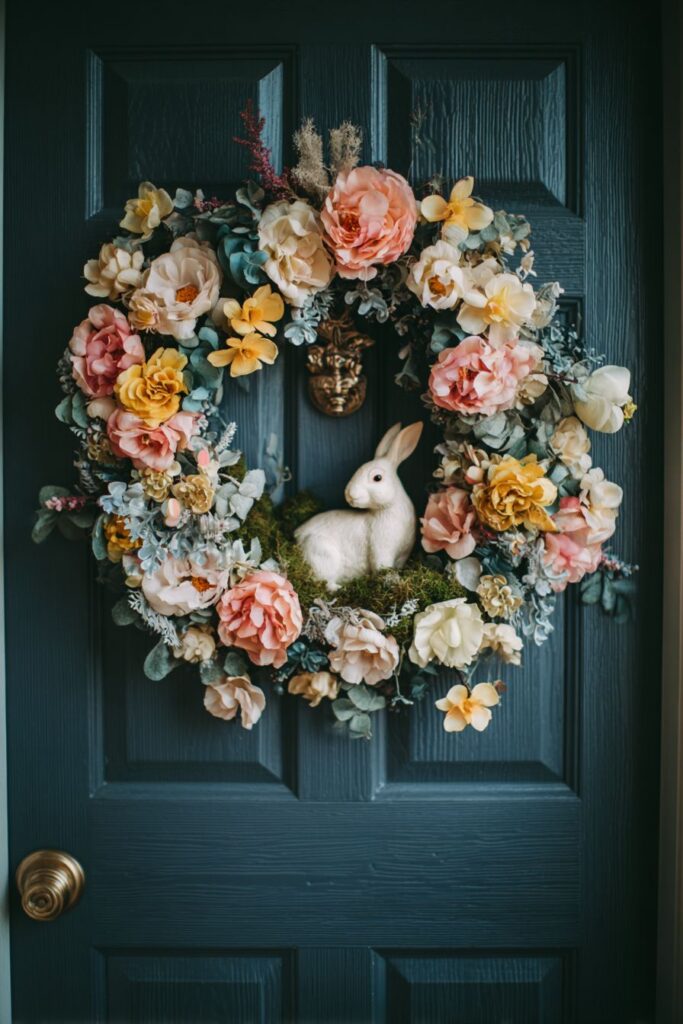
Key Design Tips:
- Build floral layers from larger blooms at the base to smaller flowers at the edges for depth
- Position the ceramic bunny slightly off-center to create visual interest and avoid stagnation
- Use hot glue strategically on the back of elements to ensure weatherproof attachment
- Incorporate preserved moss in irregular patches to mimic natural growth patterns
- Choose a wreath form slightly smaller than desired finished size to ensure full, abundant appearance
4. Cottage-Style Weathered Basket Flower Arrangement
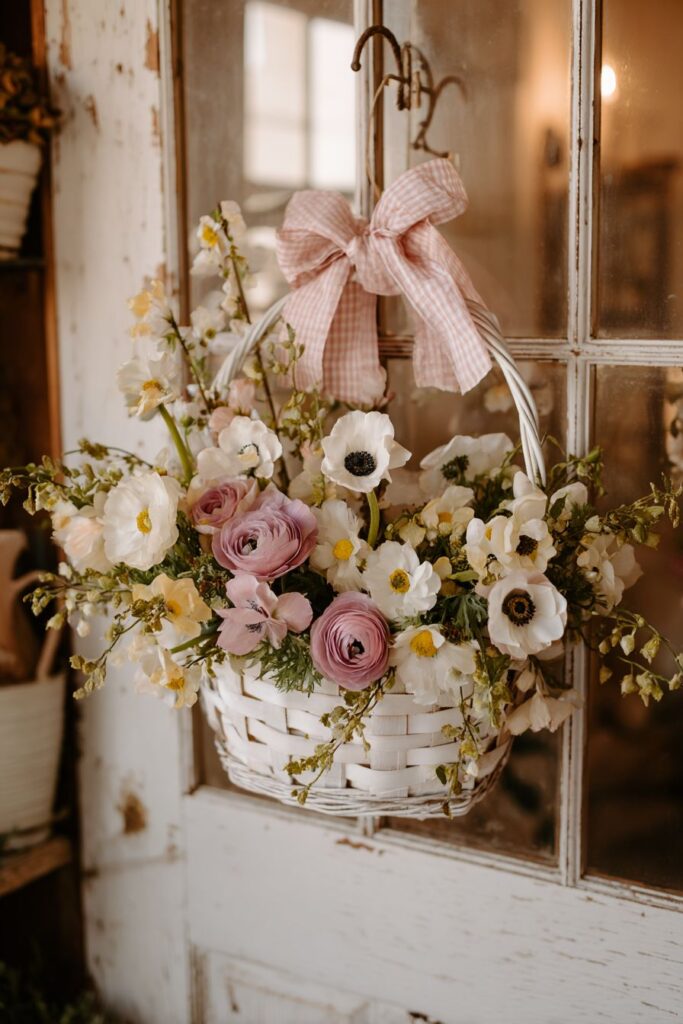
The cottage-style approach to Easter door decorations embraces an effortlessly romantic aesthetic that celebrates imperfection and natural beauty. A weathered white basket mounted at eye level serves as both container and design element, its distressed finish telling a story of age and character that perfectly complements the cottage aesthetic. Overflowing with spring flowers including ranunculus, anemones, and jasmine vines, the arrangement creates a sense of abundance and organic growth that appears to have been freshly gathered from a cottage garden. The asymmetrical overflow of blooms and trailing vines suggests spontaneity rather than rigid design, inviting viewers to appreciate the natural beauty of each individual element.
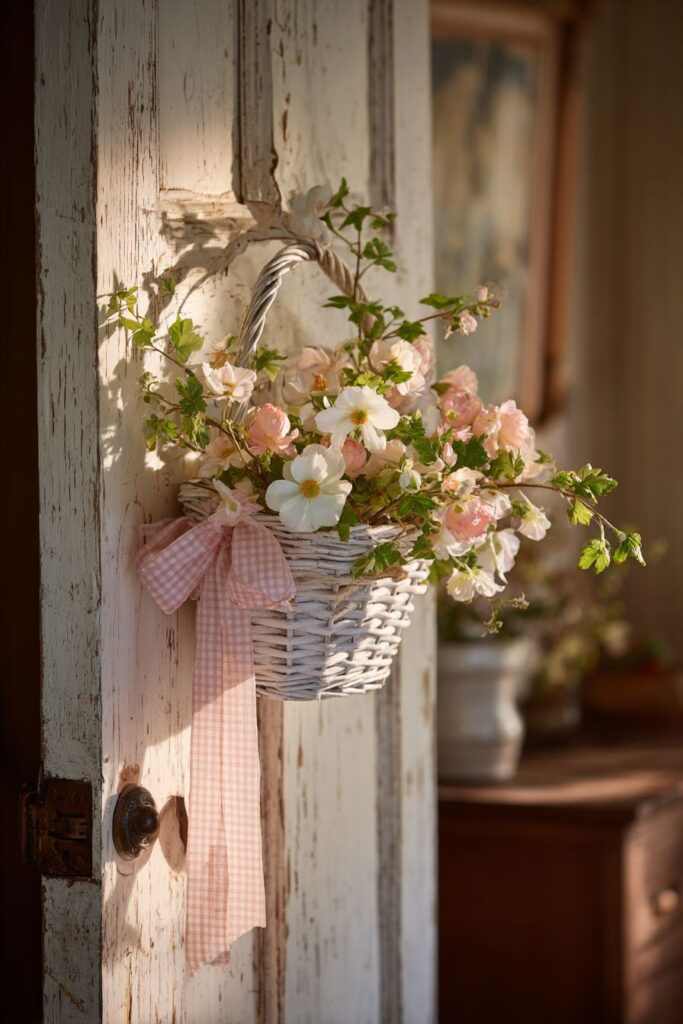
The delicate ribbon in pale pink gingham pattern, tied in a loose bow, adds a touch of sweetness without veering into overly precious territory. This classic pattern evokes nostalgic charm while the pale coloration keeps it sophisticated and current. When paired with a painted wooden door featuring a chippy white finish that shows authentic wear, the entire composition achieves a lived-in, collected-over-time quality that defines cottage style. The deliberate embrace of weathered surfaces and vintage-inspired elements creates warmth and approachability that makes guests feel immediately welcome.
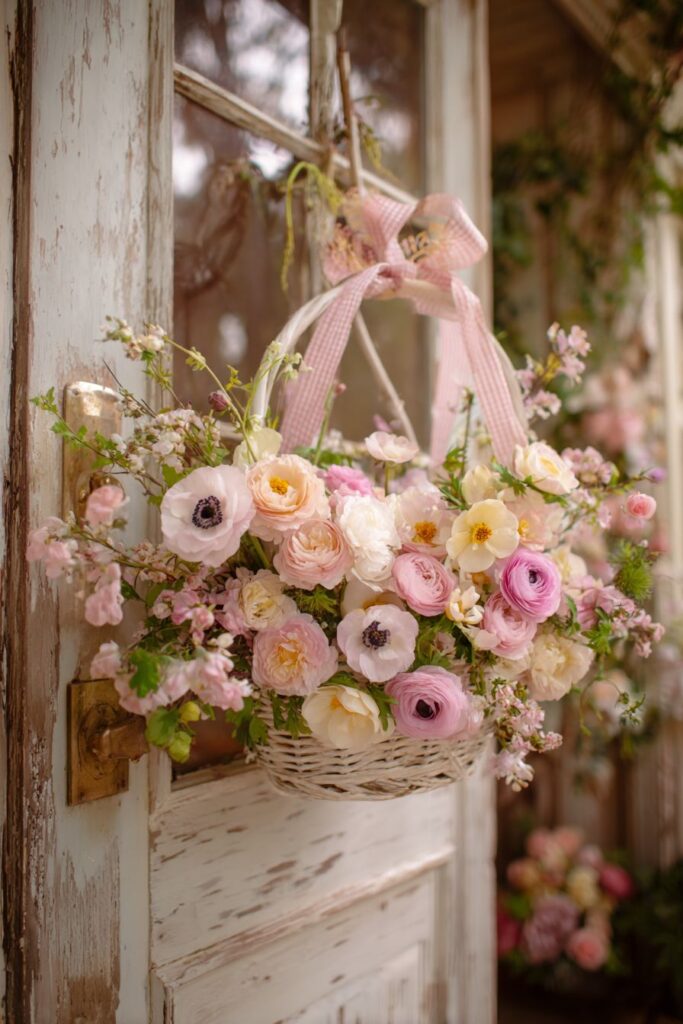
Golden hour lighting transforms this decoration into something truly magical, creating warm ambiance that emphasizes the romantic, lived-in aesthetic of the seasonal display. The soft, warm glow highlights the varied petal textures and creates gentle shadows within the basket’s depths, adding dimension and visual interest. This careful consideration of how different lighting conditions affect your decoration ensures it maintains its charm from morning through evening.
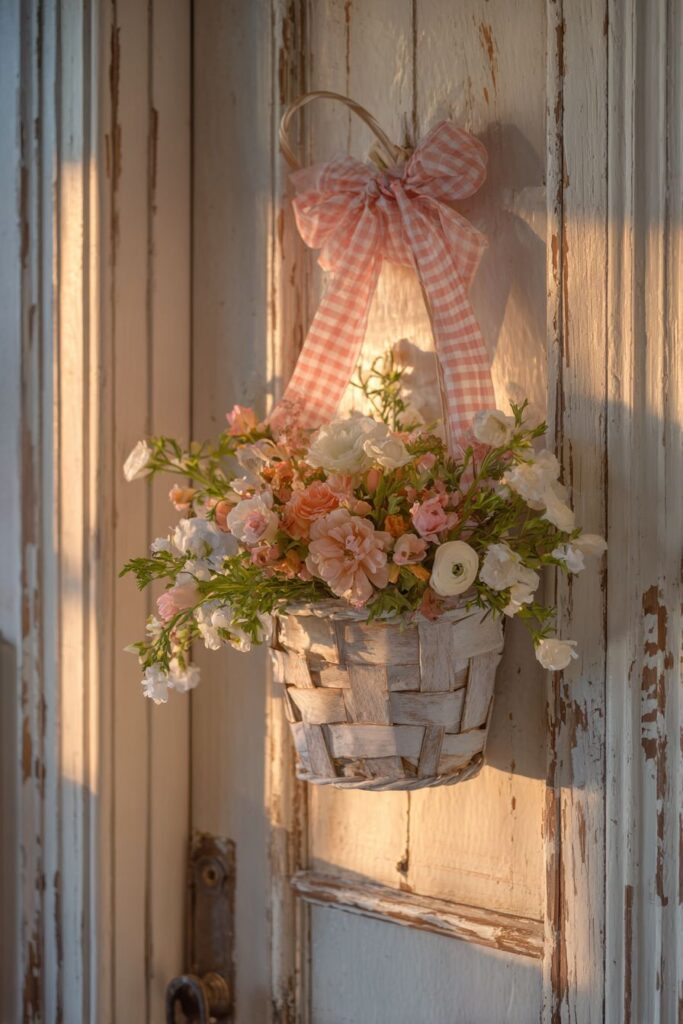
Key Design Tips:
- Select a basket with visible wear patterns and paint distressing for authentic cottage appeal
- Arrange flowers to appear naturally placed, with some stems crossing and others standing independent
- Allow jasmine vines to trail and curl organically, securing only at key points for guidance
- Choose gingham ribbon with checks no larger than half-inch for appropriate scale
- Position the basket slightly tilted forward so flowers face outward toward visitors
5. Contemporary Geometric Wire Frame Wreath
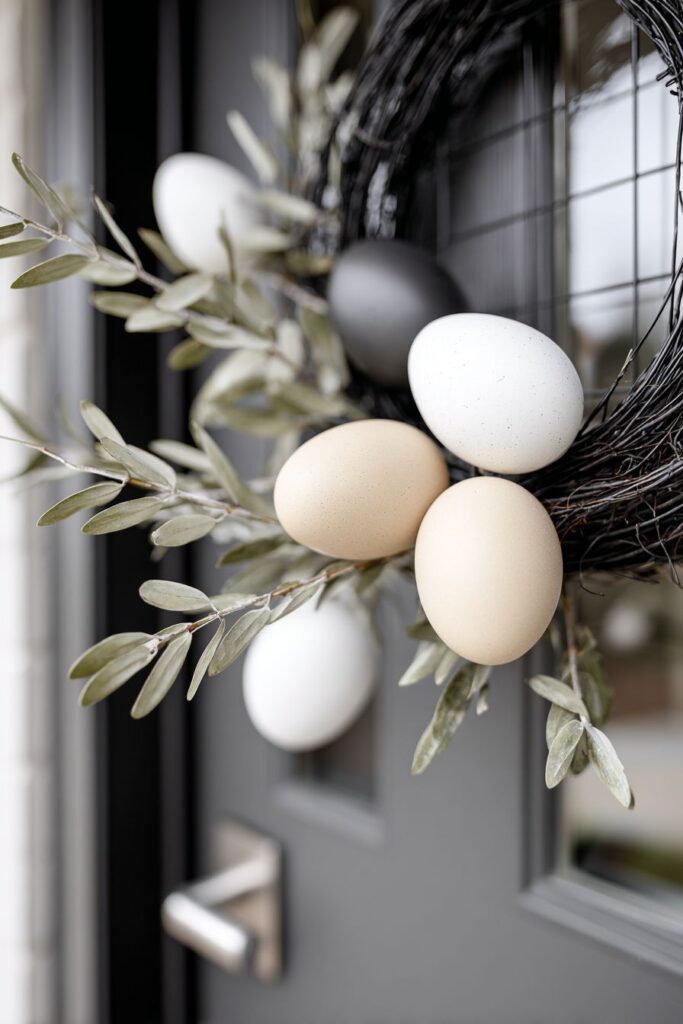
Contemporary design celebrates clean lines, unexpected materials, and sophisticated restraint, making this geometric wire frame wreath a perfect representation of modern Easter decorating. The matte black wire frame creates striking architectural interest, its angular geometry offering a bold departure from traditional circular wreaths while maintaining the symbolic nature of the wreath form. Adorned with sleek porcelain eggs in monochromatic white and cream tones, the decoration achieves a refined elegance that speaks to design-conscious homeowners. The smooth, luminous quality of porcelain provides beautiful contrast against the industrial-feeling wire frame, creating a dialogue between organic shapes and geometric structure.
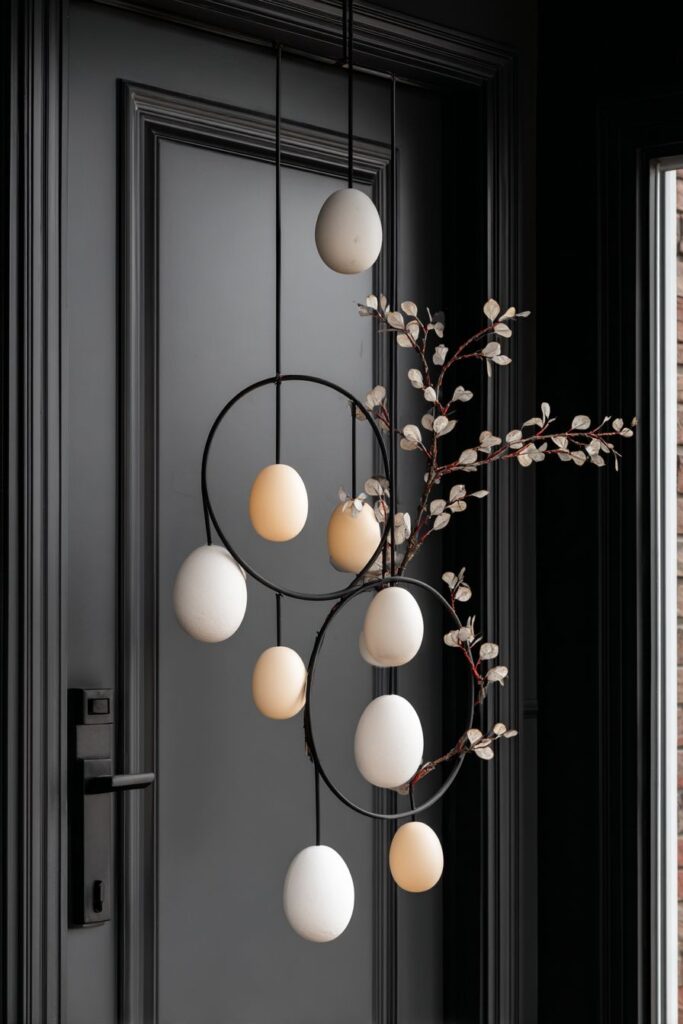
Minimal greenery, specifically silver dollar eucalyptus, introduces subtle organic contrast without overwhelming the contemporary aesthetic. The round, silvery leaves echo the egg shapes while their muted color maintains the sophisticated monochromatic palette. This restrained use of botanical elements demonstrates the contemporary principle that every element should serve a clear purpose within the overall design. When displayed against a modern grey front door with brushed nickel hardware, the decoration achieves perfect harmony with its architectural context, appearing as though it was designed specifically for that location.
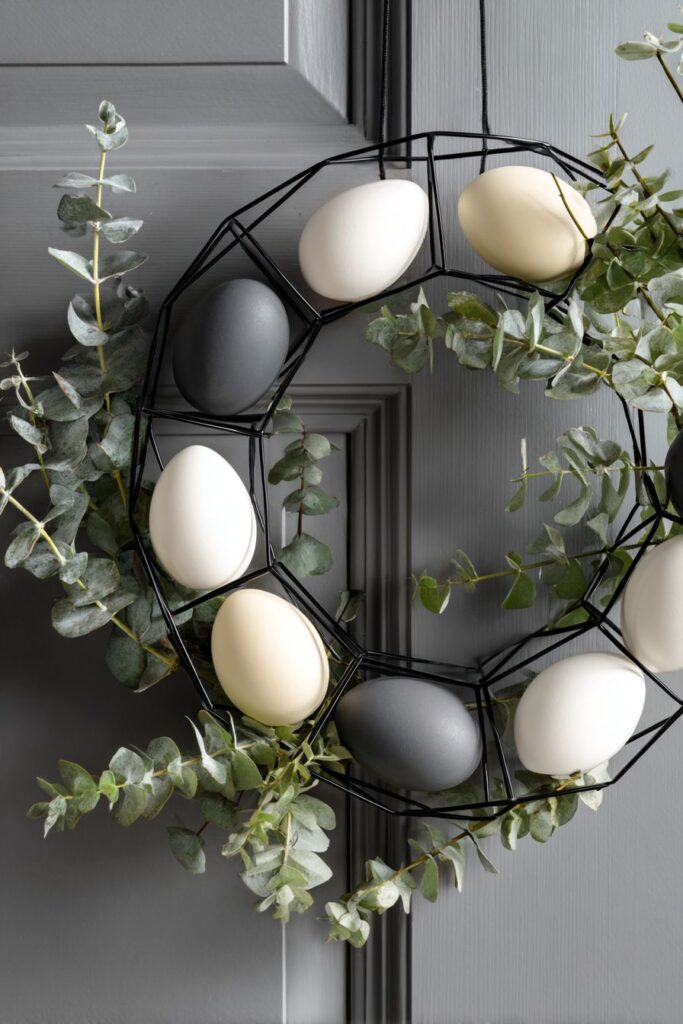
Architectural digest style photography emphasizes crisp focus on material details and even lighting that showcases clean lines and sophisticated color palettes. This approach to capturing and appreciating the decoration reveals the thoughtfulness behind each design decision, from the specific matte finish on the wire to the subtle variation between white and cream porcelain eggs. The contemporary aesthetic proves that Easter decorations can be both festive and refined, celebrating the season without sacrificing sophisticated design principles.
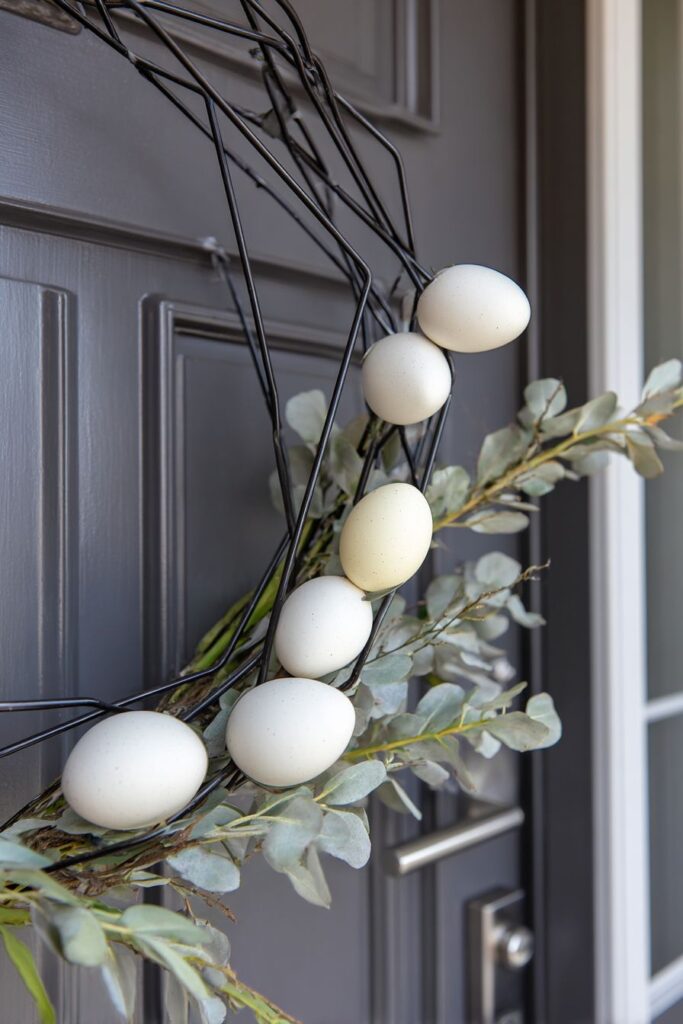
Key Design Tips:
- Choose geometric wire frames with welded joints for structural integrity and clean lines
- Limit color palette to no more than three shades within the same tonal family
- Attach porcelain eggs with thin black wire to maintain the monochromatic scheme
- Space eucalyptus sprigs evenly around the frame for balanced, intentional placement
- Position the wreath perfectly centered on the door for symmetrical, modern appeal
6. Rustic Twig and Birch Bark Wreath with Natural Elements
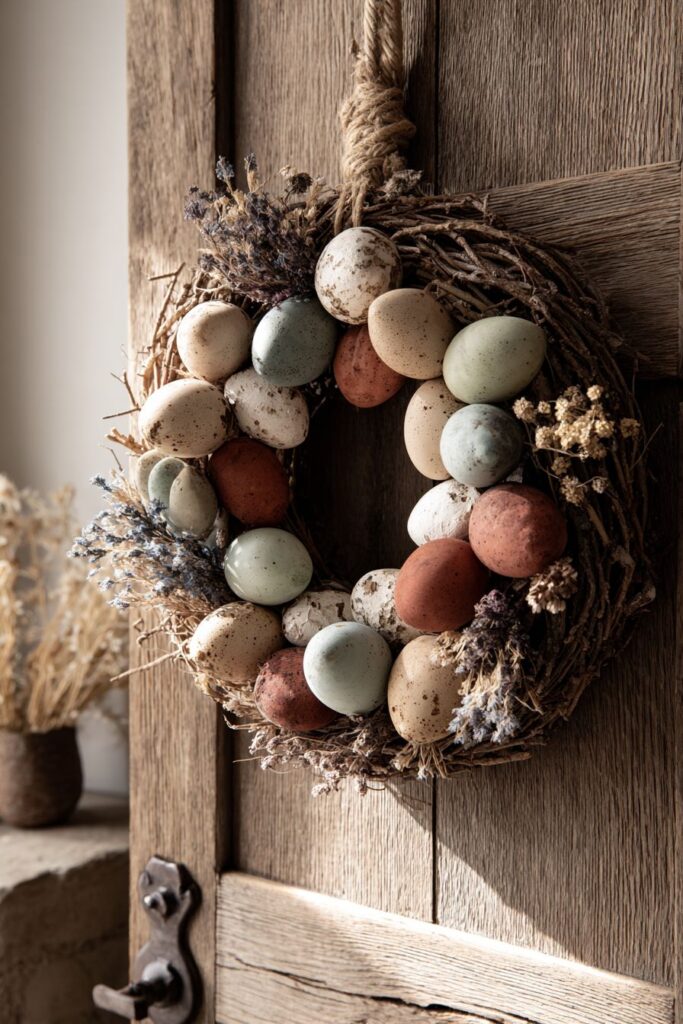
Rustic design celebrates the raw beauty of natural materials and handcrafted authenticity, making this twig and birch bark wreath base an ideal foundation for organic Easter decorating. The combination of irregular twigs and distinctive birch bark creates immediate visual interest through contrasting textures and tones—the rough, dark twigs playing against the smooth, pale bark with its characteristic horizontal markings. Naturally dyed eggs in earth tones including moss green, terracotta, and soft taupe maintain the organic aesthetic while providing seasonal recognition. These muted, nature-inspired colors feel sophisticated and timeless, avoiding the commercial brightness often associated with Easter decorations.
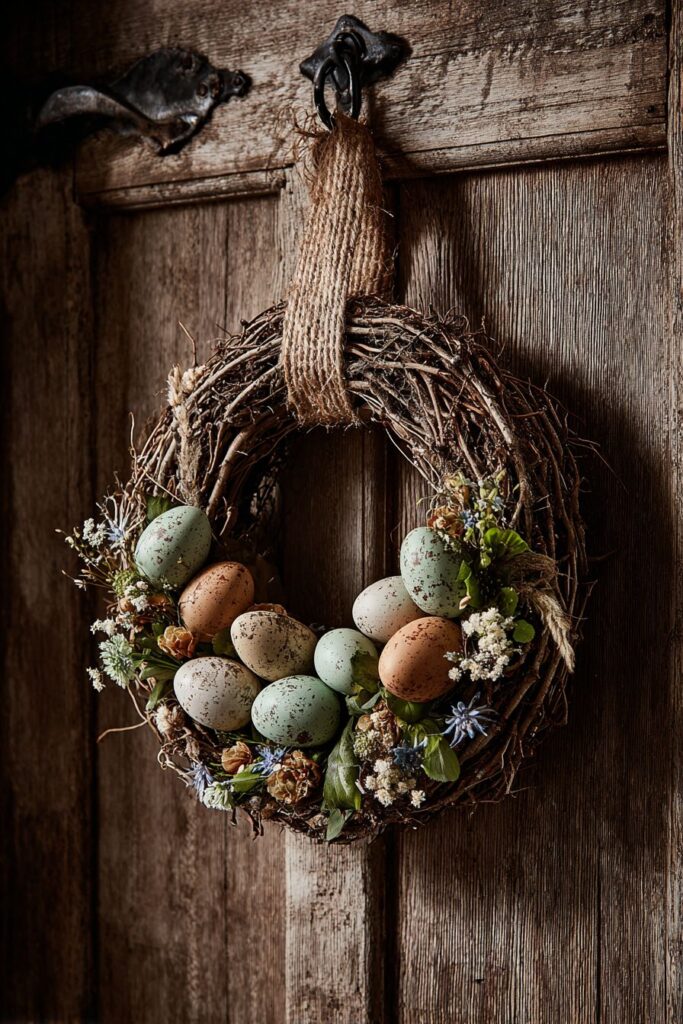
Hand-tied jute rope and dried wildflowers add authentic farmhouse charm while reinforcing the handcrafted quality of the piece. The rough texture of jute rope provides tactile interest and visual weight, while dried wildflowers introduce delicate detail that softens the more robust elements. This careful layering of natural materials creates depth and complexity that rewards closer inspection, revealing new details with each viewing. When displayed on a reclaimed wood door with visible grain and natural patina, the decoration appears to be an organic extension of the door itself, creating seamless visual flow from one natural element to another.
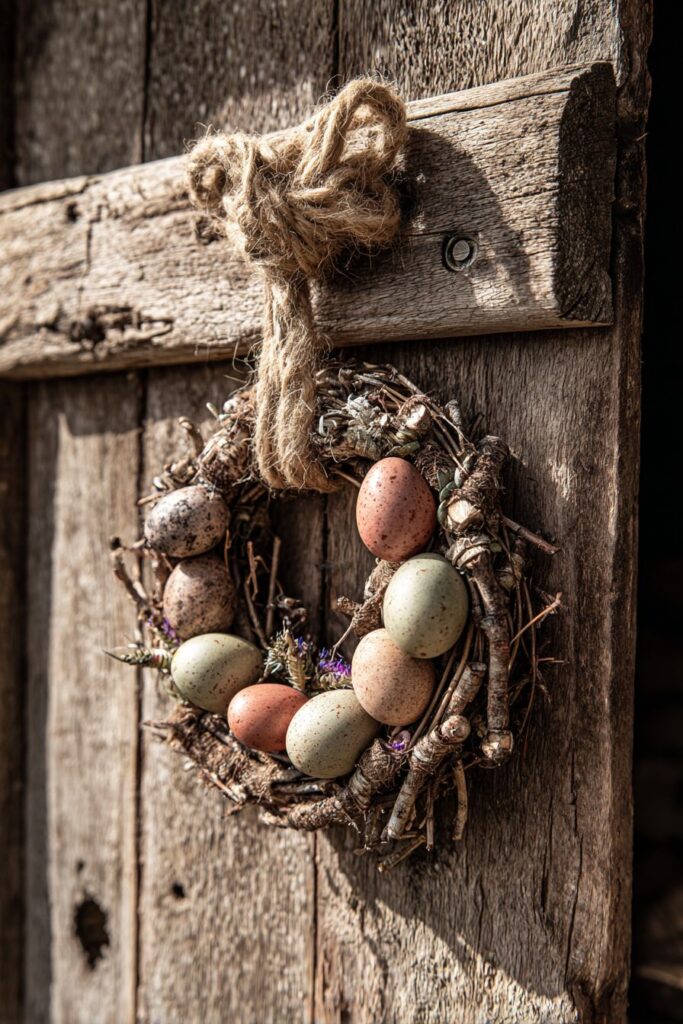
Interior design photography that captures natural lighting conditions reveals the true beauty of organic materials. Mid-morning sun creates realistic shadows that highlight the varied textures—the rough bark, smooth eggs, twisted jute, and delicate dried flowers—while emphasizing the handcrafted quality that makes this decoration special. This authentic, nature-inspired approach to Easter decorating appeals to those who value sustainability and the inherent beauty of unprocessed materials.
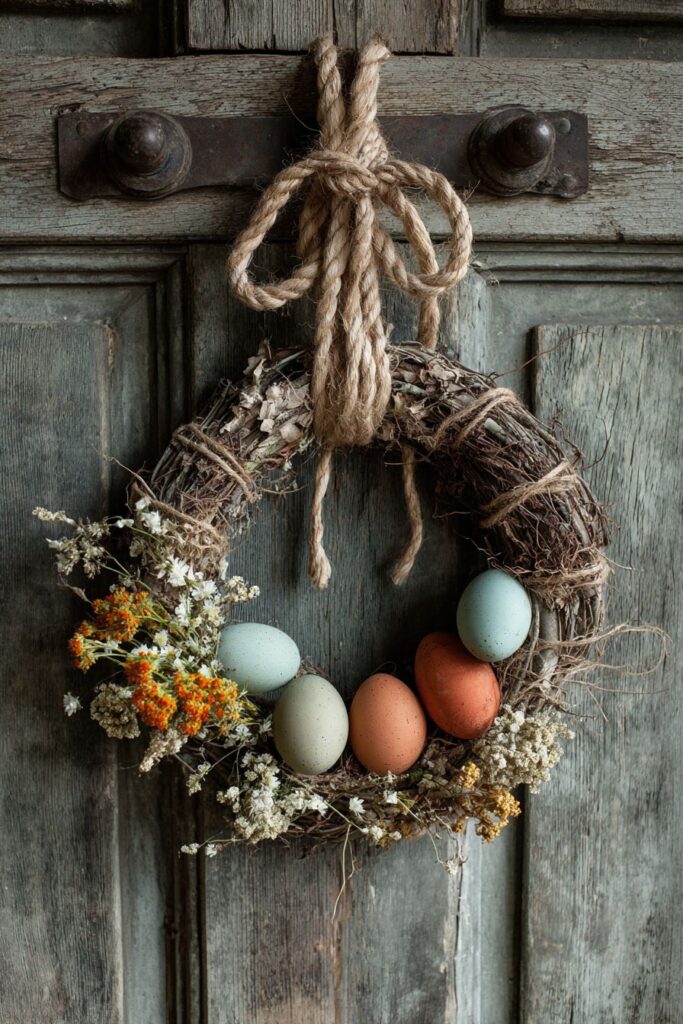
Key Design Tips:
- Collect birch bark responsibly from fallen branches to ensure environmental sustainability
- Use natural dyes like turmeric, beet juice, and spinach for authentic earth-tone egg colors
- Wrap jute rope loosely to allow individual fibers to show for authentic texture
- Select dried wildflowers that maintain color and structure well, like lavender and statice
- Vary twig thickness throughout the wreath for organic, collected-from-nature appearance
7. Elegant Hydrangea Wreath with Pearl-Finish Eggs
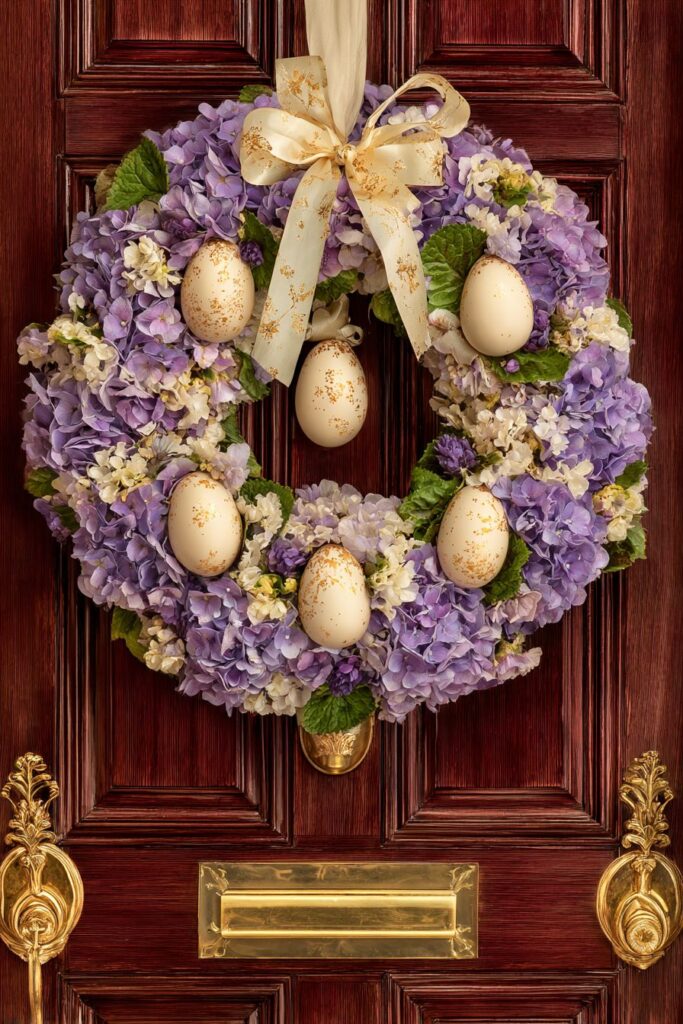
Elegance in Easter door decorations comes from thoughtful material selection, refined color palettes, and luxurious textures, all beautifully demonstrated in this lush hydrangea wreath. The full, rounded hydrangea blooms in soft lavender and cream create immediate visual impact through their generous scale and romantic coloration. These sophisticated flowers, whether preserved or high-quality silk, provide the foundation for an upscale design that feels appropriate for formal homes and special occasions. The pearl-finish ornamental eggs introduce subtle shimmer and refined detail, their lustrous surface catching light beautifully and adding dimension to the overall composition.
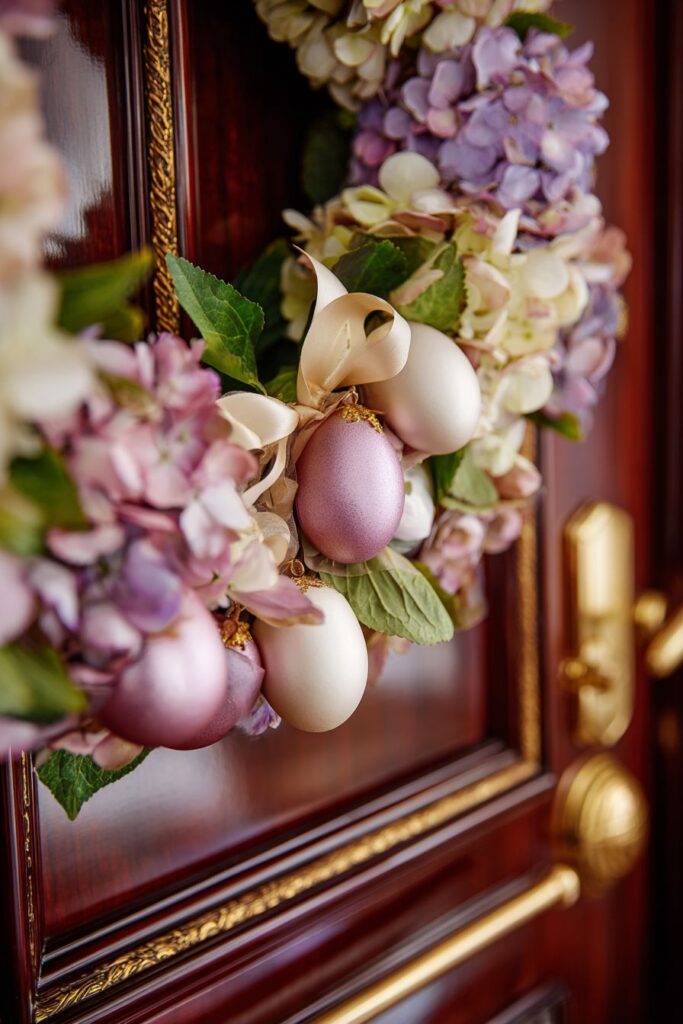
Flowing silk ribbon in coordinating tones provides movement and grace, its elegant draping suggesting effortless sophistication. Subtle metallic gold details strategically placed throughout the design—perhaps in egg accents or ribbon edges—catch the light and add just enough glamour without overwhelming the soft, romantic palette. This restrained use of metallic elements demonstrates design maturity, understanding that luxury often comes from subtle details rather than obvious embellishment. When displayed on a rich mahogany wooden door with polished brass hardware, the decoration achieves a cohesive, high-end aesthetic that speaks to refined taste and attention to detail.
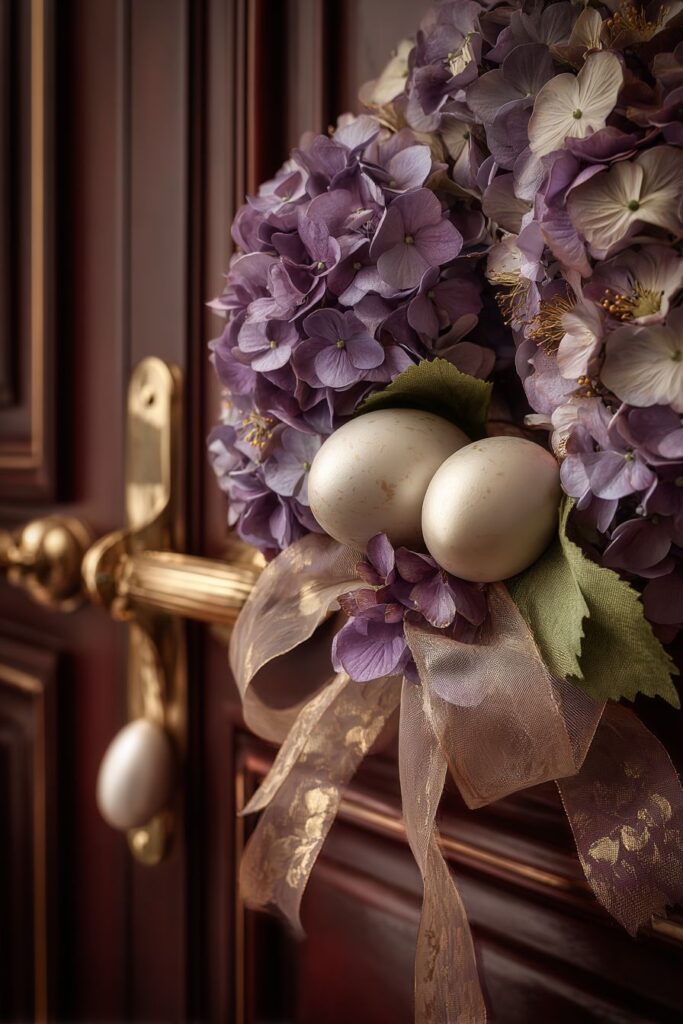
Professional interior photography with balanced exposure and soft natural lighting reveals the luxurious textures and refined color palette that make this decoration special. The interplay between matte hydrangea petals, lustrous pearl eggs, and reflective metallic accents creates visual interest through varied surface treatments. This sophisticated arrangement proves that Easter decorations can be both seasonally appropriate and elegantly timeless, appealing to those who appreciate refined design year-round.
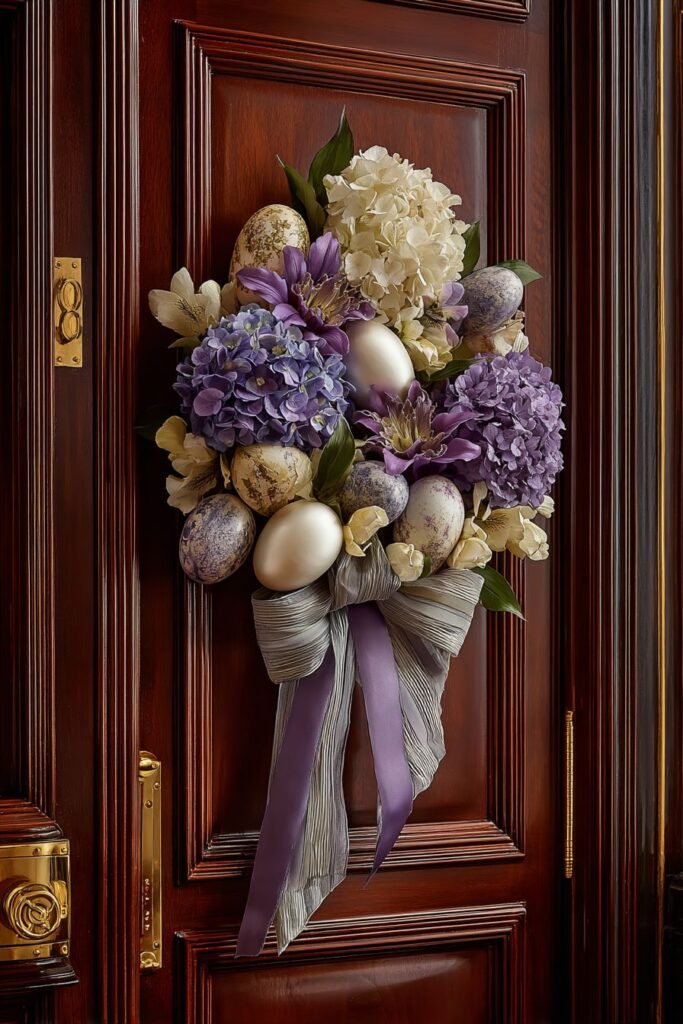
Key Design Tips:
- Choose premium silk or preserved hydrangeas with realistic petal texture and color variation
- Apply pearl finish to eggs using specialized paint or coating for authentic luminosity
- Use wired ribbon for controlled draping and ability to adjust bow shape as needed
- Limit gold accents to 10-15% of overall design to maintain sophistication
- Ensure wreath density is sufficient that no gaps show when viewed from door’s approach angle
8. Whimsical Carrot-Shaped Door Hanger with Spring Blooms
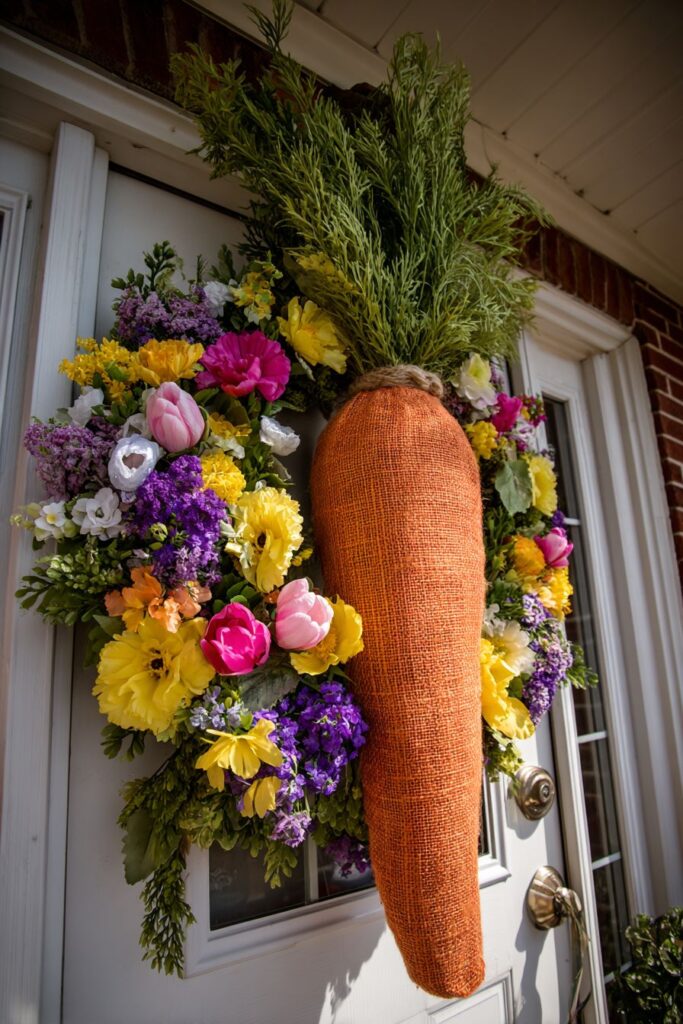
Playful Easter decorations bring joy and lightheartedness to your home’s entrance, and this whimsical carrot-shaped door hanger perfectly captures that spirit. Crafted from orange burlap, the oversized carrot shape immediately signals Easter fun while the fabric’s natural texture keeps the design grounded and tasteful. Topped with artificial greenery that mimics carrot tops, the three-dimensional element creates visual interest and reinforces the vegetable theme with charming literalness. Surrounded by a cheerful wreath of colorful spring blooms in bright yellows, pinks, and purples, the design achieves a joyful exuberance that’s perfect for families with children or anyone who appreciates fun, approachable seasonal decorating.
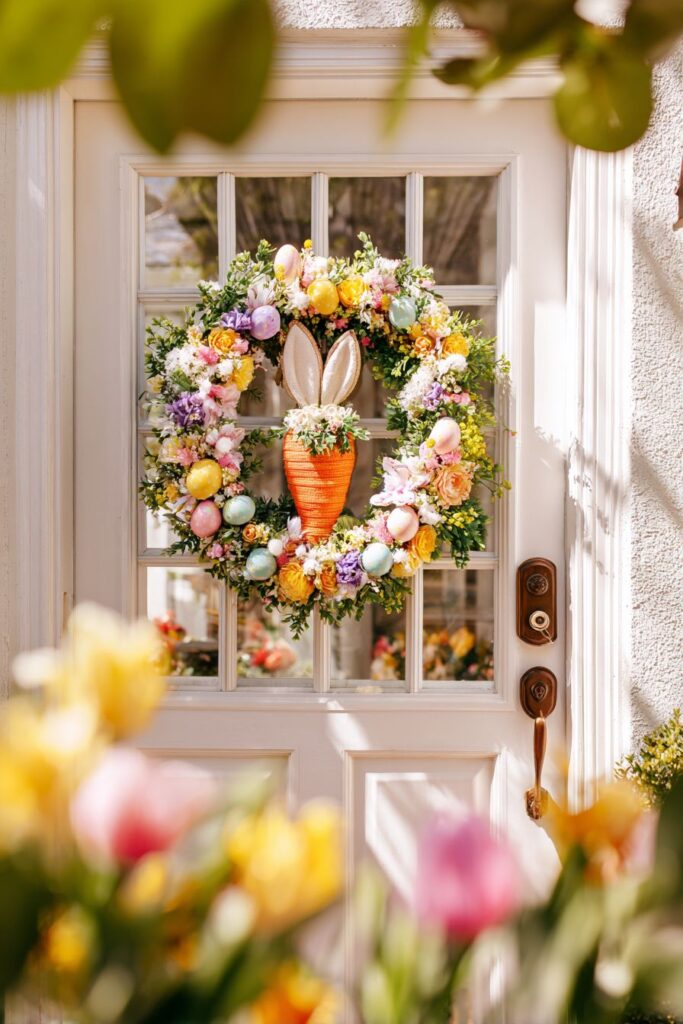
The vibrant color palette embraces the full spectrum of spring, celebrating nature’s reawakening with enthusiastic energy. These saturated hues create visual excitement and catch the eye from a distance, ensuring your Easter spirit is visible to all who pass by. The combination of the literal carrot element with traditional floral wreath components creates an interesting juxtaposition that’s both playful and cohesive. When displayed on a white painted door of a family home, the bright colors pop beautifully against the neutral background, creating maximum visual impact and curb appeal.
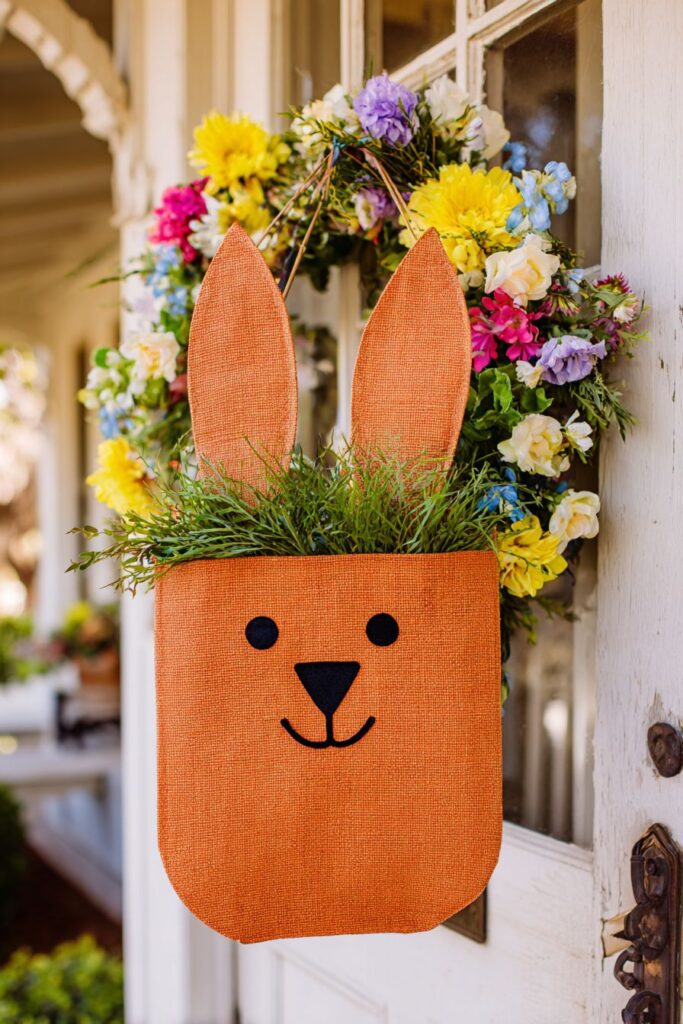
Wide-angle interior design photography captures the joyful, kid-friendly aesthetic that makes this decoration special. Bright natural daylight highlights the vibrant colors and fun textures, from the woven burlap to the silky flower petals, creating an inviting seasonal welcome that makes everyone smile. This approach to Easter decorating proves that festive doesn’t have to mean tacky—thoughtful execution can make even whimsical elements appear intentional and well-designed.
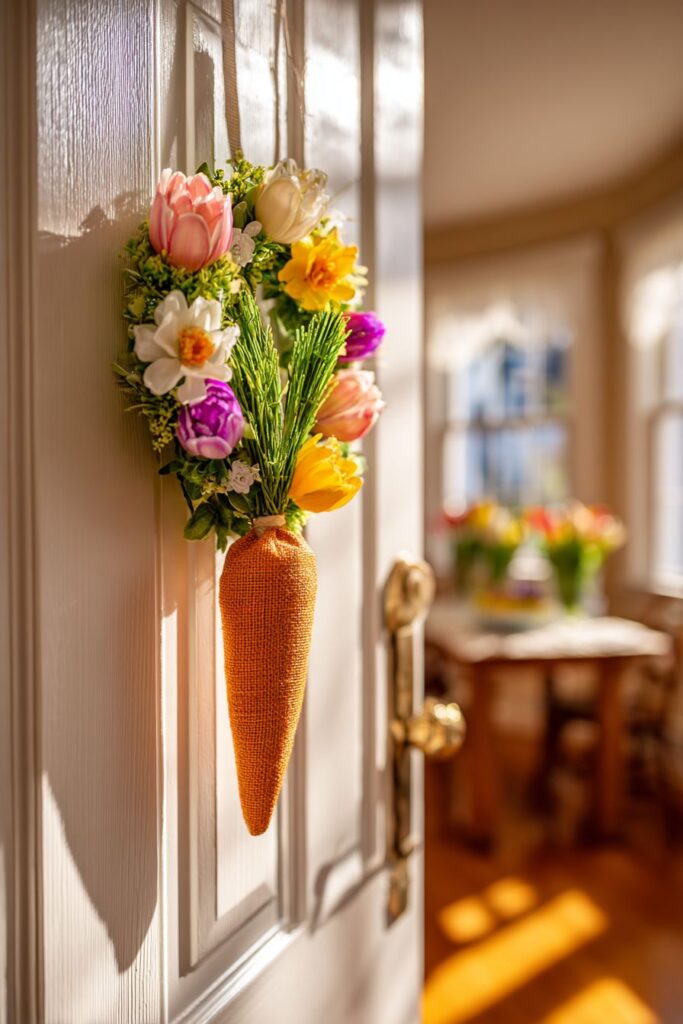
Key Design Tips:
- Stuff carrot shape firmly with fiberfill to create dimensional form that holds its shape
- Use wire inside artificial greenery to allow for natural-looking curves and positioning
- Arrange colorful blooms in rainbow order around wreath for organized visual flow
- Secure carrot element with strong wire or zip ties hidden behind decorative elements
- Choose door hanger hardware that supports additional weight of dimensional carrot
9. Living Succulent and Moss Wreath
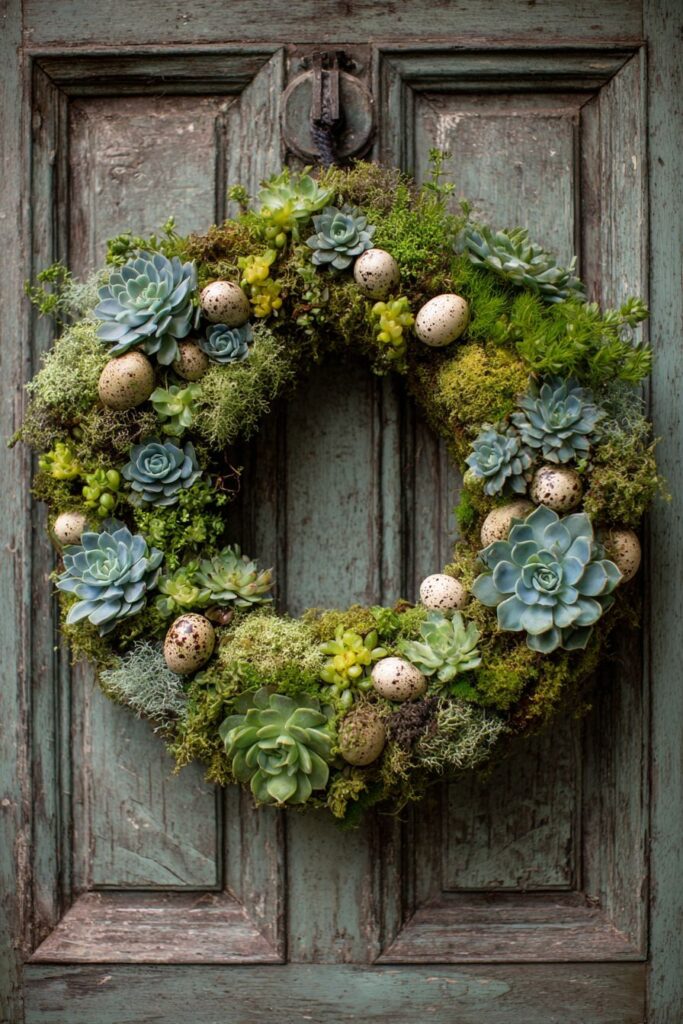
The growing trend toward sustainable, living decorations finds perfect expression in this organic succulent and moss wreath. Real hen-and-chick plants arranged in a circular pattern create a living work of art that continues to grow and evolve throughout the Easter season and beyond. The varied textures and tones of different succulent varieties—from tight rosettes to spreading forms—provide visual interest while maintaining a cohesive green palette. Small speckled robin’s eggs nestled among the greenery introduce seasonal recognition while their natural coloration harmonizes perfectly with the living plants. This connection to nature and growing things adds meaningful depth to your Easter celebration, symbolizing renewal and growth in the most literal sense.
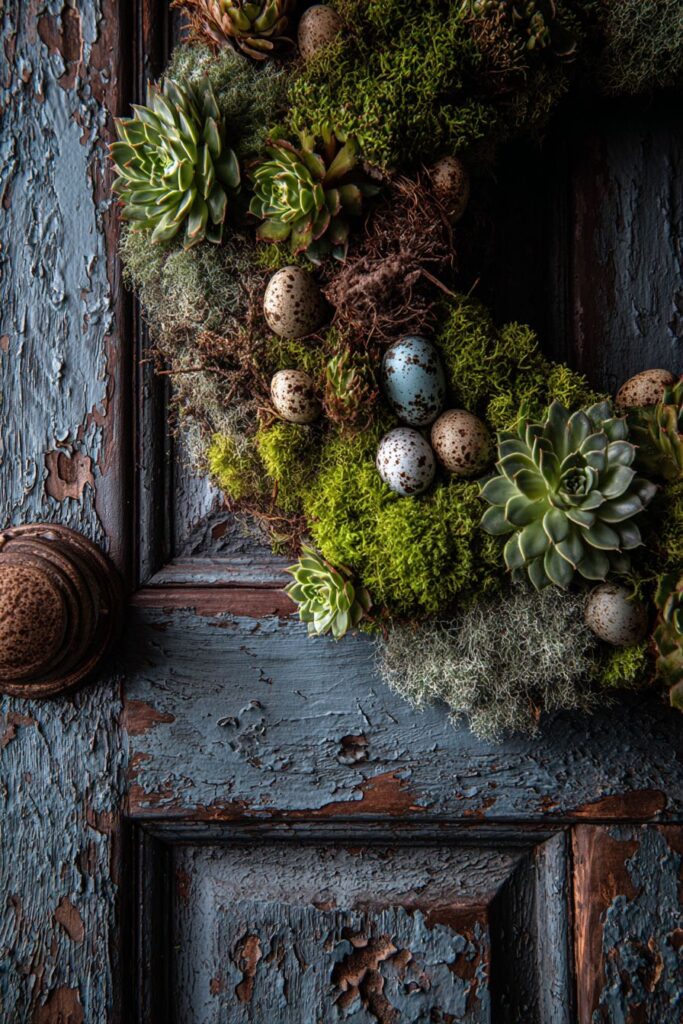
The combination of succulents with preserved moss creates textural contrast and fills negative space beautifully. Moss provides a soft, organic backdrop that allows the architectural succulent forms to stand out while maintaining the wreath’s natural aesthetic. This living decoration requires more care than traditional options but rewards that attention with authentic beauty and the satisfaction of nurturing living plants. When displayed on a weathered grey wooden door with authentic age marks, the decoration appears as a natural outgrowth of the home itself, blurring the lines between decoration and landscape.
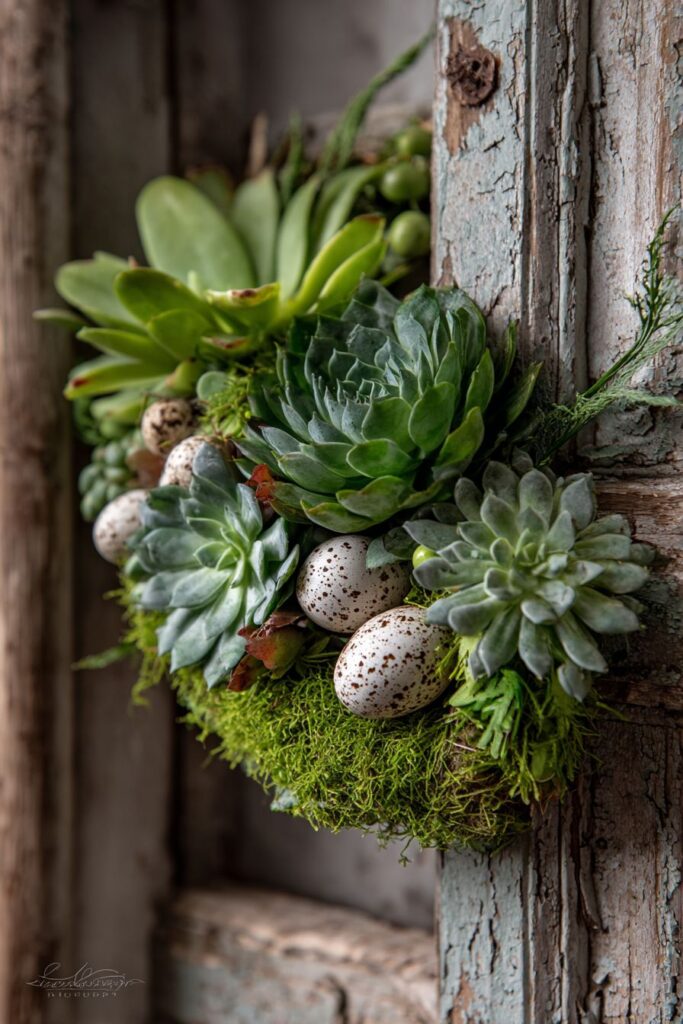
Interior design photography that emphasizes natural textures reveals the varied green tones and demonstrates the living quality of the plants. Soft diffused lighting highlights the fleshy succulent leaves, the delicate robin’s eggs, and the velvety moss texture, creating a composition that feels fresh and alive. This innovative approach to Easter decorating appeals to environmentally conscious homeowners and those who appreciate the authentic beauty of living materials.
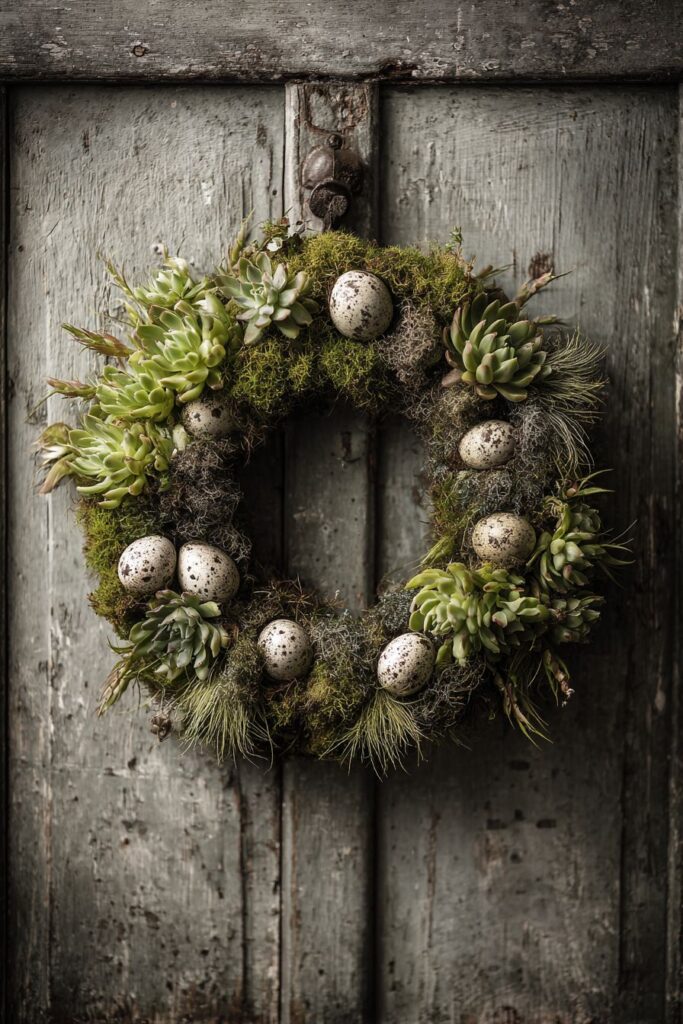
Key Design Tips:
- Use a wire wreath form with chicken wire backing to support succulent root systems
- Select drought-tolerant succulent varieties that can withstand brief periods without water
- Attach succulents using floral pins and moss to hold roots in place as they establish
- Mist the wreath every few days to maintain plant health without overwatering
- Position wreath on a door with partial shade to protect plants from harsh direct sunlight
10. Pastel Ombre Cascading Egg Display

The visual impact of graduated color creates instant sophistication, making this pastel ombre egg display a stunning contemporary take on Easter door decorations. Eggs hanging from satin ribbons at varying lengths create a cascading effect that adds dynamic movement and vertical interest to your entrance. The careful color transition from pale pink through lavender to mint green demonstrates thoughtful design planning and color theory understanding. This gradual shift creates visual flow that guides the eye naturally downward while maintaining cohesion through the shared pastel intensity level. Each egg becomes part of a larger color story, their individual beauty enhanced by their relationship to neighboring elements.
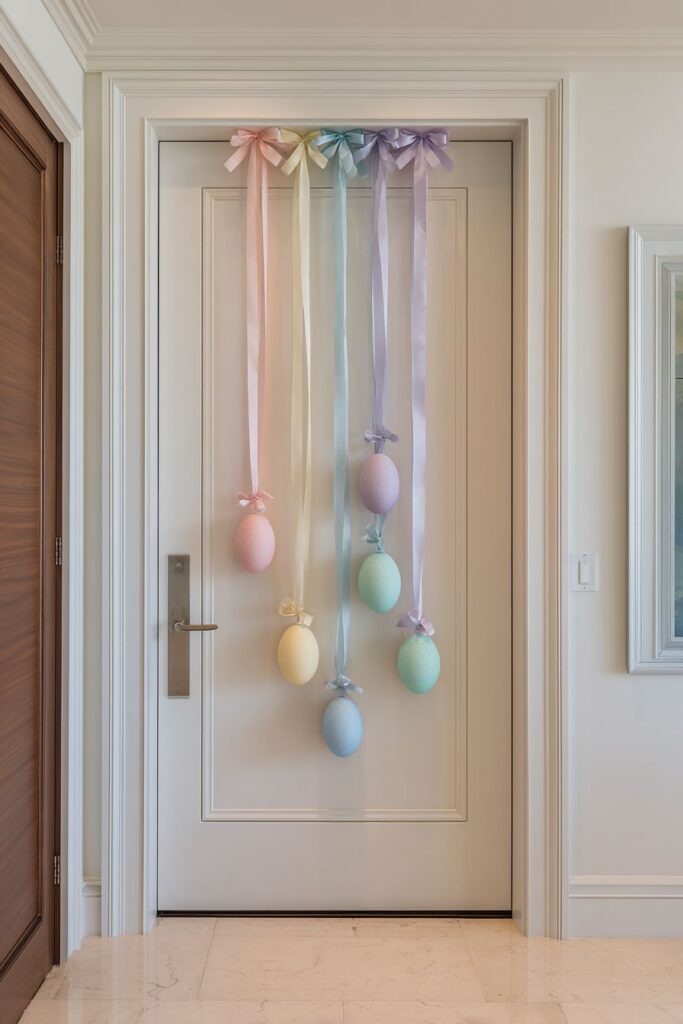
The use of satin ribbons introduces luxurious sheen and elegant draping that elevates the simple egg shapes into refined decorative elements. The ribbons’ varying lengths create rhythm and prevent the design from appearing static or predictable, while their consistent width maintains visual harmony. When displayed against a crisp white door with modern trim, the pastel colors appear even more delicate and refined, their soft hues creating beautiful contrast against the pure white background. This color relationship demonstrates the power of thoughtful backdrop selection in showcasing decorative elements effectively.
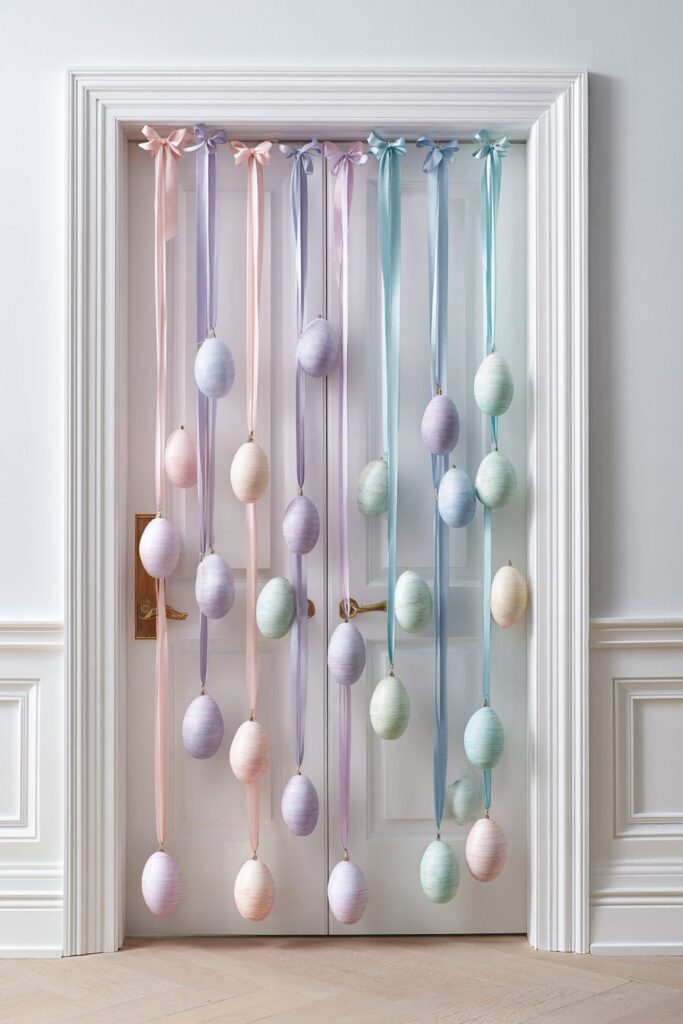
Professional interior photography with wide-angle perspective captures the full vertical arrangement, revealing how the cascading design creates visual height and drama. Natural lighting creates subtle shadows behind each hanging egg and highlights the smooth painted finish and delicate ribbon texture, adding depth and dimension to the linear composition. This modern interpretation of Easter decorating proves that traditional symbols like eggs can be reimagined in fresh, sophisticated ways.

Key Design Tips:
- Paint eggs in gradual color transitions using multiple thin coats for smooth finish
- Vary ribbon lengths in a pattern (shortest to longest then reverse) for dynamic composition
- Use double-sided tape at ribbon attachment points to prevent shifting and maintain spacing
- Hang eggs at door’s upper third to avoid interference with door opening
- Seal painted eggs with gloss finish to enhance color vibrancy and weather resistance
11. Burlap Bunny Silhouette with Twig Wreath
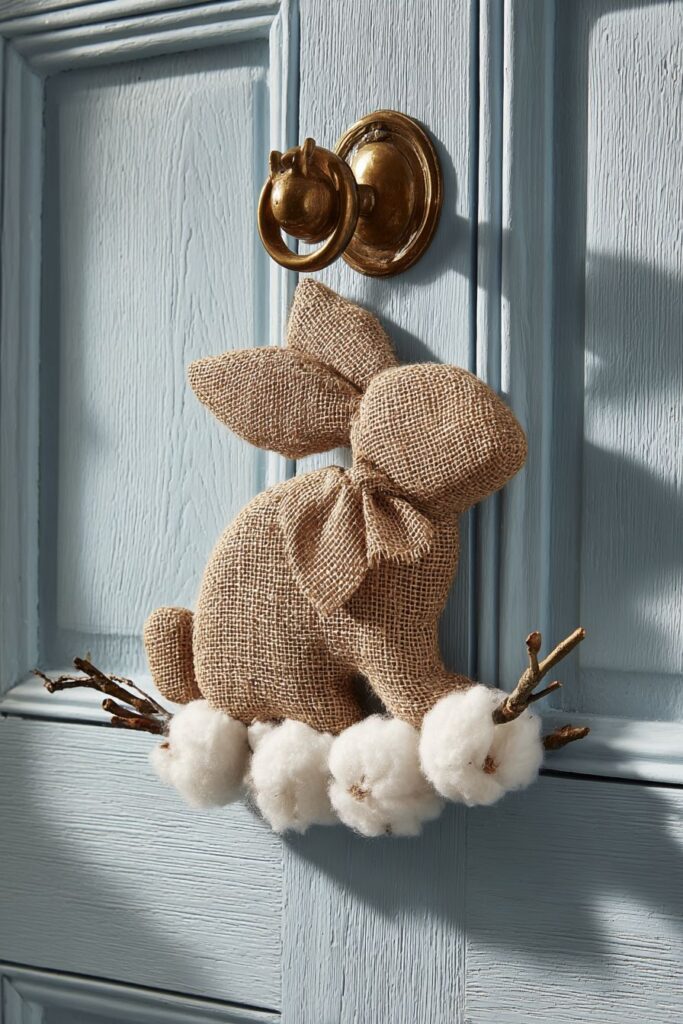
The charm of handmade decorations shines through in this sweet burlap bunny silhouette design. The central bunny figure cut from natural burlap creates immediate seasonal recognition while the fabric’s rough texture adds rustic appeal that prevents the motif from appearing too juvenile. Surrounded by a simple twig wreath that provides organic framing, the bunny becomes a focal point that draws attention without overwhelming the overall composition. The cotton ball tail adds three-dimensional whimsy and tactile interest, its soft white texture contrasting beautifully with the rough burlap. A raffia bow introduces additional natural fiber texture while its warm honey tone complements the burlap’s neutral coloration.
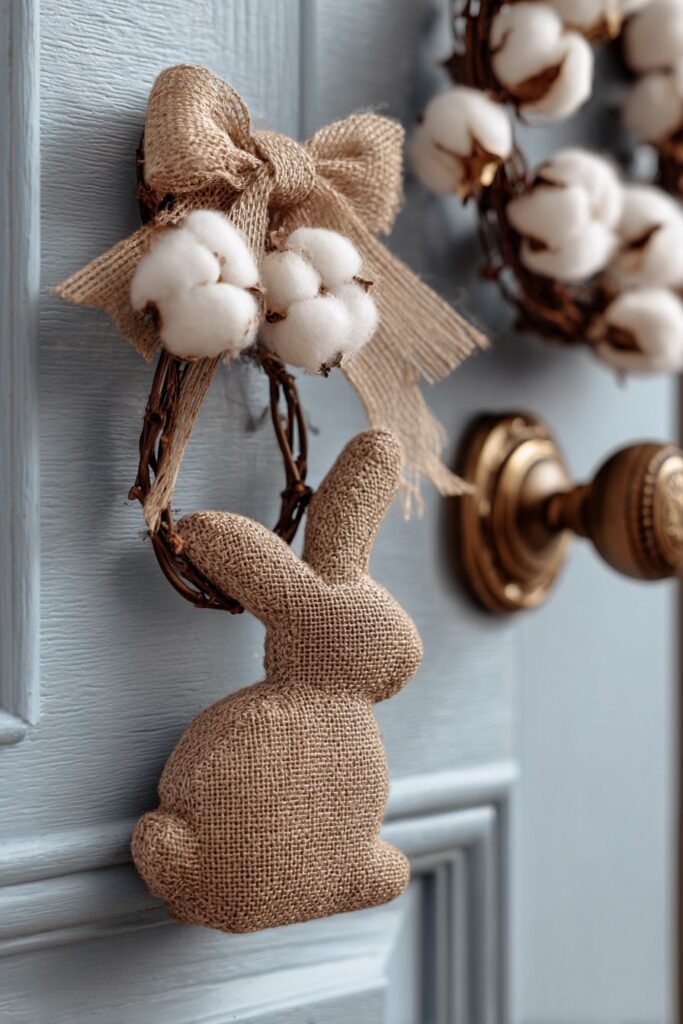
The emphasis on natural fiber textures throughout this design creates cohesion and reinforces the handcrafted aesthetic. Each material—burlap, twigs, cotton, and raffia—brings its own unique texture and visual quality, yet they work together harmoniously because of their shared organic nature. This thoughtful material selection demonstrates how cohesive design can be achieved through texture relationships rather than color matching alone. When displayed on a light blue painted door with vintage brass knocker, the warm natural tones of the decoration create pleasing contrast while maintaining a soft, approachable feel.
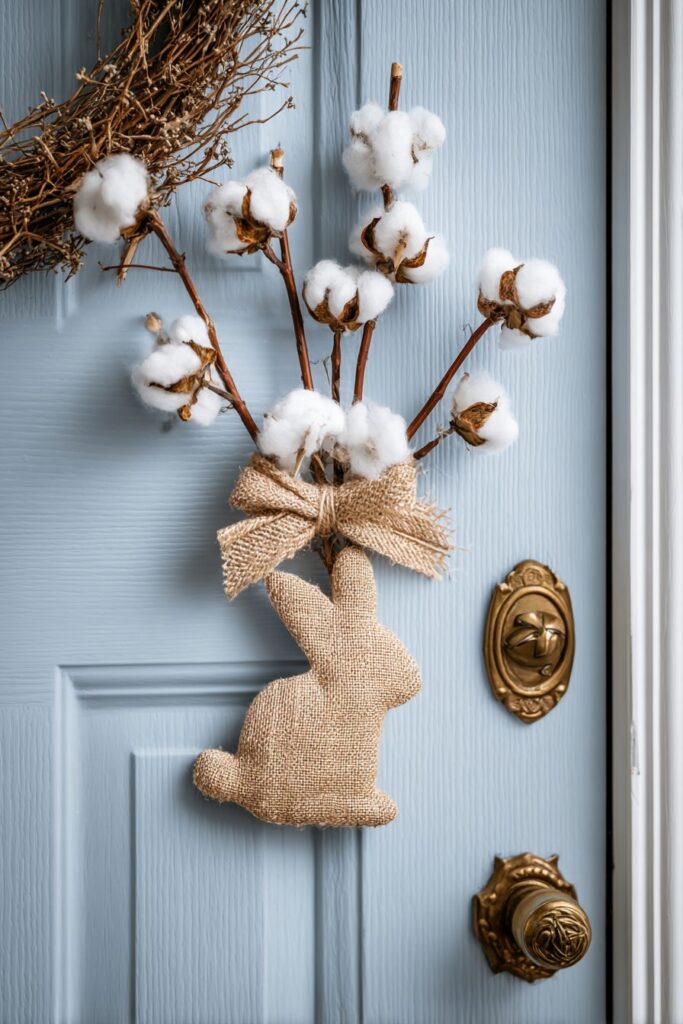
Interior design photography capturing the sweet, handmade quality reveals how soft natural light emphasizes the varied textures of burlap, twigs, and natural fibers. The interplay of rough and smooth, woven and natural, creates visual interest that invites closer inspection. This whimsical yet tasteful design proves that Easter decorations can embrace playful motifs while maintaining design integrity through thoughtful execution and material selection.
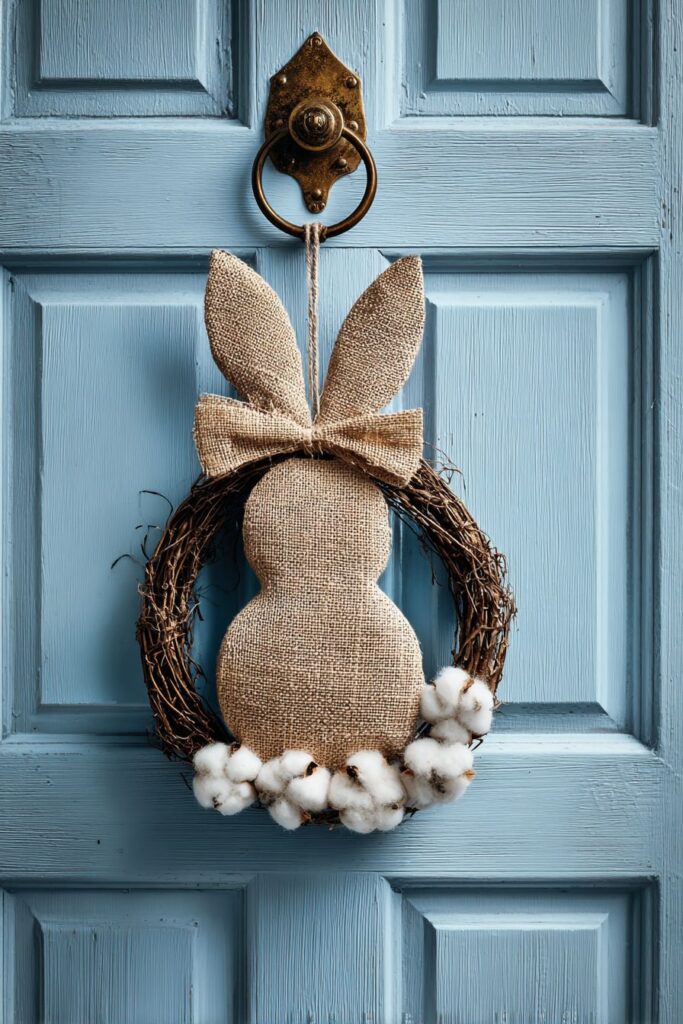
Key Design Tips:
- Cut bunny silhouette with sharp scissors or craft knife for clean edges
- Attach cotton ball tail with hot glue covered by additional fibers for natural appearance
- Weave raffia bow loosely to allow individual strands to show their natural texture
- Select twigs with interesting curves and branches for organic wreath character
- Back burlap with interfacing before cutting to prevent fraying and maintain shape
12. Nested Egg Basket with Fresh Tulip Accents
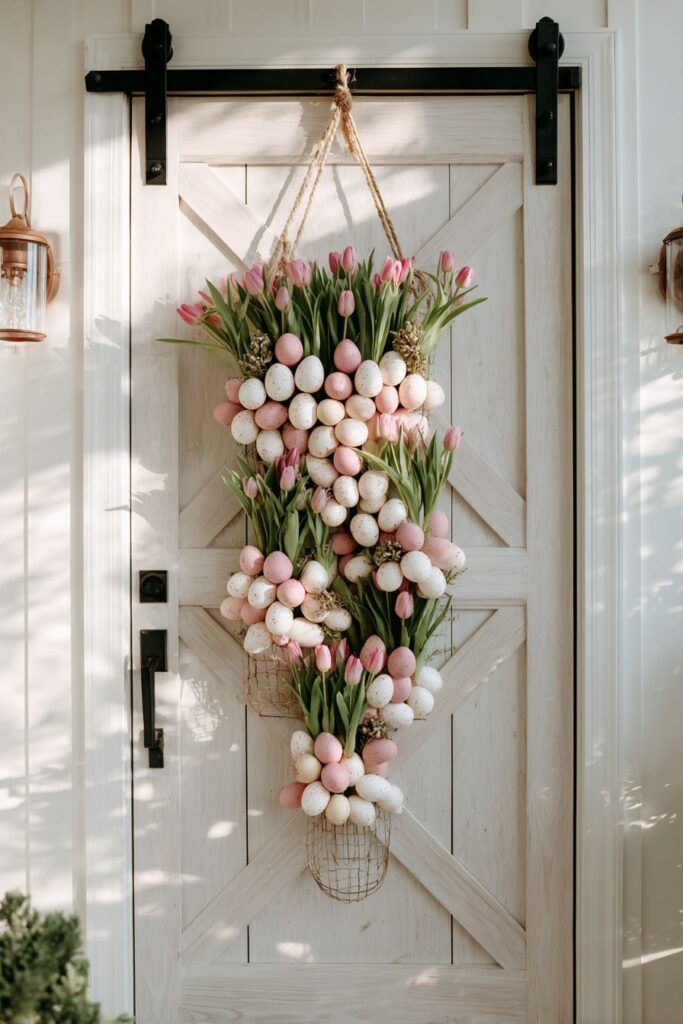
The combination of displayed eggs and fresh flowers creates a garden-fresh Easter door decoration that celebrates spring’s abundance. Hand-painted ceramic eggs displayed in a wire basket provide artistic focal interest, each egg potentially featuring unique patterns or designs that showcase creativity and craftsmanship. The wire basket allows light to filter through while providing structural support, its industrial-chic aesthetic adding contemporary edge to the traditional egg display. Flanking this central element with fresh tulip stems in mason jar hangers introduces living color and organic movement that brings the entire composition to life. The soft color palette of blush, cream, and sage creates sophisticated harmony that feels fresh and modern.
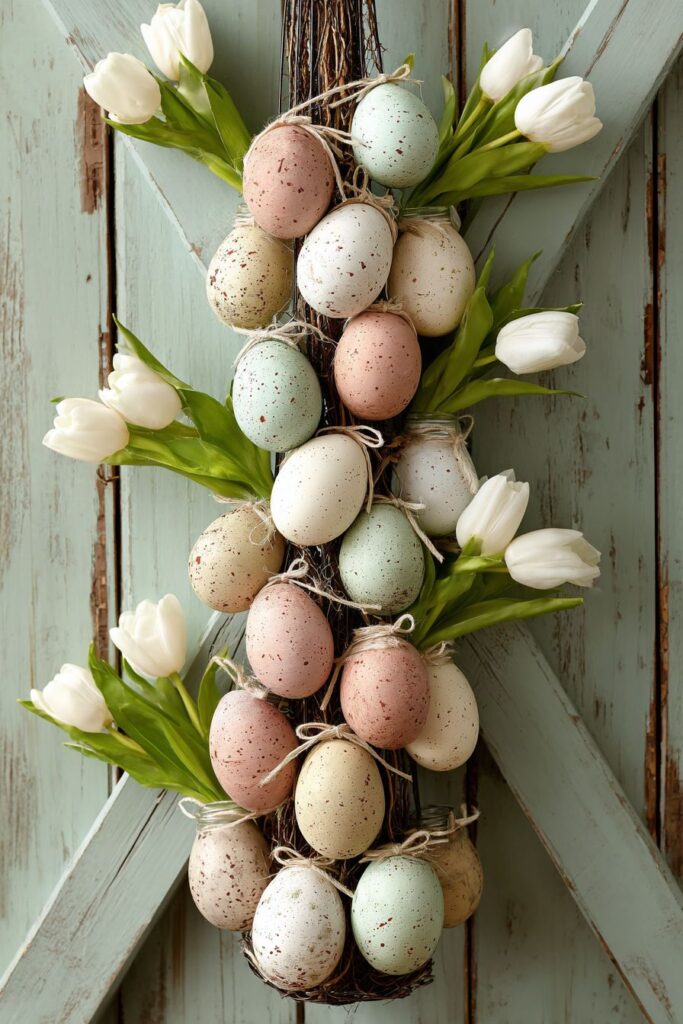
The farmhouse-style door with X-brace detail provides the perfect architectural backdrop for this casual-elegant decoration. The X-brace pattern creates visual interest and structural lines that complement the basket’s geometric form, while the door’s rustic character harmonizes with the natural, handcrafted elements of the decoration. This careful consideration of how decorative elements relate to architectural features demonstrates design maturity and creates a cohesive overall aesthetic. The presence of fresh tulips adds the bonus of natural fragrance, engaging multiple senses and creating a truly immersive spring welcome.
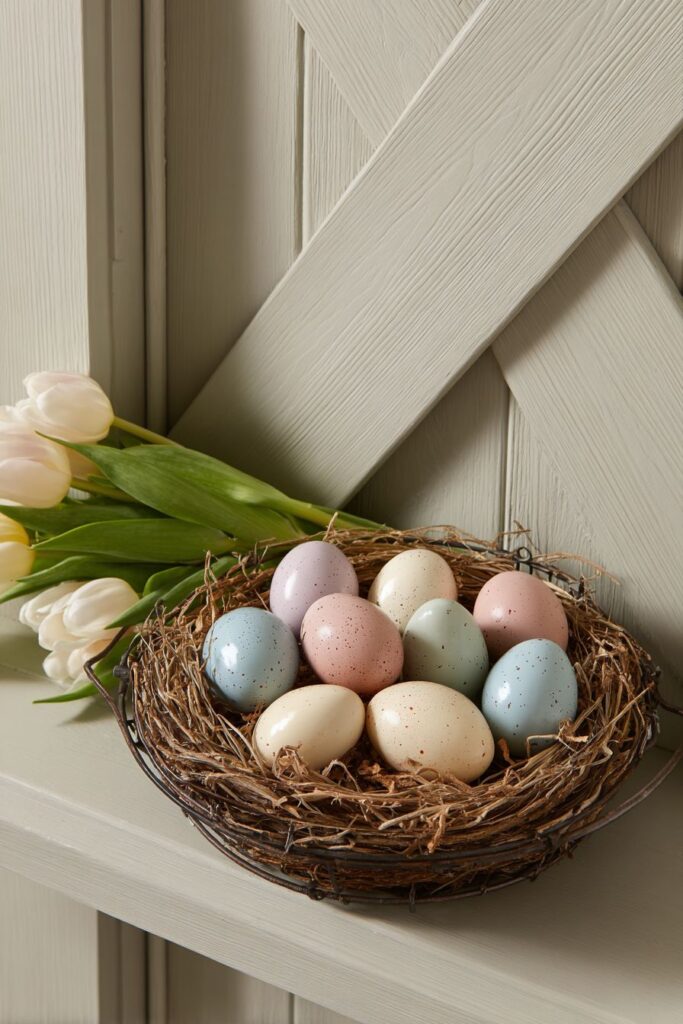
Wide-angle interior design photography captures the full door composition, revealing how the central basket and flanking tulips create balanced symmetry. Morning light creates gentle highlights on the ceramic egg surfaces, emphasizing their hand-painted details and smooth glazed finish. This fresh, spring-like quality elevates the decoration beyond simple seasonal decor into a celebration of nature’s renewal and the joy of handcrafted beauty.
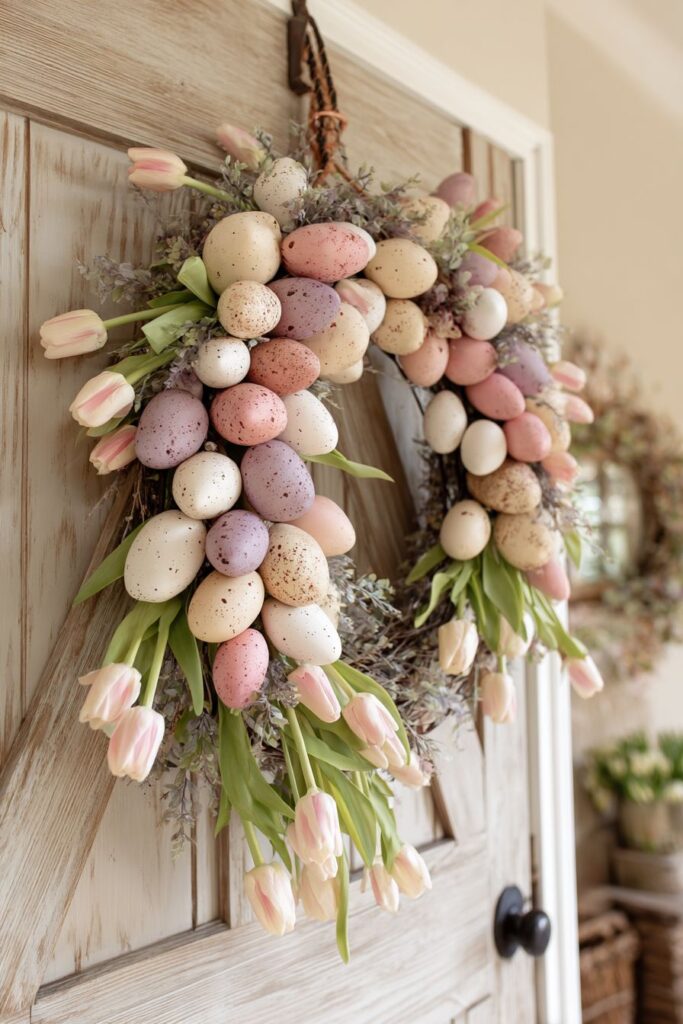
Key Design Tips:
- Paint ceramic eggs with acrylic paint in complementary patterns for artistic cohesion
- Select a wire basket with openings small enough to prevent eggs from falling through
- Use water-tight inserts in mason jars to maintain tulip freshness throughout the season
- Arrange tulips at varying heights within jars for natural, garden-picked appearance
- Refresh tulip water every 2-3 days and trim stems to maximize flower longevity
13. Abundant Mixed Bloom Spring Wreath
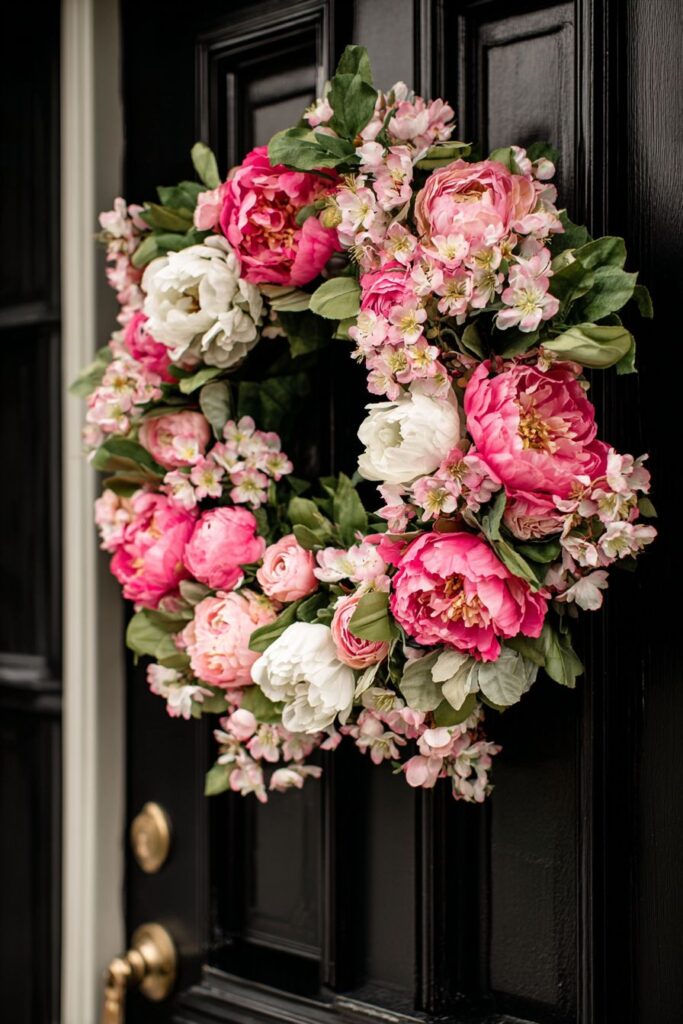
A lush, flower-focused wreath makes a bold statement for Easter, celebrating the season’s floral abundance with unrestrained enthusiasm. This abundant mixed bloom wreath features realistic faux peonies, ranunculus, and cherry blossoms in varying shades of pink and white, creating a romantic, garden-inspired composition. The combination of different flower types provides varied petal shapes and bloom sizes that add visual complexity and prevent monotony. Soft green leaves interspersed throughout provide natural contrast and visual resting points that allow the eye to appreciate the individual flowers without becoming overwhelmed by the abundance.
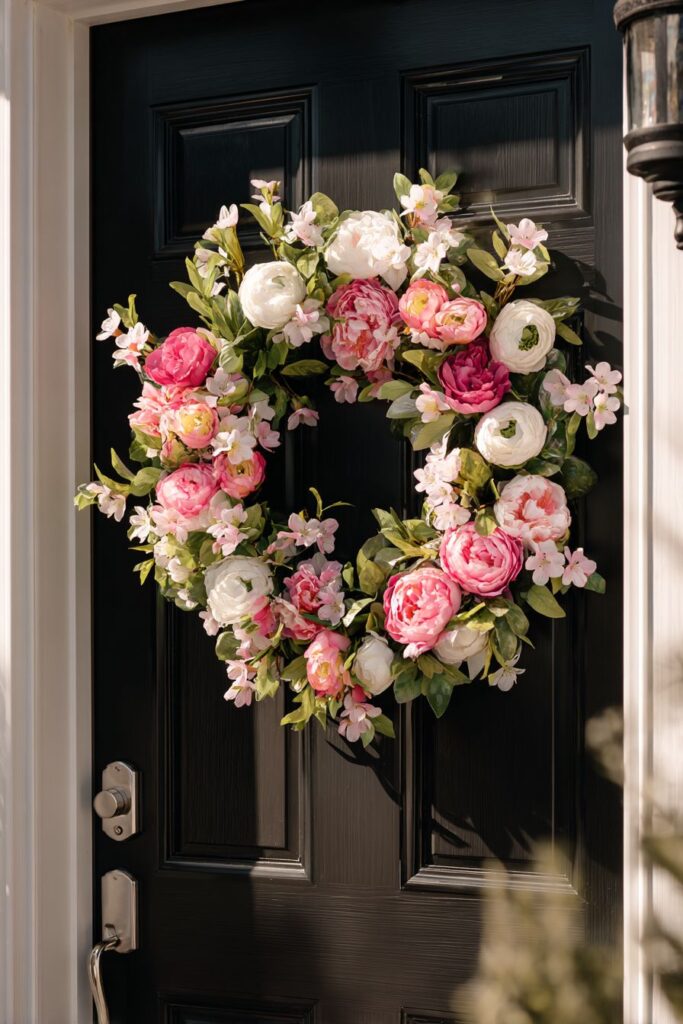
The layering technique used in constructing this wreath creates depth and dimension that makes the decoration appear fuller and more luxurious. By placing larger peony blooms deeper in the composition and allowing smaller cherry blossoms to extend outward, the wreath achieves a three-dimensional quality that captures the natural growth patterns of a spring garden. When displayed against a classic black painted door, the pink and white flowers create dramatic contrast that makes them appear to glow against the dark background. This color relationship demonstrates the power of backdrop selection in maximizing decorative impact.
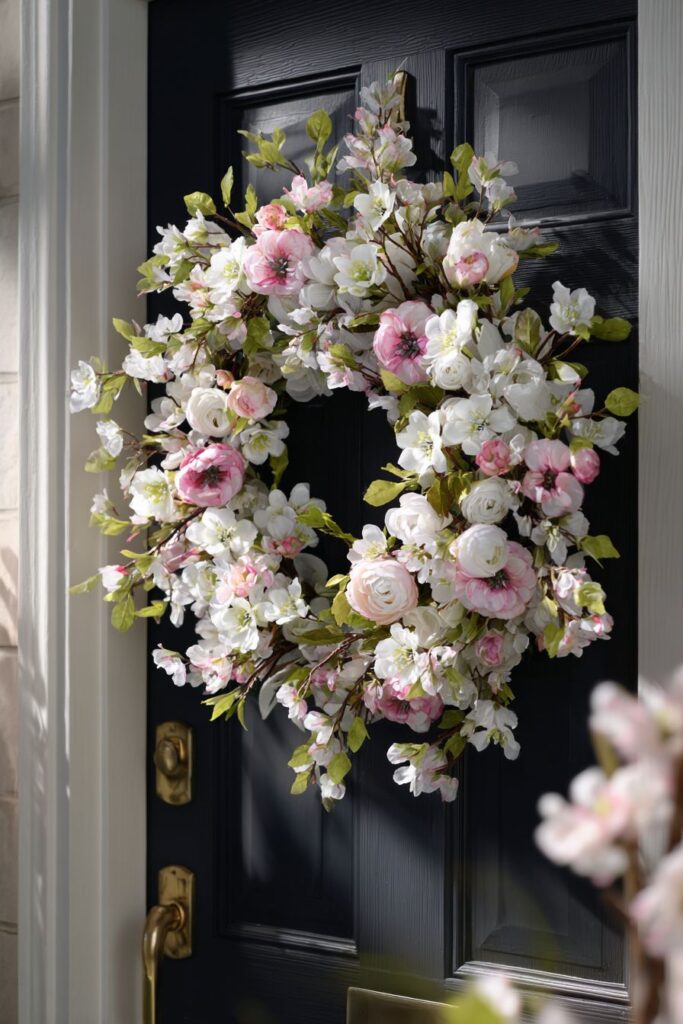
Architectural photography style with balanced exposure captures the lush, dimensional quality of the florals, while natural lighting highlights individual petal textures and creates depth through subtle shadowing. The realistic quality of the faux flowers becomes apparent through proper lighting, which reveals the delicate veining in petals and the soft color gradations that mimic nature’s perfection. This flower-focused approach to Easter decorating appeals to garden enthusiasts and anyone who appreciates the romantic beauty of spring blooms.
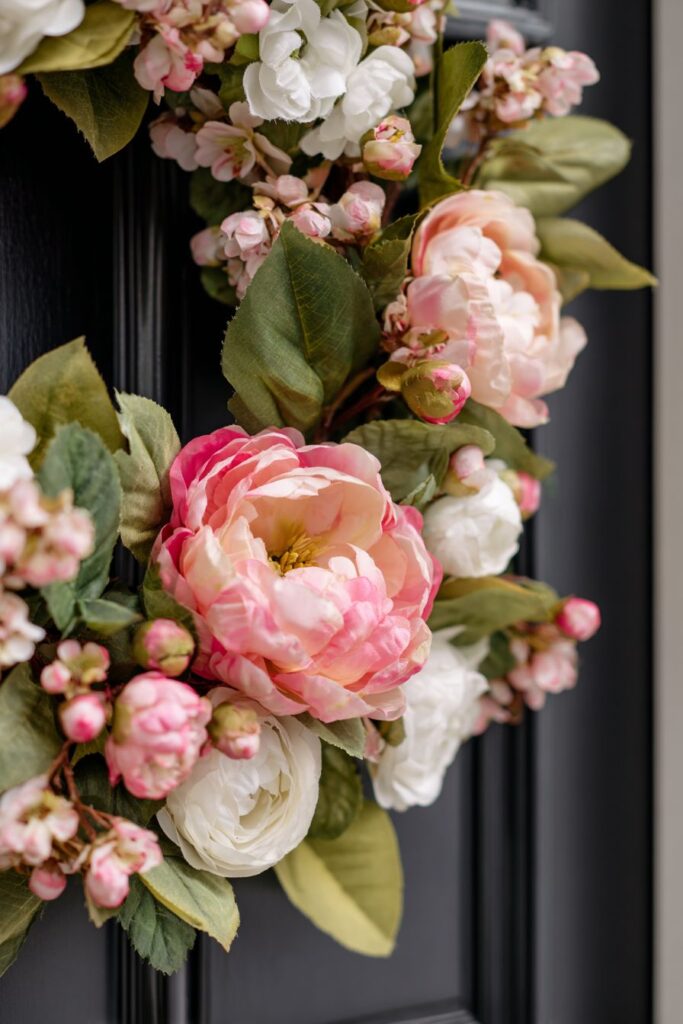
Key Design Tips:
- Build wreath from inside out, starting with largest blooms at the base layer
- Vary flower orientation so blooms face different directions for natural appearance
- Select high-quality silk flowers with realistic petal texture and color variation
- Group same flower types in odd-numbered clusters for organic visual flow
- Ensure wreath density is sufficient that the form underneath is completely concealed
14. Rustic Wooden Welcome Sign with Fresh Greenery
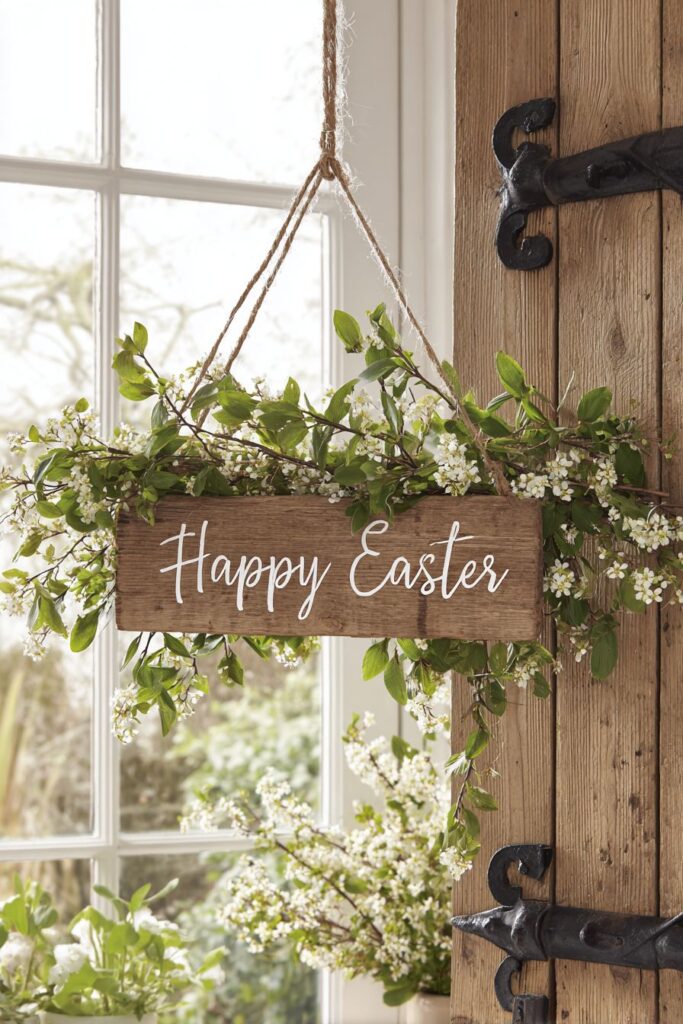
A personalized welcome sign adds warmth and hospitality to Easter door decorations, inviting guests to share in your seasonal celebration. This rustic wooden sign reading ‘Happy Easter’ in hand-painted script combines traditional messaging with handcrafted charm. The visible wood grain and rustic finish create authentic farmhouse appeal, while the flowing script lettering adds elegance and personality. Suspended from simple jute rope, the sign achieves effortless integration with a garland of fresh greenery and small white blooms that frame the message beautifully. This combination of text and botanical elements creates a complete composition that communicates both message and mood.
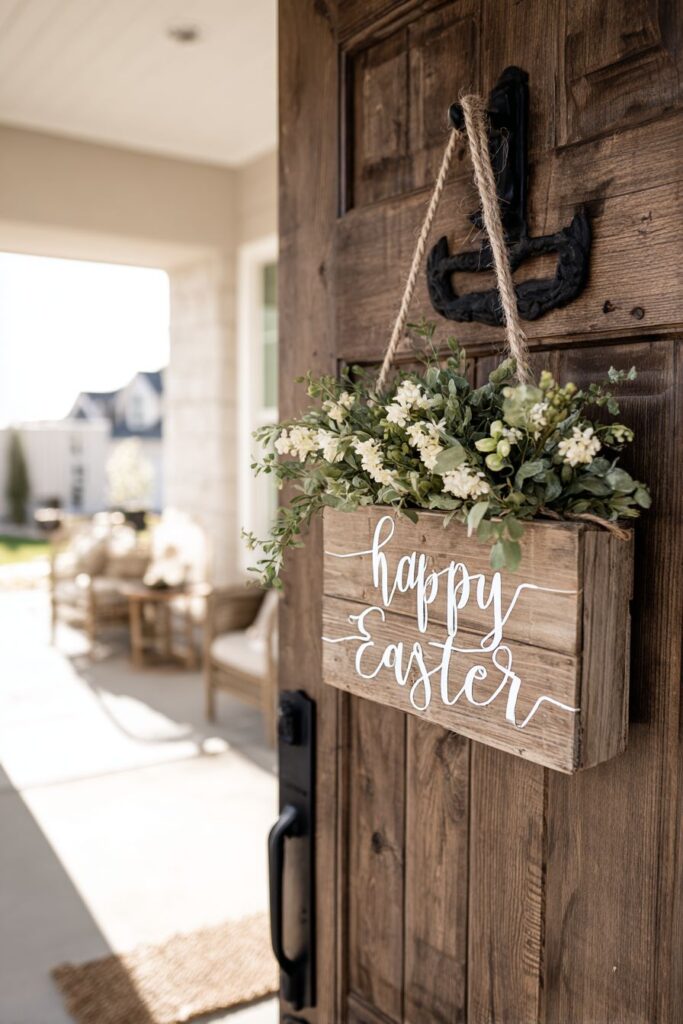
The use of fresh greenery introduces living texture and subtle movement as air currents cause gentle swaying, adding dynamic quality to the static sign. Small white blooms punctuating the greenery garland provide delicate detail and reinforce the spring theme without overwhelming the primary message. When displayed on a stained wood door with iron hardware, the decoration creates perfect tonal harmony—the stained door and rustic sign sharing warm wood tones while the iron hardware complements the natural jute rope. This cohesive material and color relationship demonstrates thoughtful design planning that considers every element’s relationship to its context.
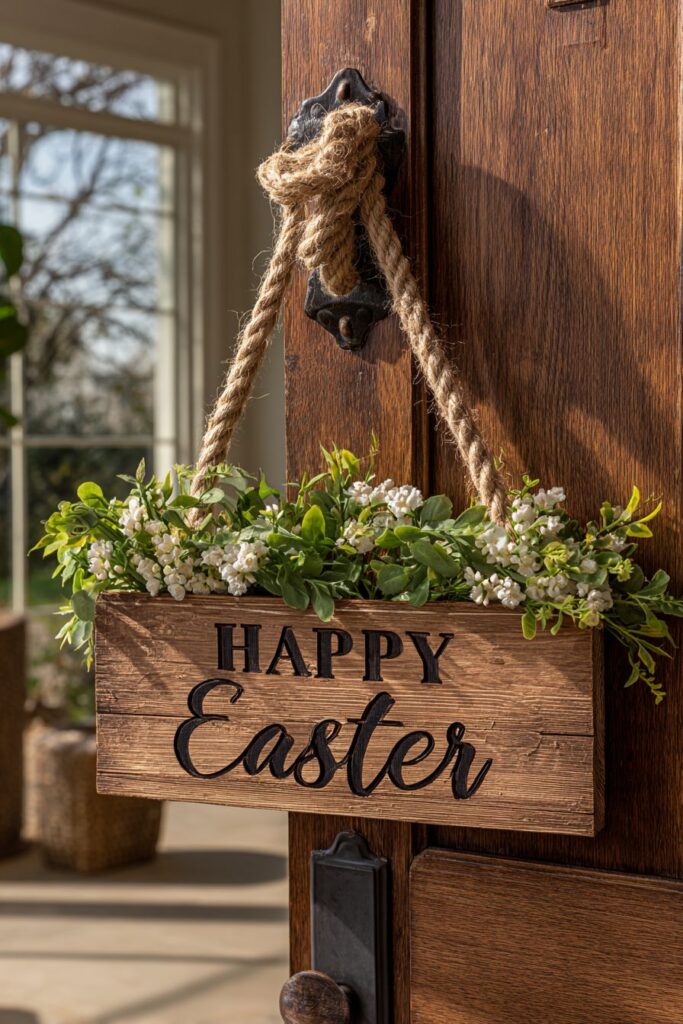
Interior design photography with focus on the handcrafted lettering and organic materials reveals the authentic quality that makes this decoration special. Natural daylight streaming across the sign emphasizes the wood grain and paint texture, creating depth through highlighting and shadow. The inviting farmhouse aesthetic created by this combination of elements makes guests feel immediately welcome and sets a warm, approachable tone for your home.
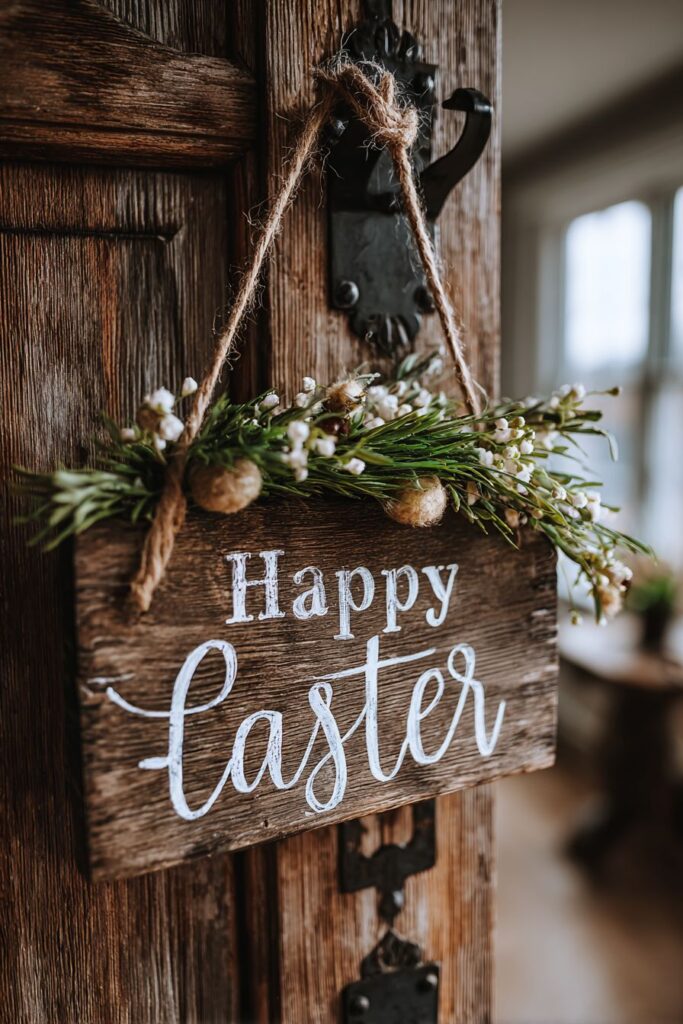
Key Design Tips:
- Practice lettering on paper before painting on wood to ensure proper sizing and spacing
- Use white chalk to sketch letters lightly on wood before painting for erasable guidelines
- Seal painted sign with outdoor polyurethane to protect from weather elements
- Wire fresh greenery to jute rope at multiple points for secure attachment
- Hang sign at eye level for optimal message readability from door’s approach
15. Asymmetrical Eucalyptus Swag with Pastel Accents
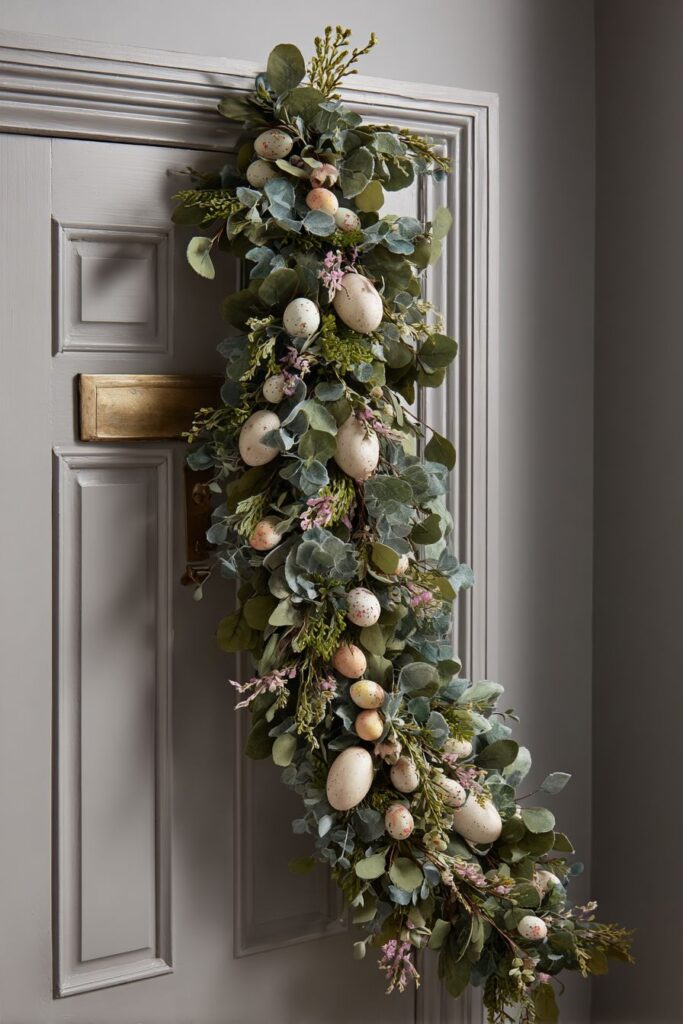
Breaking away from symmetrical wreath traditions, this garland-style swag creates dynamic visual interest through intentional asymmetry. Draped from the door’s upper corner, the arrangement features eucalyptus, lamb’s ear, and pastel ribbon woven throughout, creating a flowing organic composition that suggests natural growth and spontaneous beauty. The silver-green eucalyptus provides aromatic elegance and contemporary botanical appeal, while lamb’s ear introduces soft, velvety texture that invites touch. Pastel ribbon in coordinating tones weaves through the greenery, adding color pops and helping to unify the various elements into a cohesive design.
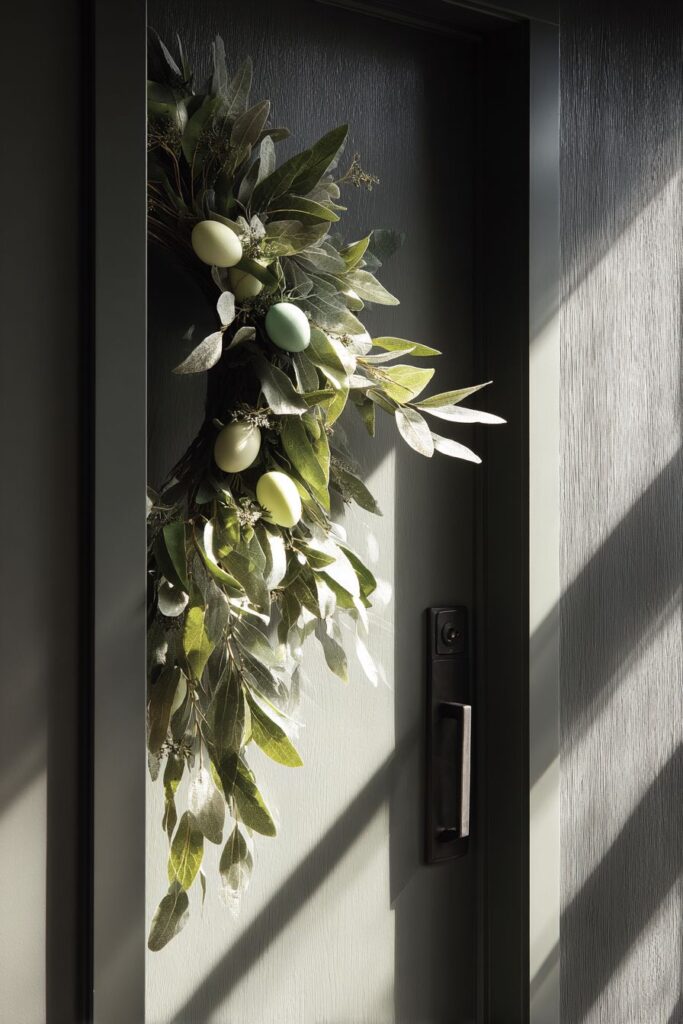
Small decorative eggs tucked within the greenery provide seasonal recognition without overwhelming the botanical focus. Their strategic placement creates visual discoveries—unexpected touches that reward closer inspection and add layers of interest to the overall composition. When displayed on a painted grey door with modern hardware, the decoration achieves contemporary sophistication that feels fresh and current. The asymmetrical arrangement creates visual movement that guides the eye across the door’s surface, making the entrance feel dynamic and alive.
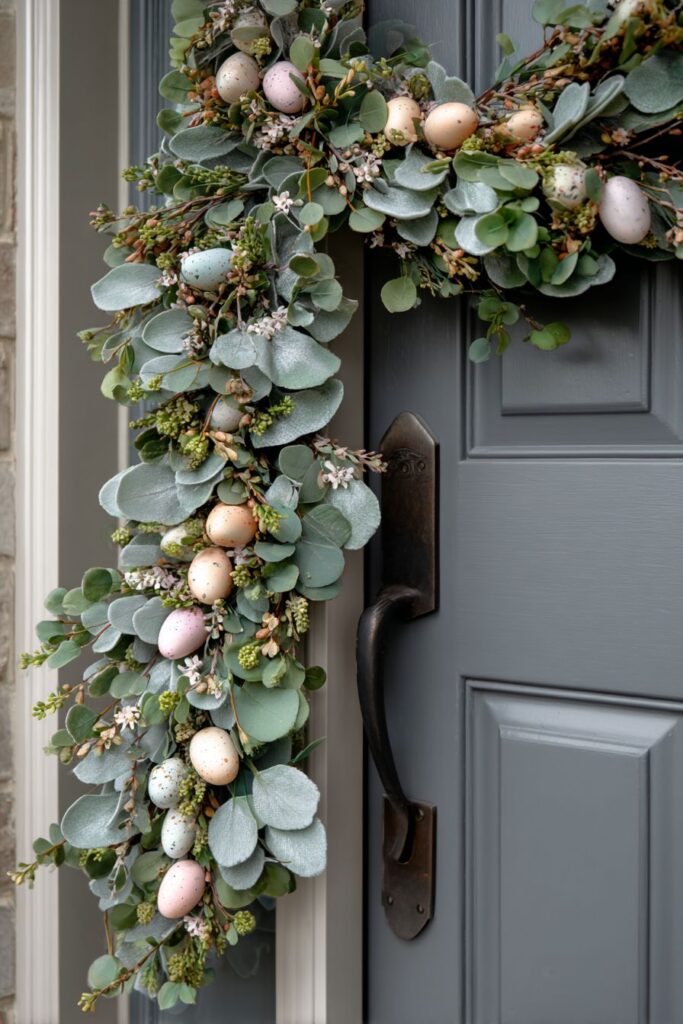
Professional interior photography captures the flowing, organic arrangement, with soft natural lighting highlighting the varied leaf textures and creating natural shadows that add dimension to the cascading design. The interplay between the structured eucalyptus stems, soft lamb’s ear leaves, and flowing ribbon creates textural complexity that maintains interest across the entire swag length. This modern approach to Easter decorating demonstrates how breaking traditional symmetry can create more dynamic, visually engaging results.
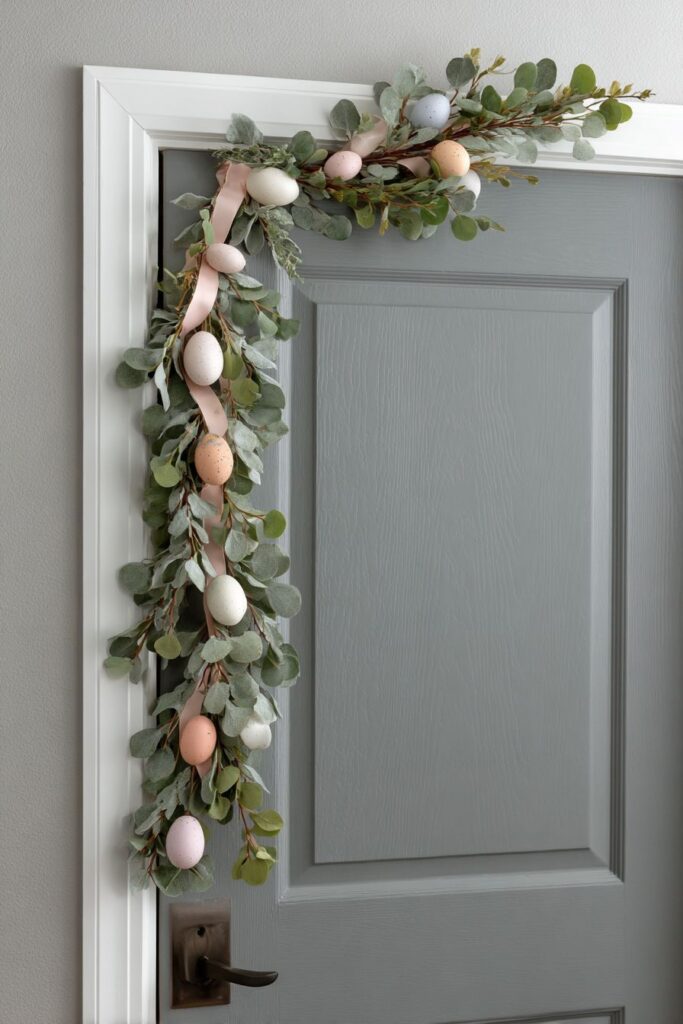
Key Design Tips:
- Start swag attachment at upper corner and allow natural gravity to create organic drape
- Vary greenery density from thick at the attachment point to sparse at the tail
- Weave ribbon through greenery rather than wrapping it for integrated appearance
- Tuck eggs into greenery pockets where stems naturally create holding spaces
- Use floral wire at key points to guide swag direction while maintaining organic appearance
16. Tiered Basket Vertical Display
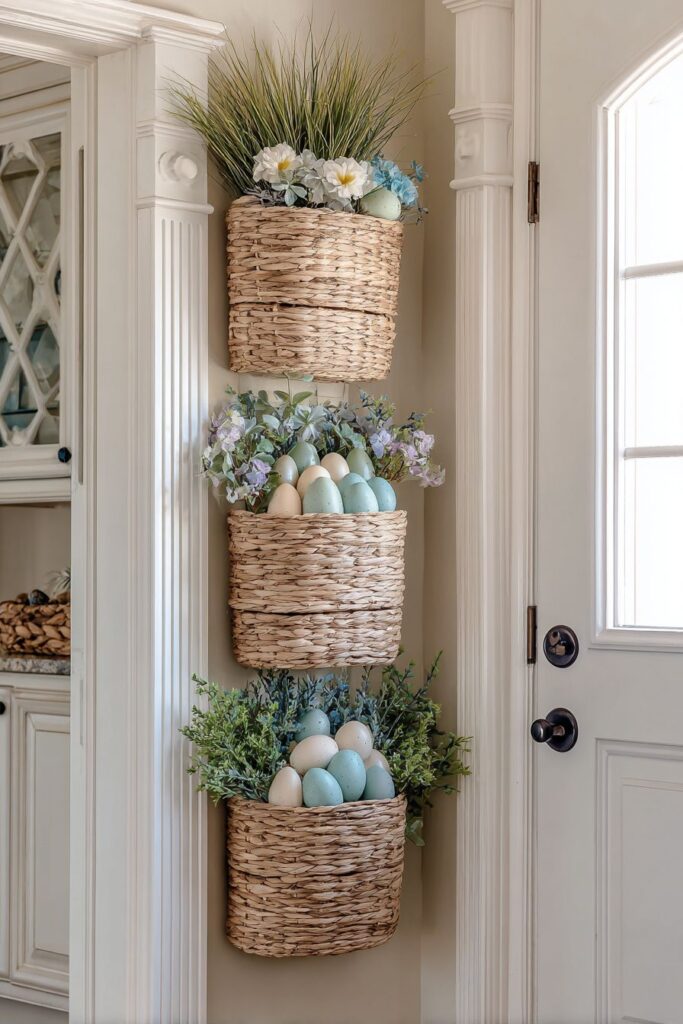
This innovative tiered basket approach reimagines Easter door decorations through creative vertical arrangement and practical organization. Three baskets mounted vertically create distinct zones, each filled with coordinating elements that work together to tell a complete story. The top basket filled with eggs provides immediate seasonal recognition, the middle basket overflowing with fresh flowers introduces color and organic beauty, while the bottom basket filled with greenery grounds the composition and provides visual weight. This storage-inspired design demonstrates how practical organization principles can inform creative decorating, resulting in a display that’s both beautiful and conceptually interesting.
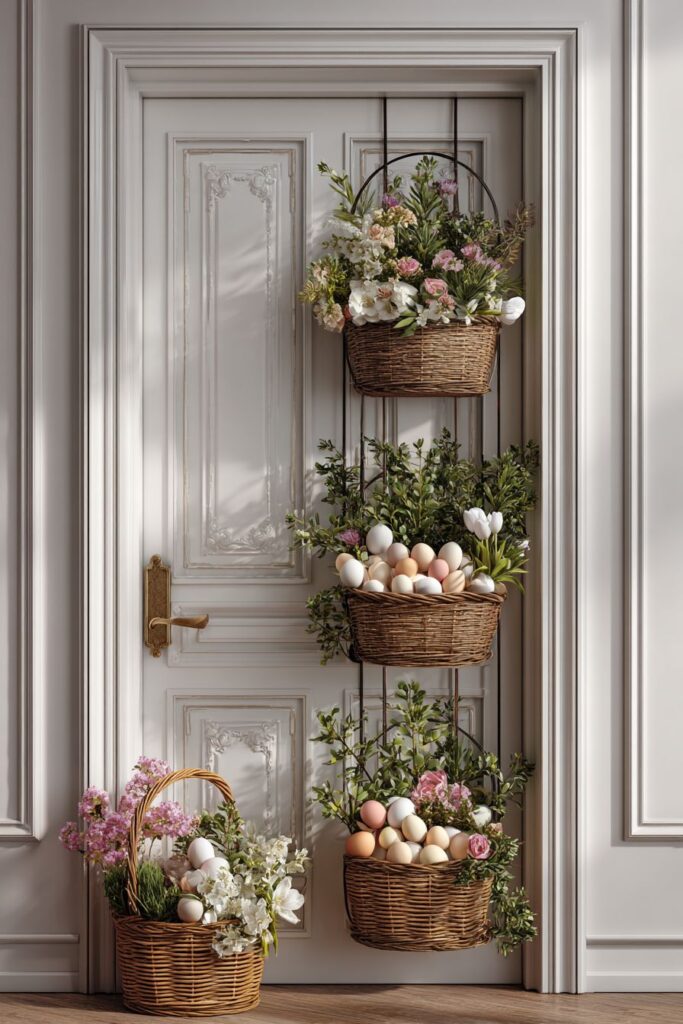
The cohesive pastel color scheme unifies the three distinct basket zones, creating visual flow that carries the eye from top to bottom. Careful color coordination ensures that eggs, flowers, and greenery share complementary tones that work harmoniously despite their different textures and forms. When displayed on a white paneled door with decorative molding, the vertical basket arrangement creates architectural interest that complements the door’s existing details. The white background allows the pastel colors to appear soft and fresh, while the door’s paneling provides subtle visual structure that enhances the composition.
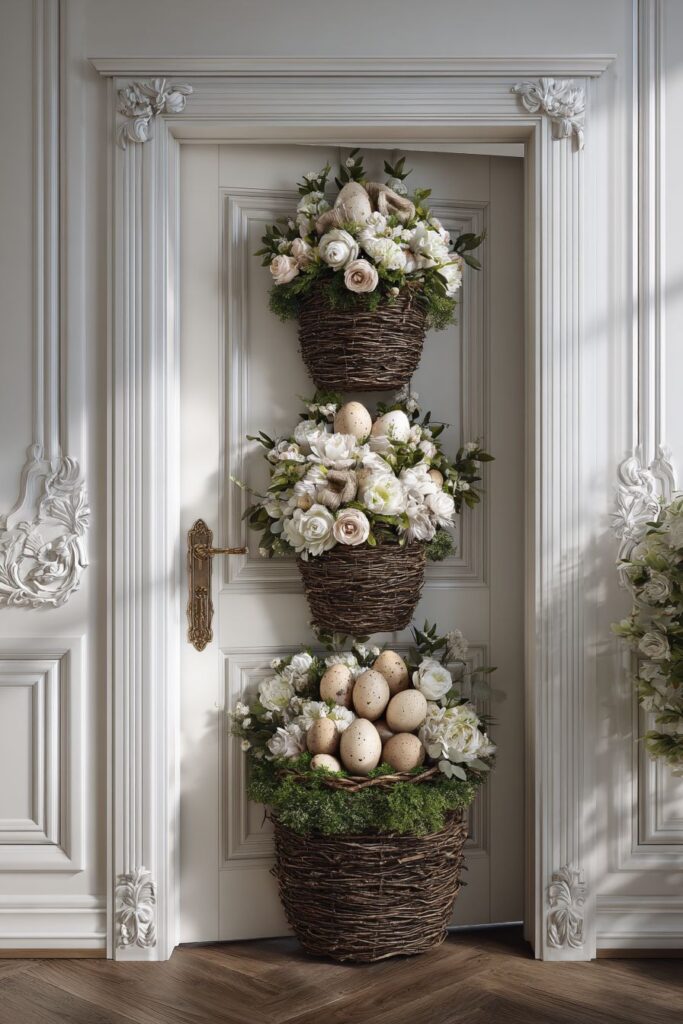
Wide-angle interior design photography captures the complete vertical arrangement, revealing how the tiered design creates height and visual interest. Balanced natural lighting emphasizes the varied textures of basket weave, delicate flower petals, and smooth painted eggs, while highlighting the practical storage-inspired design concept. This creative approach to Easter decorating appeals to those who appreciate innovative thinking and enjoy decorations that combine beauty with conceptual depth.
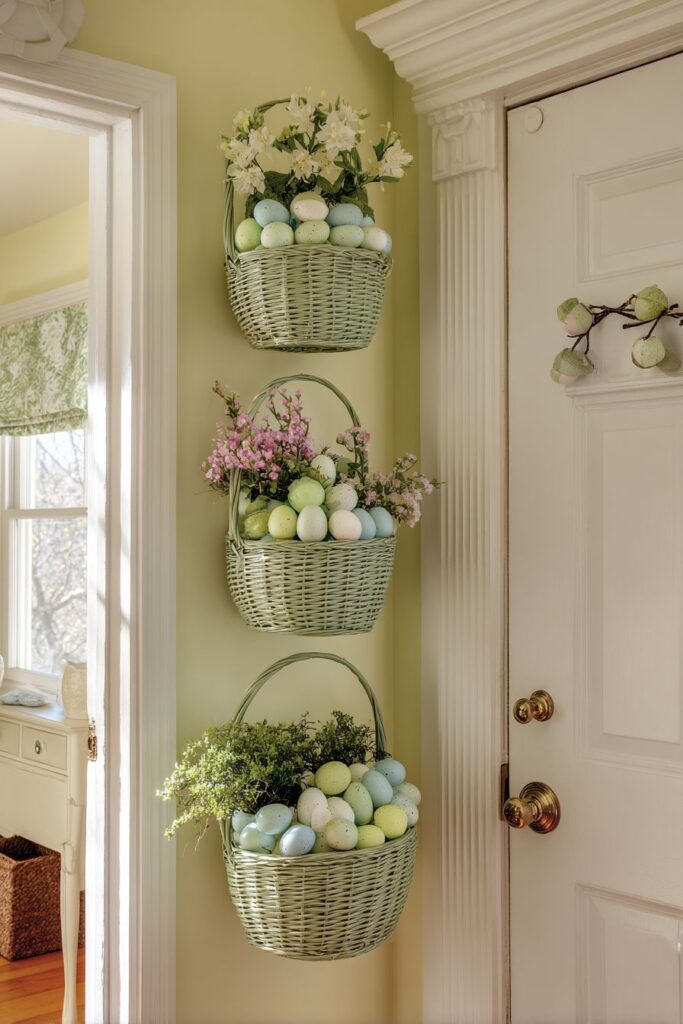
Key Design Tips:
- Select baskets of graduated sizes to create visual proportion and dimensional interest
- Secure baskets with heavy-duty hooks rated for outdoor use and combined weight
- Fill baskets strategically, placing heavier items in bottom basket for stability
- Coordinate egg colors, flower tones, and greenery shades within same pastel family
- Add moss or raffia to baskets as filler to hide mechanics and add natural texture
17. Monochromatic White Tonal Wreath
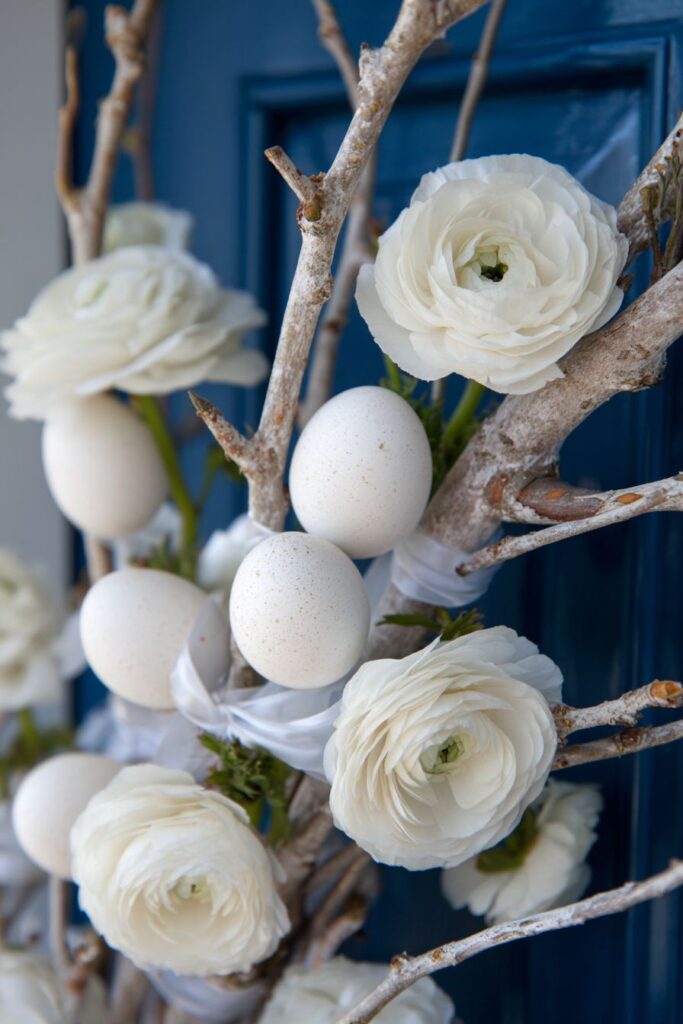
The sophistication of monochromatic design finds beautiful expression in this all-white Easter door decoration. A bleached twig wreath provides organic foundation, its pale color achieved through careful bleaching that removes natural brown tones while preserving wood texture. Adorned with white ranunculus, painted white eggs, and cream satin ribbon, the wreath celebrates subtle texture variations rather than color contrast. This tonal approach creates visual interest through varied materials and surface treatments—the matte painted eggs contrasting with glossy ribbon, rough twig texture playing against smooth petals. The discipline required to limit the palette this severely results in a refined, sophisticated design that demonstrates design maturity.
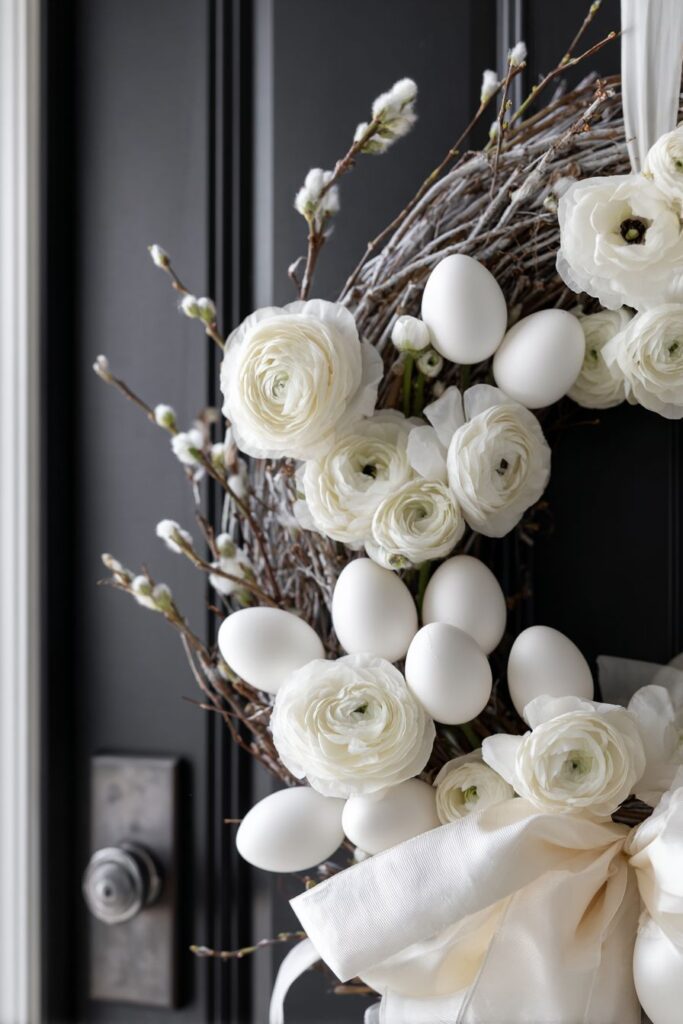
When displayed against a navy blue front door, the monochromatic white decoration creates dramatic contrast that makes each element appear to glow against the dark background. This color relationship transforms what could be a subtle design into a bold statement piece that commands attention. The navy backdrop also helps viewers appreciate the subtle variations within the white palette—cream, ivory, pure white, and chalk all become distinct when viewed against the saturated blue. This understanding of how backdrop color affects decoration perception demonstrates sophisticated design thinking.
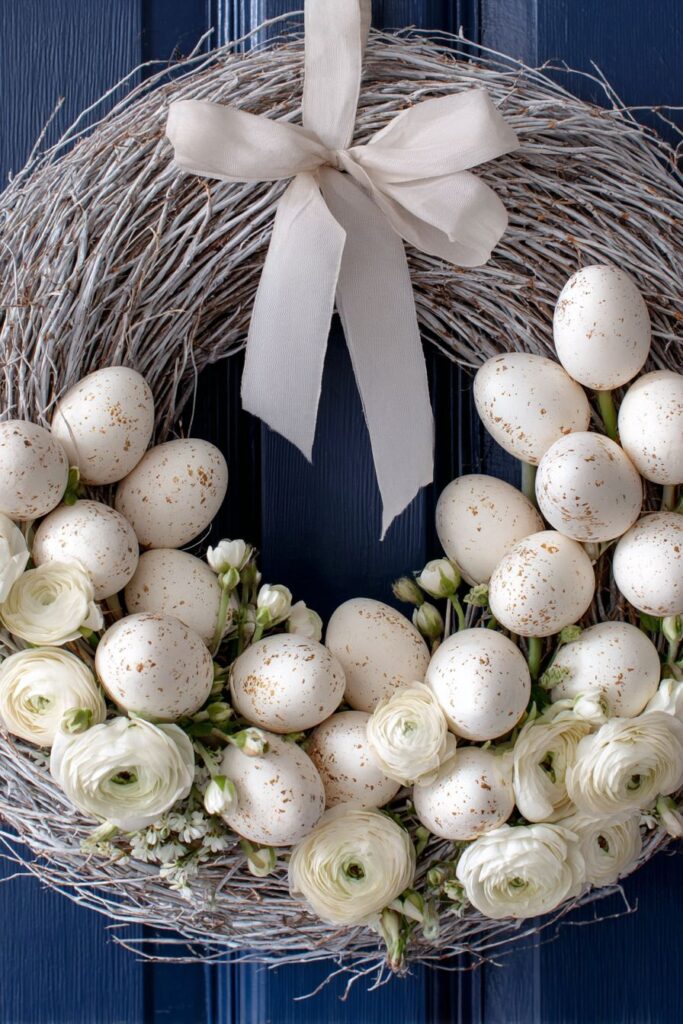
Interior design photography with emphasis on tonal variations within the white palette reveals the different textures and surfaces that create interest. Natural lighting highlights the interplay between matte paint, glossy ribbon, and natural wood, creating sophisticated depth despite the minimal color scheme. The varied surface treatments—from the rough bleached twigs to the smooth porcelain-like eggs to the lustrous satin ribbon—create visual complexity that rewards careful observation. This monochromatic approach proves that limitation can inspire creativity, resulting in a design that’s both minimalist and richly textured.
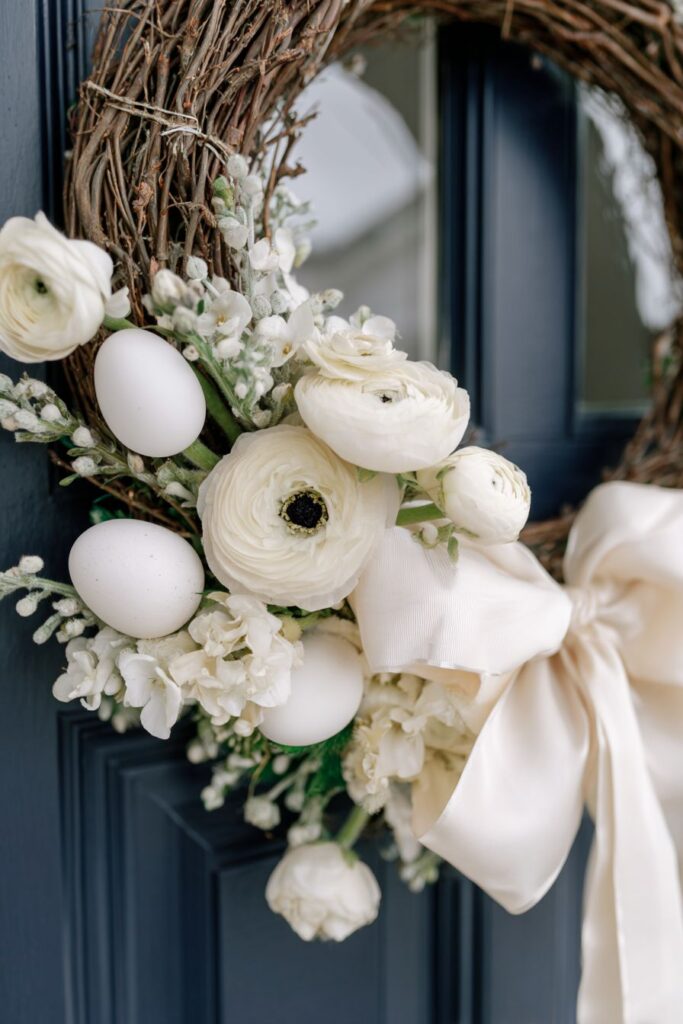
Key Design Tips:
- Bleach twig wreath gradually with diluted solution to achieve pale tone without brittleness
- Select white flowers with textured petals like ranunculus for added visual interest
- Paint eggs in different white finishes (matte, satin, gloss) for surface variation
- Choose cream ribbon rather than pure white to add subtle warmth and prevent flatness
- Position wreath to maximize contrast against dark door for dramatic visual impact
18. Vintage-Inspired Preserved Flower Wreath
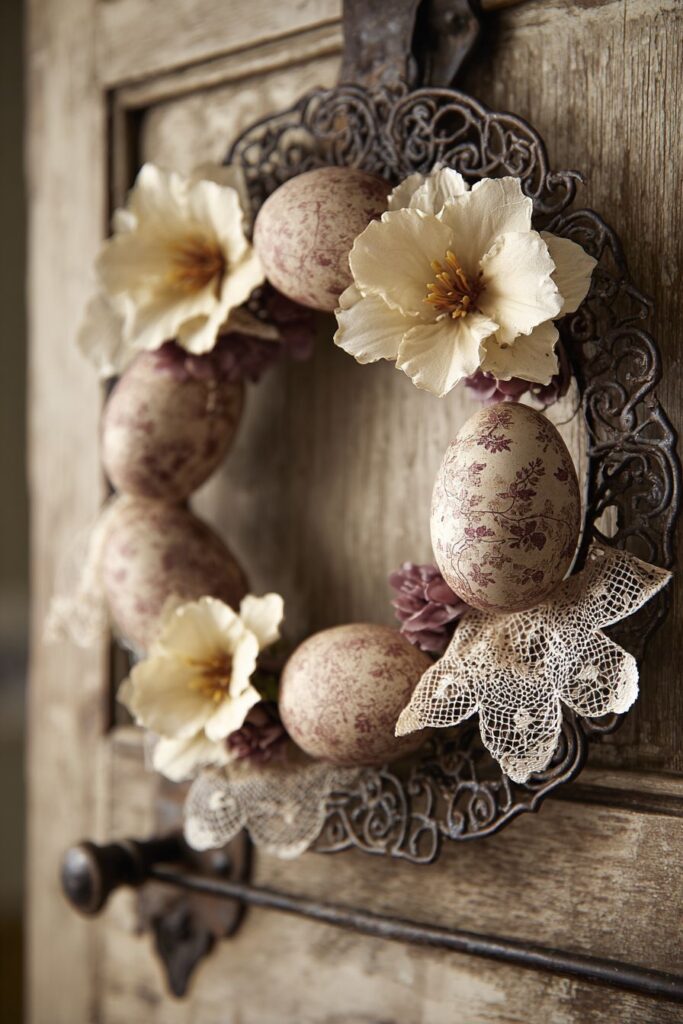
Nostalgia and romance combine in this vintage-inspired Easter door decoration that celebrates the gentle beauty of aged materials and time-worn finishes. An antique-finish metal frame wreath provides structural elegance with its ornate curves and deliberately aged patina. Holding preserved flowers in soft, muted colors, the frame becomes a showcase for botanical beauty that’s been captured and suspended in time. Vintage-style paper eggs featuring delicate patterns add period-appropriate detail, their aged appearance suggesting they’ve been treasured and brought out each Easter for generations. Aged lace ribbon introduces textile softness and romantic detail that completes the nostalgic aesthetic.
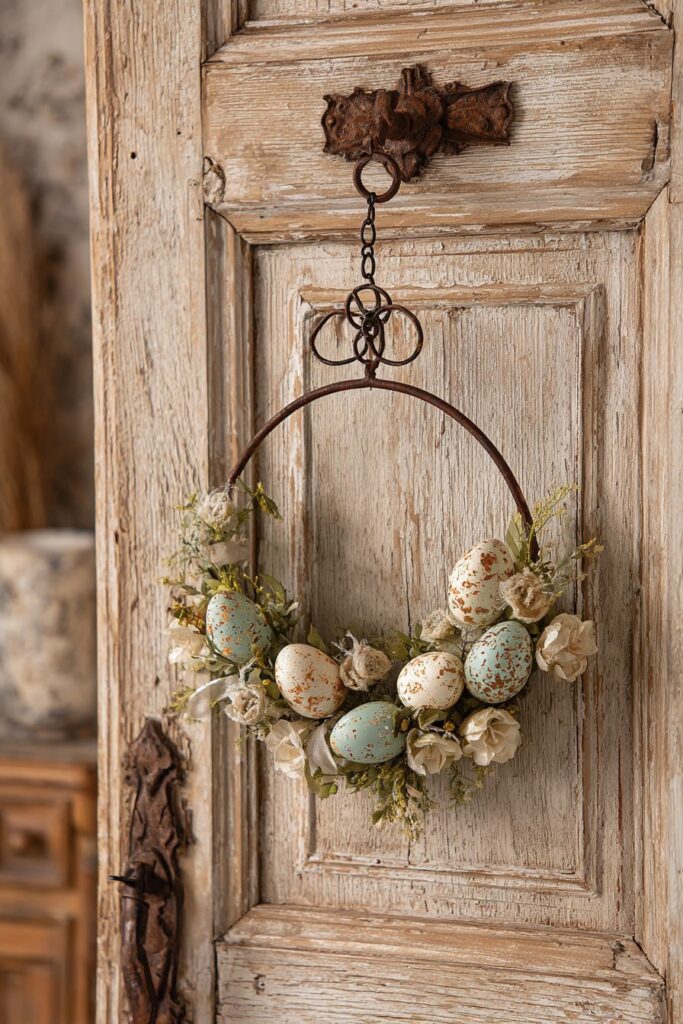
The deliberately muted color palette—soft, faded tones rather than vibrant hues—creates the impression of gentle aging and historical authenticity. These colors appear as though sunlight has softly bleached them over years, adding character and depth that bright, new colors cannot achieve. When displayed on a weathered wooden door with original hardware showing authentic patina, the decoration achieves perfect harmony with its architectural context. The shared quality of authentic aging creates visual cohesion that makes the decoration appear to have always belonged in this location.
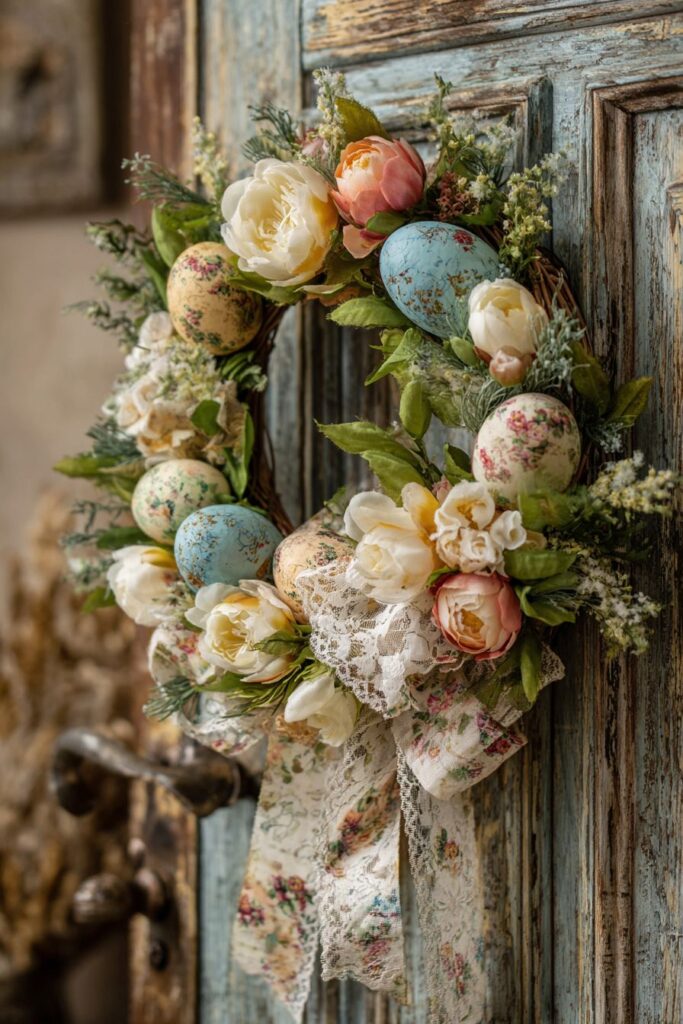
Professional interior photography capturing the nostalgic aesthetic reveals how soft diffused lighting enhances the aged quality of materials and subtle color fading. The gentle illumination emphasizes authentic vintage textures and wear patterns that give the decoration its character and charm. This vintage-inspired approach appeals to those who appreciate historical design, romantic aesthetics, and the beauty found in objects that carry stories and history.
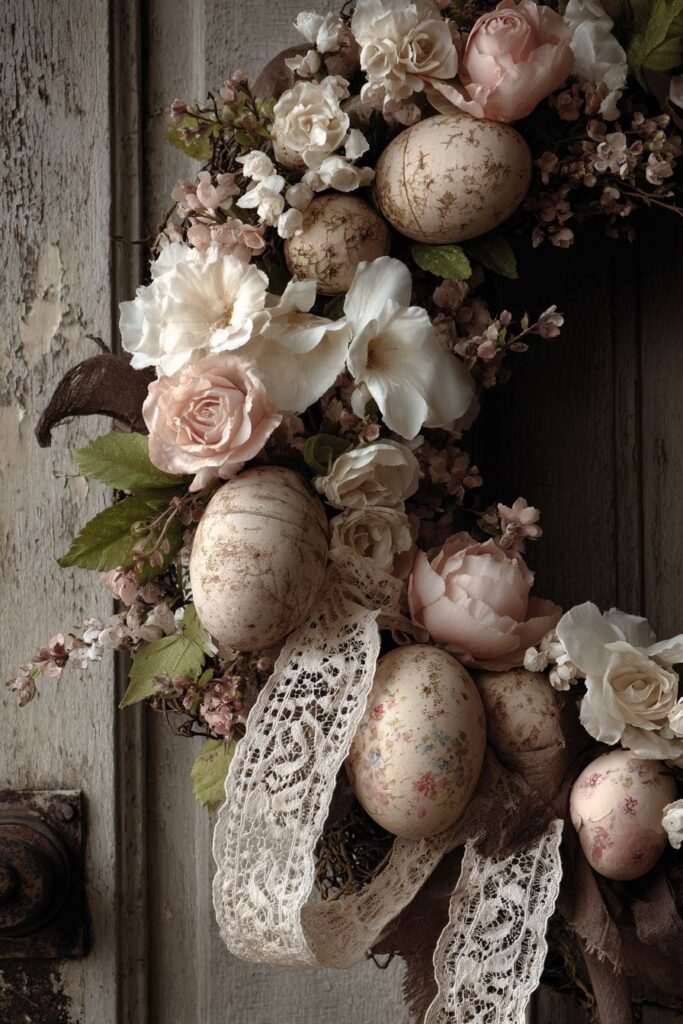
Key Design Tips:
- Age metal frame artificially using vinegar solution or specialized patina products
- Select preserved flowers that dry well and maintain structure, like roses and hydrangeas
- Create vintage paper eggs using tea-staining technique and antique pattern transfers
- Choose lace ribbon with genuine vintage feel, even if it’s new production
- Display in location with some protection from weather to preserve aged materials
19. Single Statement Peony Wreath
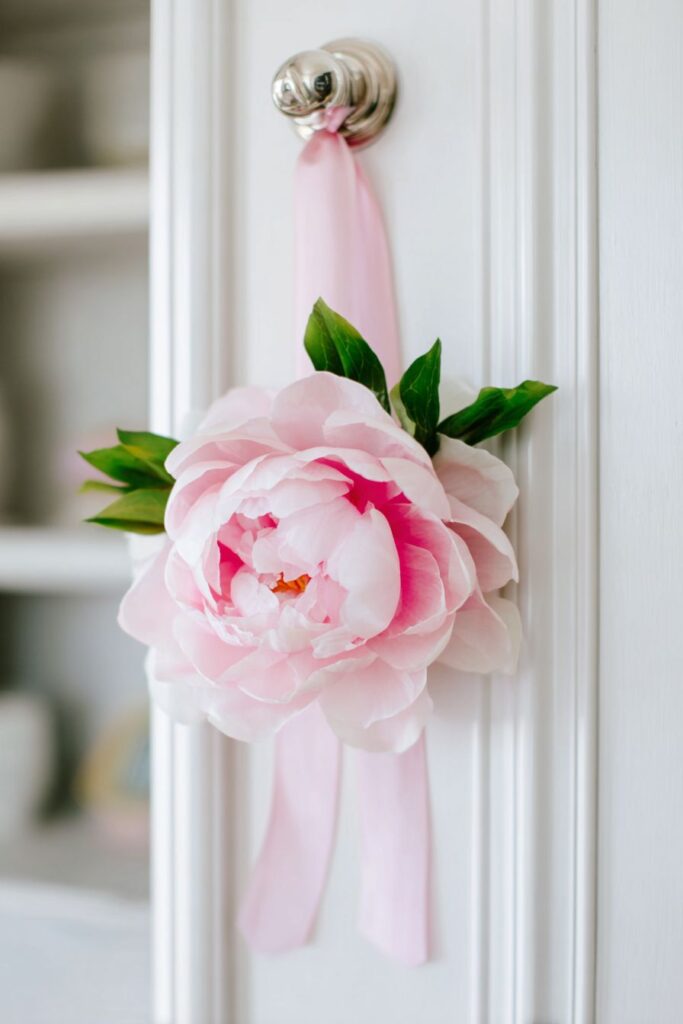
The power of restraint manifests beautifully in this simple elegant design featuring a single oversized pastel pink peony bloom. Rather than competing elements and busy arrangements, this decoration celebrates the perfect beauty of one exceptional flower. The realistic silk peony, chosen for its size and lifelike quality, creates immediate impact through scale and delicate coloring. Minimal greenery surrounding the bloom provides just enough context to ground the flower without detracting from its starring role. A wide grosgrain ribbon in complementary blush tone suspends the wreath while adding subtle texture and reinforcing the sophisticated color palette.
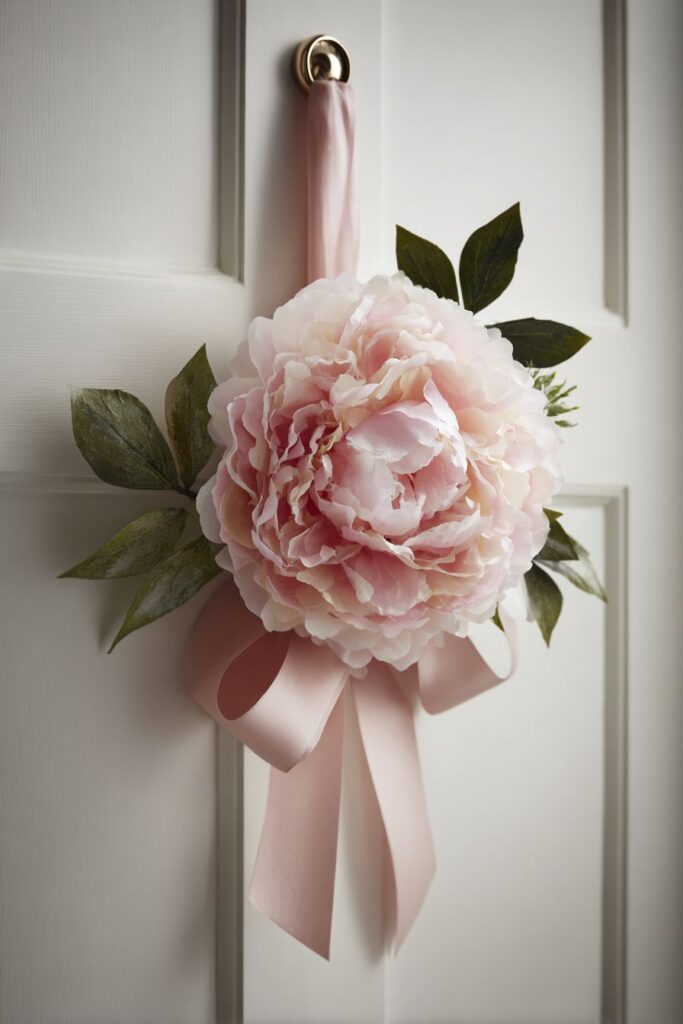
This clean, uncluttered design demonstrates advanced design principles—the confidence to let a single beautiful element speak without embellishment, the understanding that negative space enhances rather than diminishes impact, and the sophistication to recognize when more would be less. When displayed against a modern white door with contemporary hardware, the decoration achieves gallery-like presentation that showcases the peony as a work of art. The minimalist approach creates a zen-like calm and allows viewers to fully appreciate the flower’s intricate petal structure and subtle color variations.

Architectural digest style photography with crisp focus and even natural lighting showcases the sophisticated simplicity that makes this design special. Detail shots emphasizing the realistic petal texture reveal the quality of the single statement piece—when you’re using only one element, it must be exceptional. This approach to Easter decorating appeals to modernists, minimalists, and anyone who appreciates the Japanese aesthetic principle that less is more, that perfection is achieved not when there’s nothing left to add, but when there’s nothing left to take away.
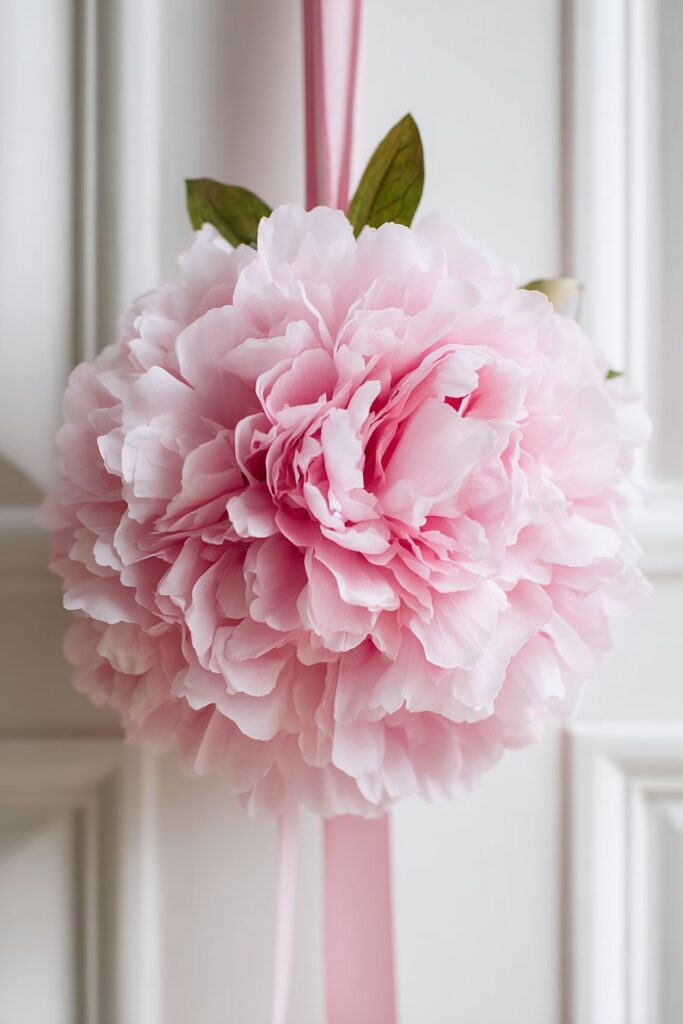
Key Design Tips:
- Invest in the highest quality silk peony available, as it’s the sole focal point
- Choose peony in full bloom stage for maximum visual impact and petal display
- Select grosgrain ribbon at least 2 inches wide for proper visual weight
- Position peony slightly off-center within wreath form for dynamic composition
- Limit greenery to 2-3 perfect leaves that complement rather than compete with bloom
20. Natural Birch Branch Lattice with Garden Elements
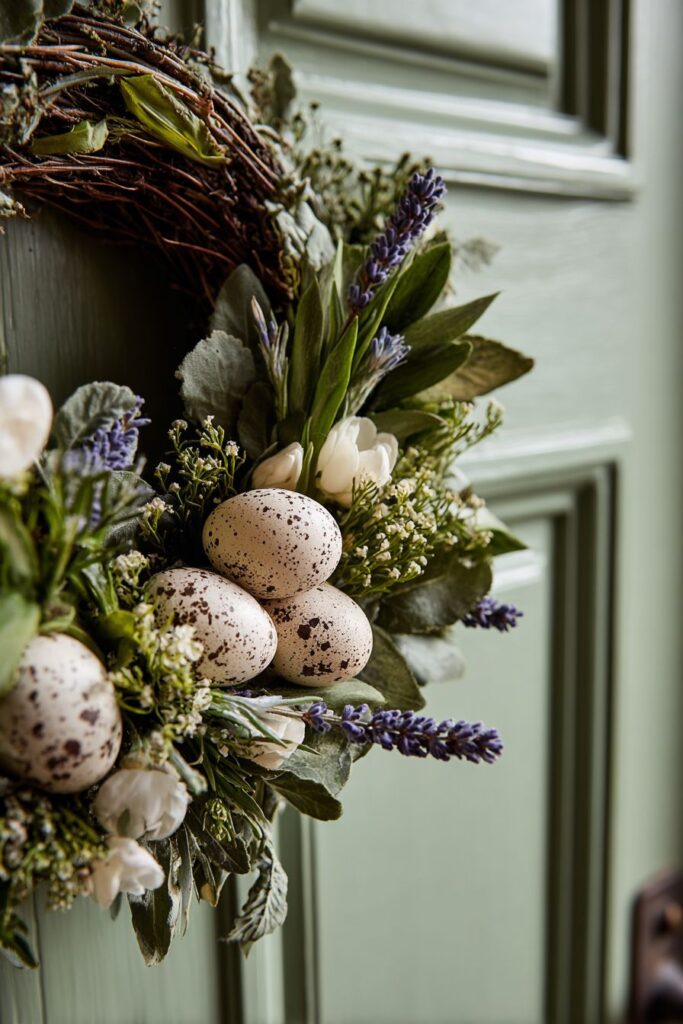
This artistic interpretation of Easter door decorations celebrates organic architecture and garden-fresh beauty through unexpected material combinations. A natural birch branch cross-hatch pattern serves as the structural base, its white bark and dark markings creating graphic interest while maintaining natural authenticity. The lattice arrangement creates geometric order from organic materials, demonstrating how nature’s elements can be organized into intentional design. Interwoven with fresh lavender stems, the structure gains aromatic appeal and soft purple color that introduces spring’s gentle palette. Small quail eggs and delicate baby’s breath add seasonal touches while maintaining the overall natural, garden-inspired aesthetic.
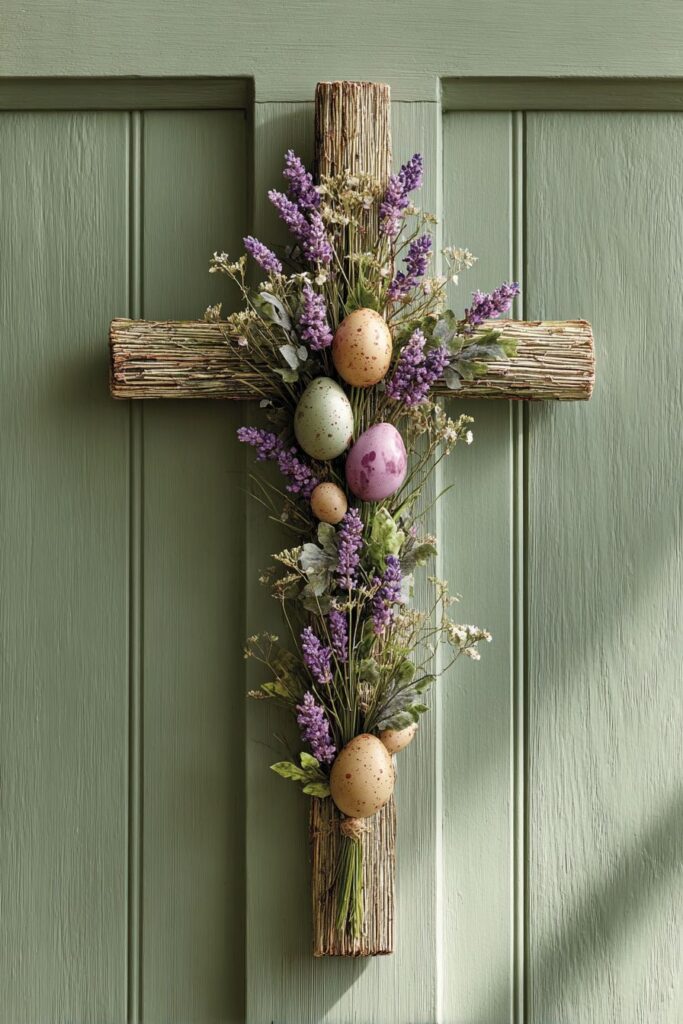
The organic, garden-inspired aesthetic feels achievable and authentic rather than overly designed or commercially produced. This accessibility makes the decoration particularly appealing—viewers can imagine creating something similar themselves using materials gathered from their own gardens or local landscapes. When displayed on a sage green painted door, the natural birch branches and botanical elements create beautiful tonal harmony. The soft green backdrop enhances the natural wood tones and complements the purple lavender, creating a cohesive color story that feels fresh and spring-like.
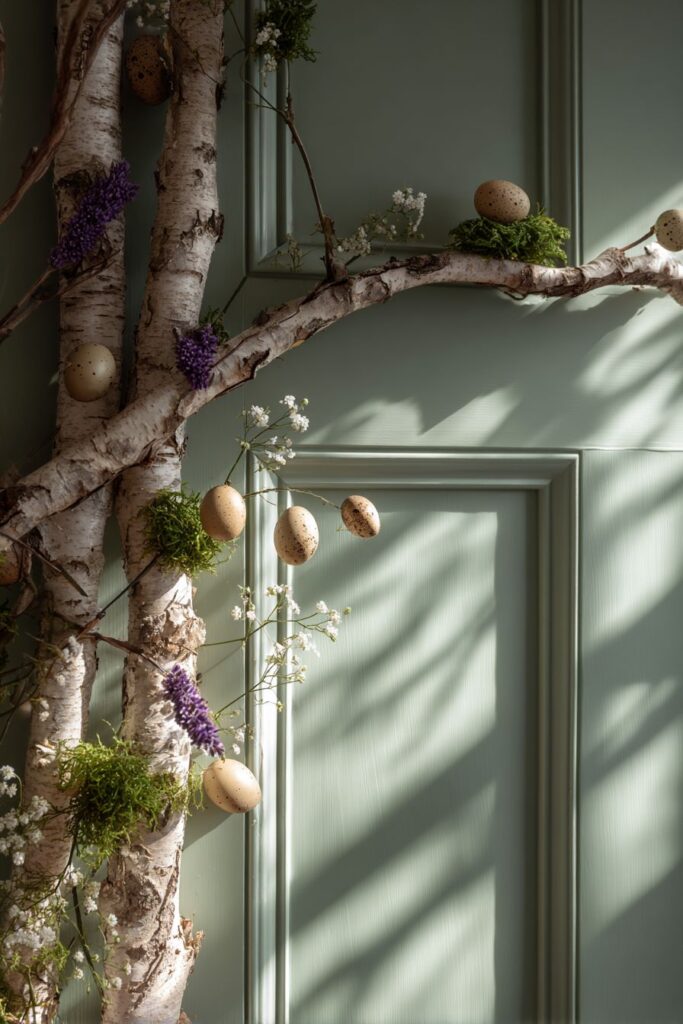
Interior design photography with wide-angle perspective captures the artistic arrangement in its entirety, revealing how the lattice pattern creates visual interest through repetition and geometry. Natural morning light filtering through creates dappled shadows that highlight the organic textures of wood, flowers, and natural eggs. This authentically achievable spring display demonstrates how thoughtful arrangement of natural materials can create sophisticated design that celebrates both Easter and the broader beauty of spring’s arrival.
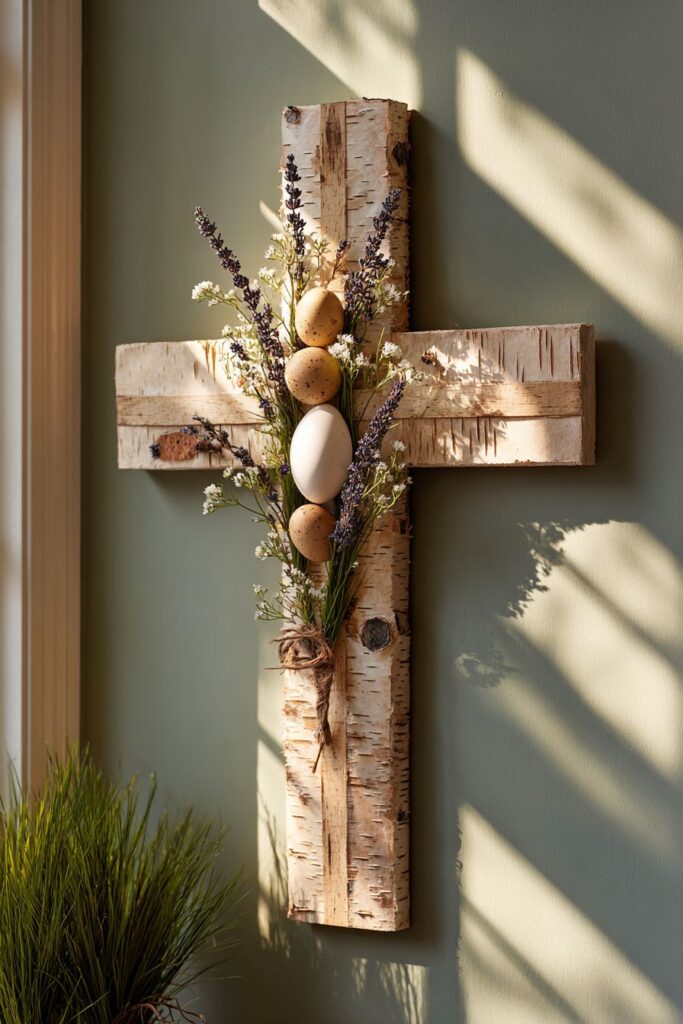
Key Design Tips:
- Select birch branches of similar diameter for consistent lattice pattern
- Wire branches at intersection points for secure cross-hatch structure
- Tuck fresh lavender stems into lattice gaps, wiring only at key attachment points
- Position quail eggs in natural-looking clusters as if discovered in nature
- Spray completed arrangement lightly with water daily to maintain lavender freshness
Why These Easter Door Decoration Designs Are The Best
These twenty Easter door decoration concepts represent the finest approaches to seasonal decorating because they honor both aesthetic excellence and practical execution while celebrating the diverse range of personal styles that make homes unique. From the handcrafted grapevine wreath adorned with pastel silk florals that brings traditional Easter charm to modern front doors, to the sophisticated monochromatic white tonal wreath that demonstrates how limitation inspires creativity, each design offers something exceptional for discerning homeowners seeking to elevate their seasonal decorating beyond generic commercial options.
The best Easter door decorations successfully balance seasonal appropriateness with design sophistication, ensuring that your entrance celebrates the holiday without sacrificing your home’s overall aesthetic integrity. The modern farmhouse white-washed wooden egg garland exemplifies this principle perfectly, bringing Easter recognition through symbolic eggs while maintaining the clean lines and neutral palette that define contemporary farmhouse style. Similarly, the contemporary geometric wire frame wreath proves that Easter decorations can embrace modern design principles, using architectural forms and monochromatic palettes to create seasonal impact that appeals to design-conscious homeowners who might otherwise shy away from traditional holiday decorating.
These designs excel because they demonstrate mastery of fundamental design principles including color theory, texture layering, and spatial composition. The traditional pastel flower wreath with ceramic bunny shows expert color coordination, using harmonious shades of peach, mint green, and butter yellow to create cohesive impact, while the cottage-style weathered basket arrangement demonstrates sophisticated texture layering through the combination of distressed wood, silk flowers, delicate gingham ribbon, and trailing jasmine vines. The living succulent and moss wreath takes design excellence further by incorporating sustainability and authentic living materials, creating a decoration that grows more beautiful over time rather than degrading.
Material selection plays a crucial role in these designs’ superiority, with each decoration carefully considering both aesthetic impact and practical durability. The rustic twig and birch bark wreath celebrates natural materials in their authentic state, using organic elements that withstand outdoor conditions while providing genuine textural interest. The elegant hydrangea wreath with pearl-finish eggs demonstrates how premium materials like preserved hydrangeas and lustrous ornamental eggs create upscale impact worthy of formal homes. Even playful designs like the whimsical carrot-shaped door hanger show material thoughtfulness, using sturdy orange burlap that maintains its shape and vibrant artificial flowers that won’t fade in spring sunlight.
These Easter door decorations represent the best because they offer remarkable versatility across home styles, architectural periods, and personal aesthetics. The vintage-inspired preserved flower wreath feels perfectly at home on a weathered cottage door but could equally enhance a renovated historic home, while the sleek single statement peony wreath suits minimalist modern architecture yet could provide refreshing simplicity for a traditional home seeking contemporary update. This adaptability ensures that regardless of your home’s style—craftsman, colonial, contemporary, farmhouse, or eclectic—you’ll find inspiration that feels authentically suited to your space rather than generically seasonal.
The practical execution of these designs sets them apart from purely conceptual decorating ideas that look beautiful in photographs but prove challenging to create or maintain. The nested egg basket with fresh tulip accents provides clear guidance on combining elements for balanced composition, while the asymmetrical eucalyptus swag demonstrates how to create dynamic arrangements without symmetrical precision. Each design includes thoughtful consideration of attachment methods, weather resistance, and maintenance requirements, ensuring that your beautiful Easter door decoration remains stunning throughout the season rather than deteriorating after the first spring rain.
These twenty designs excel at creating emotional impact and meaningful connection to the Easter season beyond surface-level decoration. The burlap bunny silhouette with twig wreath brings innocent charm that delights children while maintaining design integrity that appeals to adults. The natural birch branch lattice with garden elements connects Easter decorating to broader spring celebration, acknowledging the season’s renewal beyond religious or commercial aspects. The tiered basket vertical display adds conceptual depth through its organizational approach, transforming functional storage principles into decorative innovation that engages both visual and intellectual appreciation.
Color palette sophistication distinguishes these superior designs from generic Easter decorations that rely on overly bright, commercially saturated hues. The pastel ombre cascading egg display demonstrates expert color gradation, creating sophisticated tonal transitions that feel intentional and refined rather than randomly assembled. The monochromatic white tonal wreath pushes color restraint to its extreme, proving that limitation can create striking impact when executed with attention to textural variation and surface treatment. Even designs embracing fuller color ranges, like the abundant mixed bloom spring wreath, show careful coordination within their chosen palette, selecting varying shades of pink and white that work harmoniously rather than competing for attention.
The architectural awareness demonstrated in these designs ensures they enhance rather than conflict with their door settings. Each decoration considers its backdrop—whether navy blue colonial door, weathered grey wooden door, or modern white entrance—creating color relationships and scale proportions that complement the architecture. The rustic wooden welcome sign with fresh greenery acknowledges its stained wood door context by echoing warm tones and natural materials, while the contemporary geometric wire frame wreath responds to its modern grey door with complementary materials and restrained palette. This thoughtful integration transforms decoration from applied ornament into cohesive design element.
These Easter door decoration designs represent the pinnacle of seasonal decorating because they combine aesthetic excellence, practical execution, emotional resonance, and architectural awareness while offering remarkable diversity to suit every style preference and home type. They prove that Easter decorating can be sophisticated without being stuffy, playful without being juvenile, traditional without being dated, and modern without being cold. Whether you’re drawn to the romantic cottage aesthetic of overflowing flower baskets, the clean sophistication of monochromatic palettes, the organic beauty of living succulents, or the whimsical charm of carrot-shaped hangers, these designs offer inspiration that elevates Easter door decorating from seasonal obligation to genuine design opportunity that celebrates both the holiday and your unique personal style.
Conclusion
As we’ve explored these twenty exceptional Easter door decoration concepts, from handcrafted grapevine wreaths adorned with pastel silk florals to innovative living succulent arrangements and sophisticated monochromatic designs, one truth becomes abundantly clear: Easter decorating offers remarkable opportunity for creative expression that goes far beyond simple seasonal obligation. Each design we’ve examined demonstrates how thoughtful material selection, color coordination, textural layering, and architectural awareness can transform your front door into a welcoming statement piece that celebrates both the Easter holiday and your unique design sensibility.
The key takeaway from this comprehensive exploration is that successful Easter door decorations balance seasonal appropriateness with personal style, creating displays that feel authentic to your home’s aesthetic while honoring the spring celebration. Whether you’re drawn to traditional pastel palettes or contemporary monochromatic schemes, rustic natural materials or elegant refined elements, playful whimsical motifs or sophisticated minimalist statements, there’s an approach that will resonate with your vision. The most important element in any Easter decoration isn’t following trends or replicating magazine-perfect displays, but rather choosing elements that bring you joy and reflect your personality.
As you consider implementing these ideas in your own home, remember that the most successful decorations often combine inspiration from multiple sources, adapted to suit your specific door style, architectural context, and personal preferences. Don’t hesitate to experiment with unexpected material combinations, adjust color palettes to complement your home’s exterior, or scale designs up or down to suit your space. Easter decorating should be an enjoyable creative process that welcomes spring to your doorstep while showcasing your individual style. We encourage you to take these concepts as starting points, allowing your creativity to flourish as you craft an Easter door decoration that makes your home’s entrance uniquely welcoming and beautifully festive this spring season.
